June 29, 2018
The Honourable Ralph Goodale
Minister of Public Safety
House of Commons
Ottawa, Ontario
Dear Minister,
In accordance with section 192 of the Corrections and Conditional Release Act , it is my privilege and duty to submit to you the 45 th Annual Report of the Correctional Investigator.
Yours respectfully,
Ivan Zinger, J.D., Ph.D.
Correctional Investigator
Table of Contents
Correctional Investigator's Message
1. Health Care in Federal Corrections
2. Prevention of Deaths in Custody
Special Focus: Investigation into the Riot at Saskatchewan Penitentiary
5. Safe and Timely Reintegration
Correctional Investigator's Outlook for 2018-19
Ed McIsaac Human Rights in Corrections Award
Annex A: Summary of Recommendations
Responses to the 45 th Annual Report of the Correctional Investigator
CORRECTIONAL INVESTIGATOR'S MESSAGE
Photo of Dr. Ivan Zinger,
Correctional Investigator of Canada
The degree of civilization in a society can be judged by entering its prisons.
- Attributed to Fyodor Dostoyevsky (1862)
As I start the first year of a five-year appointment, it is perhaps expected that I would provide some level of detail on the approach and direction I intend to take in my role as Correctional Investigator of Canada. It is my belief that transparency in corrections leads to greater accountability, better performance and improved public safety results. Under section 180 of the Corrections and Conditional Release Act , I am required to provide notice and report to the Minister whenever the Correctional Service of Canada (CSC) does not, in my opinion, adequately respond to the findings and recommendations of my Office. As I read it, this section of the legislation is not optional.
As such, and in the spirit of openness and transparency, this past year I notified the Minister on three separate occasions on the inadequacy of CSC's responses to my recommendations:
- The Services response to Fatal Response: An Investigation into the Preventable Death of Matthew Ryan Hines , tabled as a Special Report to Parliament on May 2, 2017.
- The Services response to Missed Opportunities: The Experience of Young Adults Incarcerated in Federal Penitentiaries , released on October 3, 2017.
- The Services response to my 2016-17 Annual Report, released on October 31, 2017.
In all three instances, the Services initial response was deemed deficient. Though I did subsequently receive a second, more positive response to the Matthew Hines investigation and report, it appeared to have come only after interventions of the Minister's Office and Departmental officials. With respect to Missed Opportunities , CSC rejected the underlying finding that younger people in federal prisons should be treated differently. CSC's responsiveness to a number of other recommendations made in last years Annual Report remains a "work in progress".
Photo of an Institution entrance
It is especially concerning when the Service fails to respond to recommendations issued by my Office ( Missed Opportunities ) or dismisses the Office's initial findings (Saskatchewan Penitentiary riot). It is even more perplexing when CSC initiates its own consultation and review after the Office has already investigated and reported on the matter (Secure Units for women offenders). Not surprisingly, progress appears stalled, stuck or even regressive in some highly visible areas of correctional practice:
- Management of maximum security women at the Regional Women's Facilities.
- Indigenous corrections (influence of Aboriginal-based street gangs in prison; not enough community bed space, facilities and services operated by Indigenous communities for Indigenous offenders).
- Health care (clinical independence of health care providers; alternatives to incarceration for complex needs cases; models of care and support for elderly and aging, geriatric, palliative and terminally ill prisoners).
Needless to say, 2017-18 presented its share of challenges. I welcome and look forward to the opportunity to working with a newly appointed Commissioner of Corrections. Leadership renewal at the very top of the agency anticipates a change in perspective and direction. A new leader could be expected to restore focus and commitment on the essentials of what might be called a "back-to-basics" approach to corrections. In that light, it is important to recall that the term corrections derives from the Latin verb "corrigere" , which literally means "to make straight, bring into order". At its most basic level, the purpose of corrections is to "correct". Experience tells us that understanding human behaviour, much less correcting it, is a complex, challenging and uncertain endeavour.
At the organizational level, the ultimate goals of corrections are offender rehabilitation and safe, gradual and supervised return to the community. Correctional performance is most often measured by recidivism, or the rate of reoffending and readmission to prison on a new sentence. Research tells us that gradual and structured releases from minimum security facilities produce better public safety outcomes than releases from higher security or abrupt releases at later or end stage of the sentence. While I would like to report on current recidivism rates for federal corrections as a performance measure, there is currently no regularly maintained database tracking any new offence after warrant expiry. CSC tracks the proportion of offenders who are returned to custody on a new federal sentence. On this measure, offenders appear to be returning to federal custody less often (18% in 2001-02 versus 16% in 2011-12), though readmission remains elevated for Indigenous people at 23.4%. Although valuable and trending in the right direction, these indicators do not include provincial and territorial convictions (less than two years), which account for the vast majority of adult convictions.
In 2003, Public Safety Canada published a study looking at any new criminal convictions (including provincial and territorial records) resulting in a return to provincial or federal custody. It found that the two-year reconviction rate for federally sentenced offenders released in 1994-95, 1995-96, and 1996-97 was 42.5% overall 42.9% for men, 27.5% for women and 56% for Indigenous men. The current national base recidivism rate is simply not known. After decades of experience with research and performance measurement in the field of corrections and criminal justice, Canada still lacks a robust, regularly maintained, national recidivism database. Although it may seem unusual to make recommendations in my opening message, given the Government of Canadas commitment to track performance and effectiveness of its various departments, I offer the following:
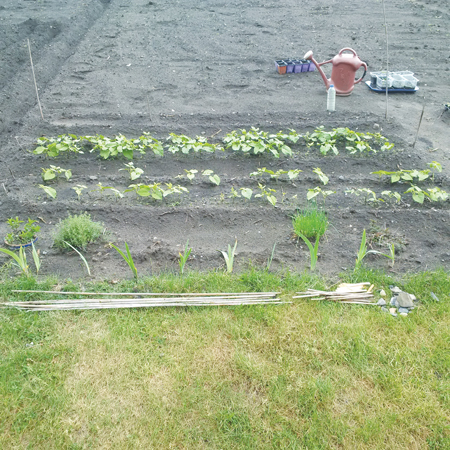
Photo of a section of garden from the horticultural program
- I recommend that Public Safety Canada develop a nationally maintained recidivism database that links federal, provincial, and territorial jurisdictions. This database should publicly report on reoffending before and after warrant expiry dates (WED), for both violent and non-violent offences, and should include post-WED follow-up periods of at least two and five years.
For a new leader, it is also important to recall that the Correctional Service is a public service, one that is dedicated to providing support, assistance and services to federal offenders, their communities and Canadians. As part of the criminal justice system, the function of corrections is sentence administration. Ultimately, it is the courts that decide who is sent to prison and for how long. CSC's job is to decide how best to manage that sentence. Corrections is not law enforcement or policing. In a free and democratic society, the deprivation of liberty is the punishment. Offenders are sent to prison as punishment, not for punishment. In practice, offenders retain all rights, liberties and freedoms voting, religious practices, expression except those that are necessarily restricted as a consequence of the sentence. Corrections requires, but is not limited to safe and secure custody. The point is not to make model inmates; it is to mold better citizens by assisting those in conflict with the law to live a law-abiding life upon their return to the community.
Photo of an Infirmary cell
Corrections is an area of public policy shaped and influenced by government direction. The history of corrections in Canada tends to move between and through cycles of reform, retrenchment and regression. Until recently, a "tough on crime" agenda dominated criminal justice policy in Canada. The politics behind this message stressed longer and harsher mandatory penalties, more austere and punitive prison living conditions, fewer opportunities for criminal justice diversion and restricted access to parole for offenders. Policy direction was given for correctional and paroling authorities to administer and adjudicate a federal sentence based on "the nature and gravity of the offence" and "the degree of responsibility of the offender". The least restrictive principle gave way to a more elastic concept "necessary and proportionate" measures. Though the "get tough" rhetoric played to political advantage, it led to some poor policy choices grounded more in ideology than in evidence. As a consequence, the number of federal inmates climbed to historically high levels, time spent behind bars before release increased, parole grant rates declined and prison living conditions deteriorated.

Photo of a Segregation range
Photo of an Inmate canteen
Under the previous government, CSC's community safety role was prioritized. Public safety was entrenched as the foundational or pre-eminent purpose of the federal correctional system, eclipsing other equally legitimate correctional purposes such as community reintegration, offender rehabilitation or even safe and humane custody. New funding favoured institutional over community corrections; practice tilted in a decidedly law enforcement direction. Today, the equipment, training, weapons, uniforms and deportment of front-line officers looks a lot more like policing or military than correctional services. There are, for example, more drug detector dogs working in federal penitentiaries than in the entire Canada Border Services Agency. In higher security institutions, primary duties are more frequently conducted through static measures like control posts, electronic barriers and surveillance cameras. Staff spend a great deal of their time monitoring inmate activity on screens. The distance and separation between keeper and kept has increased; the scope of dynamic interaction and opportunity for meaningful engagement outside of regular rounds and security patrols has narrowed significantly. The culture and infrastructure of corrections has hardened. These have not been progressive changes for the profession.
Photo of Yard fencing

Photo of a Sweat lodge in a maximum security yard

Photo of Corcan shops

Photo of Institutional libraries
While I recognize that safety and security of both staff and prisoners is paramount, beyond a certain threshold security measures can be counter-productive, hindering rehabilitation and reintegration efforts. Overly restrictive environments, too few programs, disruptions in routine, too much time locked up, poor and outdated infrastructure and even lack of attention to simple things like adequate food generate inmate dissatisfaction and dissension. If tension is allowed to build in a prison context it can easily boil over into acts of individual or collective violence.
Photo of Segregation "yards" at Matsqui Institution
My investigation into the deadly riot at Saskatchewan Penitentiary in December 2016, a full account of which is featured as a special focus in this report, is a case study in prison violence. It is equally a demonstration in public transparency and organizational accountability. The findings and conclusions of CSC's internal National Board of Investigation (NBOI) and report into the riot to the effect that it was a random, spontaneous, unpredictable and unforeseen event raised a series of red flags with my Office. These concerns coalesced around the adequacy and appropriateness of CSC investigating itself in the aftermath of a serious incident. That the Service could convene and investigate this incident, which left one inmate murdered, two seriously injured after being assaulted and several others sustaining injuries from shotgun pellets used to quell the riot, without mentioning or coming to terms with the fact that the ranges that incited or instigated riot were overwhelmingly occupied by Indigenous inmates (85%) is perplexing to say the least. More troubling perhaps, the silence on the Indigenous composition and gang dynamics behind the Sask. Pen. riot was allowed to stand uncorrected in the public record of these events.

Photo of an Institutional kitchen
The acts and omissions that led to these oversights serve as further reminders that the Service lacks sufficient and dedicated senior leadership (Deputy Commissioner level) to maintain sustained focus on Indigenous issues in federal corrections. This must be addressed. I have also recommended to the Minister of Public Safety that additional assurance measures are required to enhance the integrity and credibility of investigations mandated by law into serious incidents in federal prisons, inclusive of major disturbances (riots) resulting in injury or death, suicides in segregation and use of force interventions leading to serious bodily injury or death.

Photo of a Segregation cell with plexiglass covering
Photo of a Segregation range
Photo of Saskatchewan Penitentiary post-riot
Many of Canadas prisons, including Sask. Pen., which first opened its doors more than a hundred years ago, are outmoded or have long since outlived their original purpose. Some penitentiaries continue to carry forward an earlier punitive philosophy. Even the relatively new maximum security units tend to feature physical infrastructure and environments that are sterile, austere, barren and demoralizing. Opportunity to engage in meaningful or humane interaction is minimized by design and intent. Unfortunately, the elements of modern prison or public building design lots of light, single accommodation in rooms or cells that the occupant can open with a key, vibrant program and service spaces adapted to offender needs, access to actual outdoor greenspaces, even texture and colour have so far failed to be incorporated in the most "modern" of CSC facilities, even though these features are known to have a significant impact on rehabilitation, public safety, and staff and offender morale.
To give but one example of how prison design influences behaviour, during a visit to a maximum security unit this past winter I was shown an Indigenous sweat lodge that was entombed in snow, enclosed in a cage and covered over in razor wire. By all appearances, it looked as if the far corner of the desolate "yard" where the lodge was located had not been used in quite a long time (to be fair, it was the middle of a cold Prairie winter). That this situation shows little respect for Aboriginal culture and spirituality appeared rather obvious. Making the opportunity to participate in Indigenous spirituality part of the maximum security experience does not, in any way, mitigate its more dehumanizing and oppressive features. Caging or warehousing people has no redeeming public safety value and is contrary to effective corrections.
Correctional administrators and correctional officers know only too well that idle hands and minds behind bars can lead to trouble. Keeping inmates occupied and engaged in meaningful and remunerated work, upgrading their educational qualifications or having them participate in correctional programming contributes to a healthier, more productive and safer environment for staff and inmates alike. Though research and experience tell us that an occupied and engaged prisoner is less likely to cause trouble or be disruptive, I am often dismayed by how much time inmates seem to spend idle, locked up or alone in cells. It is no coincidence that the majority of security incidents occur in maximum security institutions; there are few programs, activities and interventions being offered in these settings. Further, we know that the majority of self-injurious incidents occur in the most isolated areas of the prison, namely, solitary confinement, observation and clinical seclusion cells. Too much idle time leads to incidents.
As noted later in my report, though most offenders do not have a grade 12 education or its equivalent when they enter prison, the wait list to get into programs can stretch exceedingly long; some serve their sentence and are back on the street without ever stepping into a classroom. As Victor Hugo is credited to have said: "He who opens a school door, closes a prison". I absolutely agree. And to be perfectly clear: cell studies are a poor substitute for the community of learning. CSC educators know that a prison classroom has a normalizing and civilizing influence; a prison only becomes a "school of violence" if there is little else to occupy a prisoners time. The Correctional Service can and should do more to bring the full reach of online learning platforms and enabling tools and devices (in-cell tablets, monitored email and Internet access) into prison. Public safety depends on it.
Corrections is not just about prisoners or prisons; careful attention and consideration must also be paid to staff. The lesson to emerge from maximum security Edmonton Institution this past year is that staff practices that undermine or degrade human dignity sexual harassment, bullying, discrimination can lead to a toxic work culture. A workplace that runs on fear, reprisal and intimidation is highly dysfunctional; it is the antithesis of modeling appropriate offender behaviour. Though I am encouraged by the establishment of a 1-800 line for CSC staff to report workplace harassment and wrongdoing, if staff disrespect, humiliate or disabuse each other one can only imagine how they might treat prisoners. It is no secret that some of the more problematic institutions in terms of lockdowns, incidents, use of segregation and overall compliance also have a checkered history of labour relations. I have no power or authority to investigate labour relations issues, but when staff actions or misbehaviour negatively impacts offenders it is perfectly within my remit to take appropriate action.
Throughout this reporting period, I am reminded that an outside human rights lens is sometimes required to challenge operational decisions. I would note that the removal of the outdoor cages in the segregation "yard", also at Edmonton Institution, (media reports referred to them as "dog kennels") occurred 24 hours after photos appeared on the front pages of Canadian newspapers.
I take seriously the statutory powers and authorities invested in the Office, including the right to enter and conduct inspections of federal penitentiaries, Footnote 1 not least because what happens behind prison walls remains largely hidden from public view. In function and design, prisons are a secretive and closed world, preoccupied as much with keeping prisoners in as they are with keeping everybody else out. Even in the most advanced democracies, the potential for abuse of state or correctional power remains. It is in that sense that I am directing my investigative staff to more rigorously apply the powers of inspection that Part III of the Corrections and Conditional Release Act confers. The Office's website now features a photogallery more fully depicting, warts and all, the everyday reality and experience of incarceration in Canada. Staff will also be given more practical training on how to conduct prison inspections health, hygiene and cleanliness being among the first priorities. These are some of the ways in which I intend to strengthen the quality, integrity and relevance of the Office's work and public reporting.
While external oversight provides public assurance, it does not guarantee that human rights violations are always detected, remedied or prevented. The rule of law that follows a person into prison must also be internalized. In nearly every aspect of correctional performance, CSC's internal monitoring mechanisms and review frameworks are nowhere as transparent, rigorous or effective as they should be. As a recent internal audit reminds once again, the internal inmate complaints and grievance system is broken, ineffective, dysfunctional, and, in my opinion, likely beyond repair or salvage. For grievances that reached national headquarters (NHQ) for a final decision, the average response time was 217 working days for "high priority" cases, and 281 working days for "routine priority" grievances. National reviews maintained the institutional decision in 97.9% of all cases. Chronic backlogs persist and even the unreasonably protracted response times laid out in CSC policy (not law) are not met 45% of the time. This is not a system that can be relied upon to provide assurance or feedback on CSC operations in real-time.
As my report on the Sask. Pen. riot demonstrates, there are systemic weaknesses in the means and manner in which the Service investigates itself in the aftermath of a serious incident. The findings, lessons learned and recommendations that emerge from its National Board of Investigation (NBOI) exercise rarely match the seriousness of the incidents under review major disturbances, assaults, riots, serious bodily injury and deaths in custody. These reports are not shared publicly; even internally, circulation seems unnecessarily restrictive.
In fact, the NBOI process, which is intended to promote wider learning, prevention and improvement through peer and investigative review, has become seriously compromised. Conclusions that reflect poorly on the Service are contained. Though findings from the NBOI process are not intended to be used in disciplinary proceedings, the bar that has been established to protect their integrity has now become a barrier to fully investigating the underlying causes of recurring incidents.
These issues are systemic. The impulse to contain bad news runs deep. Internal reviews, investigations and audits focus almost exclusively on policy compliance even the preventable deaths of Ashley Smith and Matthew Hines failed to raise issues of managerial responsibility or corporate accountability. At the national level, there are not enough senior management eyes looking at decidedly high-risk activities and interventions: use of force, complex mental health cases, suicidal and self-injurious behaviour, to name but a few. The Service continues to assume the risk of running prisons without 24/7 health care coverage. There are only a handful of resources at national headquarters dedicated to conducting national-level reviews of use of force interventions. It is not clear how or if CSC leadership can be assured that the more than 1,200 recorded use of force incidents that occurred last year were all managed lawfully, in accordance with principles of proportionality, restraint and necessity.
It seems to me that an incoming Commissioner has cause to be concerned about the effectiveness of CSC's internal monitoring and performance mechanisms, including the capacity of the Service to implement lessons learned and sustain corrective actions arising from internal audits, reviews, evaluations and investigations.
- I recommend that the incoming Commissioner of Corrections initiate a prioritized review of the effectiveness of internal monitoring and performance mechanisms, inclusive of use of force reviews, the National Board of Investigation process, inmate complaint and grievance system, staff discipline, audits, evaluations, communications and public reporting functions.
As the final part of my now admittedly long message to a new Commissioner, I would emphasize that correctional practices, services and programs must be respectful of and responsive to the needs of diverse groups. The face of corrections continues to diversify and evolve. This diversification is largely attributable to the sustained decline in the proportion of Caucasian offenders, which is more than matched by new and returning admissions to federal custody of Indigenous people. Today, a little over 50% of the inmate population is Caucasian, an overall numerical decline of 20% since 2009. This decline reflects falling serious crime rates, and mirrors trends and demographics of a majority society that is aging. At the same time, parole grant rates are trending upward, recovering from a period of long and steep reversal under the previous government. Fewer admissions to custody and more releases from prison would suggest that the corner on the "lost decade" may have finally been turned. Except for increases in Indigenous people and federally sentenced women, these are largely positive indicators.
Fortunately, the legislative tools required to manage diversity behind bars are in place, but they must be accessed and exercised as Parliament intended. The Corrections and Conditional Release Act makes specific reference in its principles to respect and fair treatment as well as prohibited grounds of discrimination. Special provisions are embedded in primary legislation for federally sentenced women and Indigenous offenders. Mental health, which sadly is a growing and prominent feature of prison life, was added in 2012 as a specific group requiring extra attention and protection. The Canadian Human Rights Act was also recently amended to include gender identity and gender expression as prohibited grounds of discrimination. In the reporting period, the Service finally moved to replace discriminatory policy and practices that prohibited institutional placements based on gender expression rather than sexual identity.
There remain, of course, some exceptions to the larger forces and drivers of correctional growth. In the Prairie Region especially, young Indigenous men and women continue to cycle through the system unabated. Though vast in geography and small in population, the Prairie Region is leading the country in offender growth. Not coincidentally, it is also the region that posts the highest proportionate rates of use of force, segregation, self-injurious and other incidents behind bars. Indigenous over-representation in corrections continues to set new historic highs now 28% overall and 40% for federally sentenced women. Indigenous offenders continue to serve proportionally more of their sentence in prison before release and in higher security settings than their non-Indigenous peers. They more often fail on conditional release and reoffend at much higher levels than their peers. These indicators and outcomes belie CSC's claim that it bears no responsibility for the morass of Indigenous over-incarceration. While it is true that the Correctional Service is at the receiving end of the criminal justice system, it serves no purpose to continue to deny factors that fall squarely within its remit to positively influence and change for the better.
The issues and themes that run through this report accountability, transparency, openness, leadership are informed by the visits, reports and investigations completed by my staff through the reporting period. Though my opening message is intended for a new Commissioner, the findings and issues collected and documented in this report come from the thousands of inmate complaints and contacts received and responded to each and every year by my staff without fail. Although I may sometimes express a difference in view or point of emphasis with the Service, my Investigators continue to be graciously received and well-served by Wardens and their teams all across this extraordinary land. Let me close this message on a positive note by saying how pleased I was to learn that the CSC has finally agreed to introduce an evidence-based program of safe prison needle exchange, a recommendation initially made by my predecessor, Mr. Howard Sapers, in his first Annual Report in 2003-04.
I feel privileged to lead and serve as Correctional Investigator. Regardless of who is chosen as the next Commissioner of the Correctional Service of Canada, I trust we can both learn and profit from the exemplary dedication of our respective staff members who serve all Canadians, especially and uniquely those who have been deprived of their liberty. When all is said and done, the OCI and CSC serve a common purpose. We should remain focused on that shared goal.
Ivan Zinger, J.D., Ph.D.
Correctional Investigator
June 2018
1. HEALTH CARE IN FEDERAL CORRECTIONS
Update on Medical Assistance in Dying (MAID) in Corrections
In my 2016-17 Annual Report, I reiterated concerns with CSC's draft Guidelines for Medical Assistance in Dying (MAID), which were provided to my Office for comment. My concerns can be summarized as follows:
- Policy and practice in implementing MAID legislation in federal corrections should be guided by compassionate and humanitarian interests.
- The decision to seek medical assistance in dying should be made, to the extent possible, while the palliative/terminally ill individual is in the community, preferably on parole by exception status (compassionate release).
- Consideration of the unique circumstances that incarceration imposes that limit an inmate/patient's option(s) to end life at a place and time of their own preference and choosing.
- Need for a Patient Advocate to protect inmate patient's rights and ensure they fully understand and meet the eligibility criteria of MAID.
On November 29, 2017, CSC promulgated internal guidelines governing how MAID applies to federally sentenced individuals. Footnote 2 I remain concerned that these Guidelines do not adequately meet the areas of concern or recommendations made in my 2016-17 Annual Report. Although the Guidelines state that MAID will be guided by "patient-centered care, compassionate and humanitarian principles", and assume that "the MAID procedure will be completed external to CSC", it is unsettling that an exception was included allowing the inmate/patient to request and receive the procedure in a federal correctional facility. In follow-up correspondence to the Commissioner (February 12, 2018), I stated that I simply cannot imagine a scenario where it would be considered acceptable to allow an external provider to end the life of an inmate in a federal penitentiary. The optics (and practice) do not seem right.
In response to my concerns, the Commissioner explained that:
- The decision to include an exception was made in order to "maximize" patient choice; and
- MAID providers have a "professional obligation" to ensure that the inmate patient's request is voluntary and informed before the procedure takes place.
Regarding the first point, prisons are environments where autonomy, free will and choice are restricted by the fact of incarceration. Ensuring that consent is informed and voluntary in such settings can be challenging. In a prison, compliance with authority is not only expected, but routinely compelled or enforced. It is in the context of incarceration and its inherent restrictions on choice that the existing Guidelines raise fundamental ethical and practical concerns. Issues of free, voluntary and informed consent must be front and centre of MAID governance in corrections; these rights must be acknowledged and respected.
As to the Commissioners second point, I have no doubt that the vast majority of health care staff both employed and contracted by CSC act with professional and ethical integrity in advocating for and carrying out their primary health care duties. This does not, however, absolve CSC from safeguarding the principle of clinical independence in the policy and rules that govern health care staff. These points are addressed later in this chapter. It is my belief that CSC should be removed from the position of being the enabler or facilitator of MAID. There should be no exceptions provided for or written into policy as it conflicts with CSC's mandate to preserve and protect life behind bars. MAID should only be performed by registered external health care providers and never in a facility under federal correctional authority. To the extent possible, a hastened death should be dignified.
To illustrate the issues at stake, the following case study examines the first case of a federal offender to receive MAID. It should be noted that the Service is not required, by law, to conduct an internal investigation (or mortality review) following a MAID procedure. I fail to understand the reasoning behind this exclusion, but unfortunately I have no authority to change the law that enshrines it. In my view, it does not rise to the same level of transparency and scrutiny that these issues attract in the rest of Canadian society and law. Notwithstanding, there are some clear learning points that emerge from the first case of MAID in federal corrections. These points are, by and large, informed by the unique status that federally sentenced individuals occupy in law.
Case Study
First Case of Medical Assistance in Dying in Federal Corrections
- The inmate was on palliative care for more than a year, suffering from a terminal illness.
- The Case Management Team started to work on a section 121 application for parole by exception (compassionate release) shortly after terminal diagnosis. The request was rejected by the Parole Board of Canada one year later.
- The inmate requested medical assistance in dying at a Regional Hospital under CSC's authority, with a physician who was under contract with CSC. It is unclear if the inmate chose MAID because he was refused compassionate release.
- Two evaluations took place, and the inmate met MAID criteria. The physician who conducted the evaluations was not under contract with CSC.
- A date was chosen by the inmate, and family members were permitted to visit him at the CSC Regional Hospital on a number of occasions in advance of the procedure.
- On the chosen day, the inmate was escorted to an external community hospital by two armed correctional officers in an adapted medical transport. The inmate was restrained. Once in the hospital room, the restraints were removed. The inmate was left in the room with pre-approved family members.
- According to CSC reporting, the officers providing security escort waited "at the back, near the entrance". (Note: the wording in CSC's report is not clear as to whether the officers stayed in the room or just outside the room).
- According to CSC, "the physician who performed the procedure, while under contract with CSC when he conducted the original assessment, was operating as an employee of the hospital in which the procedure took place, and not as a CSC physician".
Corrections and Conditional Release Act , Eligibility for Parole
Exceptional Cases
121 (1) [...] parole may be granted at any time to an offender
(a) who is terminally ill.
(b) whose physical or mental health is likely to suffer serious damage if the offender continues to be held in confinement.
(c) for whom continued confinement would constitute an excessive hardship that was not reasonably foreseeable at the time the offender was sentenced; or
(d) who is the subject of an order of surrender under the Extradition Act and who is to be detained until surrendered.
Exceptions
(2) Paragraphs (1) (b) to (d) do not apply to an offender who is
(a) serving a life sentence imposed as a minimum punishment or commuted from
a sentence of death; or
(b) serving, in a penitentiary, a sentence for an indeterminate period.
MAID Should be facilitated using section 121 releases
In cases of terminal illness where death is reasonably foreseen, Footnote 3 access to MAID would best be facilitated through section 121 or other conditional release mechanisms. End-of-life planning decisions, such as MAID, should ideally be made by parolees in the community, not inmates in a prison. Though CSC Guidelines for MAID state that all early release options are to be considered, none are actually elaborated. Compliance with organizational policy is undermined when directions are not clearly and explicitly stated. This is perhaps the reason why CSC saw the need to write into policy that MAID could be "exceptionally" provided in a federal facility. I would argue, however, that unintended negative impacts are far more likely if exceptions for the delivery of MAID in federal institutions are written into policy, than if early release mechanisms for terminally ill inmates were more clearly articulated and actively monitored.
 &
&
Photo of a Health care center

Photo of a Walking cane
As CSC's latest Annual Report on Deaths in Custody 2015/2016 (November 2017) affirms, Footnote 4 section 121 release by exception applications are under-utilized, often denied, and rarely successful even though many terminally ill individuals subsequently end up dying in a federal facility. Recent Canadian-based research has clearly demonstrated that, despite the aging and increasingly chronically ill populations behind bars, compassionate releases have barely been used, and even more exceptionally on humanitarian grounds. Footnote 5
Inmates offered s. 121 releases who subsequently died of natural causes while incarcerated (2009/10 2015/16)
Notes:
1. The numbers reported above exclude unexpected deaths.
2. There were 254 natural deaths in federal custody from 2009/10 to 2015/16.
3. The actual number of successful s. 121 releases during this period is not known.
Bill C-14 was intended to reduce suffering and increase the dignity of end-of-life care. CSC would be better positioned to achieve this objective through advancing section 121 "parole by exception" release planning and ensuring applications to the Parole Board of Canada are completed in the timeliest manner possible. Though release decision making is clearly outside the scope of CSC's jurisdiction, terminally ill individuals should not have to die in prison simply because their cases were not processed or brought before the Parole Board in a sufficiently complete or timely manner. If capacity in the community to manage a terminally ill or palliative patient is lacking, then CSC should engage with external service providers and reallocate funds that would otherwise be spent on unnecessary (and costly!) incarceration. If CSC were to ensure that capacity was available, the Parole Board of Canada would be in a better position to support a release plan that would allow the individual to serve the remainder of their sentence with dignity in the community.
I make the following recommendations:
- I recommend that there be no exceptions written into or provided for in CSC policy allowing MAID to take place in a facility under federal correctional authority or control. Internal policy should simply state that a request for MAID from a federal inmate who is terminally ill will be evaluated on a case-by-case basis.
- I recommend that, in cases of terminal illness where death is reasonably foreseen, there should be proactive and coordinated case management between CSC and the Parole Board of Canada to facilitate safe and compassionate community release in the timeliest manner possible.
- I recommend that the CSC develop arrangements with external hospice and palliative care providers in each Region to ensure adequate and appropriate bed space is in place to release palliative or terminally ill patients to the community.
Clinical Independence and Prison Health Care Governance

Photo of a Walker
I have previously discussed my position on clinical independence and the mixed or "dual loyalties" that health care providers constantly face working in a correctional health care context. Footnote 6 As the MAID discussion illustrates, there are ethical, organizational, operational and administrative issues that must be considered in ensuring no undue interference with the task of advocating for and protecting the physical and mental health care of inmate patients. It is important to recall that the "sole task of health care providers in correctional settings is to provide health care with undivided loyalty to the patient's, with unrestricted clinical independence, acting as the patient's personal caregiver without becoming involved in any medical actions that are not in the interest of the patient health and well-being". Footnote 7 These areas are not as well-articulated, grounded or protected in CSC health care administration, policy and governance structures as they should be.
Photo of a Health care sign
There are many areas of correctional health care practice that give rise to clinical role conflicts or ethical dilemmas, where clinical independence and professional autonomy may be impaired or impeded, or where health care providers may feel compelled to follow correctional authority rather than health care rules. Some practical examples of dual loyalties of health care staff include:
- Assessing inmates as medically or mentally (un)fit to participate in work or to extend solitary confinement placements, either for disciplinary or administrative purposes.
- Applying, removing, adjusting or monitoring physical restraints to prevent self-injurious behaviour.
- Conducting body cavity searches where there are no medical indications for such actions.
- A restrictive National Drug Formulary that may limit physician prescribing and treatment options.
- Informed versus implied or compelled consent to treatment.
- Post-use of force health care assessments.
The issues of concern here relate less to health care professionalism/performance and more to the governance of health care staff. The fact of the matter is that CSC health services are not fully independent or separate from the rest of the organization. Health care personnel working in federal penitentiaries are employed by CSC not the Health Ministry. This situation necessitates robust accountability and rigorous oversight duly exercised at the national level. A recent article clearly sets out the stakes and interests at play, in the international and domestic contexts:
Clinical independence is an essential component of good health care and health care professionalism, particularly in correctional settings...where the relationship between patients and caregivers is not based on free choice and where the punitive correctional setting can challenge medical care. Independence for the delivery of health care services is defined by international standards as a critical element for quality care in correctional settings, yet many correctional facilities do not meet these standards because of lack of awareness, persisting legal regulations, contradictory terms of employment for health professionals, or current health care governance structures. Footnote 8
The crux of the matter boils down to the fact that role conflicts and misunderstandings between health care and custodial staff are common and everyday occurrences. Examples abound: population movement schedules determine health care clinic hours; when or if an inmates medical escort takes place is dependent on staffing levels; who provides care or how it is provided in a prison setting is not a matter of patient choice.
Photo of a Counselling/interview room
in maximum security

Photo of a Wheelchair accessible cell and Photo of a Health care unit
In my last Annual Report (2016-17), I called on the Service to conduct a compliance review of its health care services, policies, practices and procedures against the most widely respected and comprehensive collection of international prison human rights standards, the revised United Nations Standard Minimum Rules for the Treatment of Prisoners (now known as the Mandela Rules). The Mandela Rules state that clinical decisions may only be taken by the responsible health-care professionals and may not be overruled or ignored by non-medical prison staff. Though a review of the Mandela Rules was purportedly conducted and completed, in response to an Office request for an update, CSC provided no documentation, report or findings to corroborate its claim that CSC health care services are compliant with the Mandela Rules. Saying or believing that the Service is compliant with domestic or international rules and standards is different from demonstrating it. As with many other activities within CSC, transparency would go a long way towards ensuring that health care standards behind bars are demonstrably met.
Best Practice Peer Offender Prevention Service (POPS)
- The Peer Offender Prevention Service (POPS) was created at Stony Mountain Institution (SMI) in December 2009 in response to the deployment of the Institutional Mental Health Initiative. It is a confidential, peer-based program that provides SMI with comprehensive crisis intervention, 24 hours a day, 7 days a week.
- POPS is offered throughout the institution, servicing segregation, all three levels of security (minimum, medium, maximum) and all sub-populations. At any given time, SMI has three to four offenders (typically "lifers") occupying a POPS peer support role.
"It's a great opportunity for me as a POPS to be called to different situations involving inmates, who are at a loss and need somebody to speak with. When they talk, sometimes there's a connection, a bond, and we can discuss the situation and make them feel at ease."
- Testimonial
- Training for POPS is facilitated by a range of community-based agencies and has a wide focus, including anxiety, depression, suicide prevention, general mental health, trauma, etc.
- By offering a credible and reliable response for offenders requiring both temporary and on-going supports, POPS assist institutional clinicians and operational staff.
- POPS has helped minimize attempts of self-harm and their engagement has assisted vulnerable offenders to remain in general population.
The Service has recently established a National Medical Advisory Committee comprising, among others, CSC's Senior Medical and Psychiatry Advisors, as well as other senior administrative personnel. The Committee brings to life the challenges facing correctional health care professionals vis--vis their operational and administrative counterparts. Given that the Service relies on contracted medical staff to provide services, bringing together a body of health care professionals from a range of disciplines at all levels within the organization is an important initiative. It is encouraging that the Committee is engaged in some of the more difficult physical and mental health care issues facing the Service:
- Responding to the needs of an aging inmate population.
- Suicide prevention and intervention strategy.
- National clinical seclusion policy.
- Revision of the mortality review process.
- Standards of care.
While there is no shortage of work for the Committee to consider, CSC would be encouraged, as a matter of priority, to advance and enhance clinical independence in prison health care, which could be expected to lead to more timely access and higher quality service delivery.
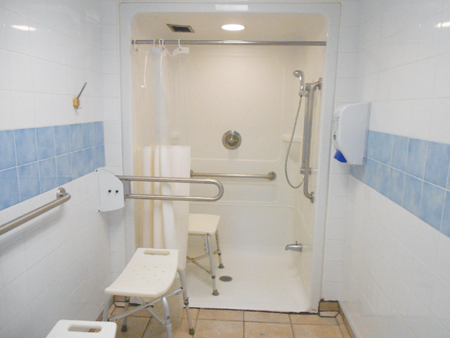
Photo of an Accessible shower
- I recommend strengthening CSC's health care governance structure through the following accountability and assurance measures:
- Complete separation of health care budgets from prison administration.
- More team-based and shared models of primary care, including closer monitoring, charting and follow-up of individual treatment plans.
- Practical and ongoing judgement-based and ethical training of correctional health care professionals.
- Coordination, oversight and monitoring of transitions in physical and mental health care (e.g. transfers between CSC facilities, releases to the community, transfers to external health care providers, transfers to and returns from Regional Treatment Centres).
- A system of regular peer reviews, medical chart audits and evaluations of medical staff conducted at the national level.
Independent Review of the Regional Treatment Centres

Photo of a Cell door
The Correctional Service of Canada operates five Regional Treatment Centres (RTCs), which primarily serve as inpatient mental health facilities or psychiatric hospitals. Today, there are fewer than 200 psychiatric hospital beds for men and 20 inpatient psychiatric beds for federally sentenced women. According to a recent external evaluation commissioned by the Service, Footnote 9 the overall ratio of clinical staff to psychiatric bed ratios (Psychiatrists, Psychologists, and Nurses) is well below expected or acceptable standards for inpatient psychiatric hospital care. The report found the following: 1 to 48.5 beds for Psychiatry; 1 to 32.5 beds for Psychology and; 1 to 51 beds for Nursing. According to the independent reviewer, these low staffing ratios to patient needs can result in the overuse of segregation and clinical seclusion practices.
Other findings of concern emerging from the external evaluation of the RTCs include:
- Correctional and mental health staff are lacking in the skill sets required to deal with forensic patients.
- The selection of security personnel (Correctional Officers) to work in the Treatment Centres seems unrelated to the needs of patients and is inconsistent with a psychiatric hospital setting.
- Physical infrastructure is "seriously problematic" and unsatisfactory for the delivery of mental health services.
- The assessment tools used to screen for mental health conditions and to admit patients to the Treatment Centers are regarded as limited or not clinically relevant.
- Growing problems with the accommodation of older ("geriatric") patients.
A number of other concerns were identified regarding training and recruitment practices in the Treatment Centers:
- The need to train correctional officers to enhance their ability to identify individuals suffering from mental illness to ensure they are not "lost in the system".
- Training for mental health staff "related to dealing with seriously mentally ill inmates in a secure environment".
- Recruitment of mental health professionals who have "undergone subspecialty training in Forensic Psychiatry", as they would be best suited to working in secure environments.
According to the review, because inmates are totally dependent on CSC for the basics of life, the Service is obligated to provide essential health care and reasonable access to non-essential mental health care. In the reviewer's assessment, the inadequate delivery of non-essential mental health care in CSC facilities is extremely likely to expose the Service to class action lawsuits and constitutes a Charter violation.
These and other findings generally reflect areas of concern identified by the Office over the years, though the external review contains some bold new proposals for reform. For example, the report recommends replacing the Treatment Centres with state-of-the-art, custom designed, inpatient facilities (though I am of the view that re-profiling existing resources and outsourcing the care of an additional two or three dozen complex needs men and women to external forensic hospitals is a more practical use of resources than new builds). The report cautions that, while these new facilities could be run by CSC, the care aspect should be left to the experts (in forensic psychiatry). The suggestion that acute or inpatient mental health care be outsourced should not be taken as a slight on the quality of personnel working within the Treatment Centres; it is rather the reviewer's assessment that the infrastructure, staffing and operational models currently in place do not adequately meet the complex needs of some patients. I concur with that conclusion, underscored and exemplified by the case below. Based on the findings of the Bradford report, and in addition to measures that remain outstanding on access to mental health care, I make this new recommendation:
- I recommend that CSC ensure security staff working in a Regional Treatment Centre be carefully recruited, suitably selected, properly trained and fully competent to carry out their duties in a secure psychiatric hospital environment.
Case Study
Managing Complex Mental Health Needs
Photo of a bed used as part
of the Pinel restraint system
The Office investigated an incident involving a dual status offender (a concurrent sentence that falls under the jurisdiction of both CSC and the province) at one of the Regional Treatment Centres. This patient requires a high level of care due to significant mental health issues, serial and escalating self-injurious behaviour. The patient attempted to self-injure while he was restrained in a four-point Pinel Restraint System (PRS) and Posey Mitts.* A Correctional Officer assigned to monitor the patient deployed pepper spray in response. The Office found that this use of force was inappropriate and unnecessary. An internal use of force review suggested that correctional staff were stressed and burned out from supervising the patient. Patients with this level of need should be treated in a facility designed for this purpose, where responses are health care-driven and mental health professionals conduct interventions and monitoring of patients instead of security personnel.
*Posey mitts are used to prevent further self-injury to existing wounds.
Patient Background
- Transferred over 20 times throughout sentence between provincial psychiatric institutions and CSC facilities.
- Subject to frequent internal disciplinary measures, and criminal charges (facing a longer sentence as a result).
- Over 200 documented incidents of self-injurious behaviour.
- Self-inflicted injuries often require surgical attention at an outside hospital.
- Subject to over 50 use of force interventions.
A Patient Advocate System for Federal Corrections
In my last Annual Report, I recommended the implementation of a separate, dedicated Patient Advocate system for federal corrections. This recommendation was made in context of medical assistance in dying, where an independent oversight mechanism could ensure that the inmate-patient's consent is unimpeded and voluntary. A Patient Advocate model, enabled to initiate and facilitate section 121 applications where appropriate, could help address many of the ethical, legal and human rights concerns that MAID raises in a correctional context.
The Commissioner's response to my latest MAID correspondence indicated that CSC plans to establish agreements with end-of-life care providers in each of the regions to act as independent Patient Advocates. I am encouraged by this initiative, although CSC has yet to provide specific detail about what is being proposed, or expected timelines. It is important to recall that the recommendation for a Patient Advocate model reaches far back in time before MAID. The Office's report entitled, Risky Business: An Investigation of the Treatment and Management of Chronic Self-Injury Among Federally Sentenced Women Final Report (September 30, 2013), first recommended that CSC should appoint an independent patient advocate at each of the five RTCs. This recommendation echoed a measure identified in the Ontario Coroner's inquest into the preventable death of Ashley Smith (December 2013). Specifically, the jury recommended that:
- CSC implement an independent Rights Advisor and Inmate Advocate (RA-IA) for all inmates, regardless of security classification, status, or placement. The institution will be responsible for advising all inmates of the existence of, and their right to contact, the RA-IA.
- That the RA-IA will be responsible for providing advice, advocacy and support to the inmate with respect to various institutional issues, including:
a) Transition into institutions;
b) Transfers;
c) Security classification, status, or placement;
d) Parole and release eligibility, including escorted and unescorted absences;
e) Temporary absences;
f) Use of restraints - physical and chemical;
g) Seclusion and segregation;
h) Complaints and grievances;
i) Consent to treatment and capacity to consent;
j) Consent to medication, including available alternatives;
k) Consent to disclosure of information; and
l) Institutional and criminal charges.

Photo of a Segregation range
The Service's uptake on accountability measures recommended by the inquest and this Office has been minimal, at best. There is currently a provision in Commissioner's Directive 709 (Administrative Segregation) outlining that, within 24 hours Footnote 10 of being admitted to administrative segregation, inmates with functional challenges related to mental health Footnote 11 will be informed of the right to engage an advocate to assist with the institutional segregation review process. There is no mention, in this policy or elsewhere, of who would perform the advocacy role let alone their degree of independence. In fact, CD-709 defines an advocate as a person who, in the opinion of the Institutional Head, is acting or will act in the best interest of the inmate. This is not independence of the kind that either the jury or this Office have in mind. The CSC has also been unable to demonstrate the effectiveness and frequency of use of its segregation advocacy provision.
It should be clear that, in the case of MAID, the obligation to ensure that the patient inmate fully understands, voluntarily requests and meets eligibility criteria rests with the medical or nurse practitioner. However, as previously noted, the issues involving free, voluntary and informed consent and clinical independence are magnified in a correctional setting and extend equally (if not more so) to offenders with mental health issues. Inmate patients often lack the ability to access timely and effective health and/or mental health services, which can negatively affect not only their well-being, but also their reintegration results. Therefore, CSC needs a Patient Advocate model to protect inmate patients' rights, assist the inmate patient to explore all available alternatives and to ensure they fully understand the implications of their decisions without compulsion.
- I recommend that independent Patient Advocates be assigned to each Treatment Centre, whose role and responsibilities include providing inmate patients with advice, advocacy and support and ensuring their rights are fully understood, respected and protected. The Patient Advocates could also serve as expert resources for other CSC facilities in each Region.
Update on Older/Aging Offenders
My Office, in collaboration with the Canadian Human Rights Commission, is actively investigating issues affecting older/aging offenders in federal custody and in the community. The Chief Commissioner and I expect our joint report to be publicly released in Fall 2018. In the meantime, the Service continues to consult and put together a framework that would promote wellness and independence of older persons in custody. Given that one-quarter of the inmate population is now aged 50 or older, this work needs to advance in a decidedly more prioritized manner. The needs and concerns of this growing, but still largely hidden and under-serviced population, are well known to CSC. It is time to finally move from consultation and discussion to implementation and action.
2. Prevention of Deaths in Custody
There were 55 deaths in federal custody in 2017-18. Most in-custody deaths last year (71%) occurred as a result of natural causes. The Prairie Region recorded the most deaths (16), followed by the Quebec Region (15). Two deaths occurred in the Regional Women's facilities. Both were from natural causes. Overall, Indigenous offenders accounted for 23% (13) of all deaths in custody, which is almost equivalent to their representation among the federal inmate population. The majority of Indigenous deaths were due to natural causes (8). Suicides accounted for 23% of all Indigenous deaths in custody in 2017/18, but only 8% of all deaths in custody among non-Indigenous inmates. Footnote 12
CSC's Annual Report on Deaths in Custody 2015/16
In November 2017, CSC released its third Annual Report on Deaths in Custody Footnote 13 . This report included statistical trends of deaths in custody since 2009/10. Among other results, this report substantiates many of the concerns previously brought forward by the Office, particularly with respect to aging/older inmates. Of all inmates who died in custody of natural causes between 2009/10 and 2015/16, most 91% (230 out of 254) were 45-years and older. Just over half were serving an indeterminate sentence. 50% were receiving palliative care at time of death. Average age of death from natural cause was 60 years.

Deaths in Custody 2017-18 (n=55)

Natural Death Sub-type 2009/10-2015/16 Pie Chart
*Also includes individuals where a specific natural sub-type was unavailable.
The report also provided details about the nature and cause of these deaths:
- 76% were related to either substance misuse or smoking;
- 49% had a mental health condition;
- 96% had a chronic health condition unrelated to the cause of death; and,
- 76% had between two and seven chronic health conditions.
Some concerning details were also reported with regard to non-natural inmate deaths (n = 132) between 2009/10 and 2015/16. For example, 71% (91) had an identified mental health disorder. 22% (28) were in segregation at the time of death. Nearly one third of suicides in segregation occurred in the Prairie Region.
As depicted below, deaths in segregation have steadily decreased since 2012/13. Footnote 14 Even still, 90% of all non-natural deaths in segregation since 2009/10 were the result of suicides (the remaining were largely due to overdoses). Suicides in segregation represent 37% of all suicides since 2009/10.

Notes:
1. Totals will not add to the total number of natural deaths as offenders may have multiple types of chronic health conditions.
2. Results are accurate as of July 31, 2017.
3. The conditions are not necessarily related to the cause of death.
Despite highly disaggregated reporting (which also included the days of the week and times of the day when deaths are most likely to occur), CSC continues to fail to identify or advance meaningful, evidence-based recommendations focused on prevention of deaths in custody. Beyond a very brief thematic analysis of Board of Investigation recommendations, and a short mention of compliance issues, the report does not address any learning points or strategies that would prevent future deaths in custody. Given that the average age of death due to natural causes is 60 years, it is surprising that there is no learning or strategies advanced as to how CSC could mitigate what amounts to premature deaths behind bars. Little seems to be known about chronic illness in correctional facilities other than that the list of co-morbid conditions at time of death is often extensive. The report does not mention or identify any health care related concerns or considerations. Given that this is now the third Annual Report on Deaths in Custody , I am curious to learn what CSC is actually doing with the statistical information it is amassing. I am specifically interested in the Service's answers to the following questions:
- How is the annual report on deaths in custody exercise informing policy, practices and organizational strategies to prevent deaths in custody?
- How does this reporting reflect or differ from the Independent Review Committees that periodically assess CSC's performance in preventing non-natural deaths in custody?
- What is specifically being done to prevent suicide risk in segregation?
- Why do these reports fail to specifically address, assess or identify lessons learned or recommendations from section 19 deaths in custody investigations?
- On the basis of what still amounts to tombstone reporting and some trend analysis, how can Canadians be assured CSC is doing everything possible to prevent deaths in custody?
- How is the issue of premature mortality in federal prisons being addressed?
- How is death in custody data informing a National Strategy for older/aging offenders?
In the absence of substantive answers to these questions, I conclude that this exercise is devoid of context. It is definitively not a lessons learned, performance assurance or corporate accountability record, which this Office has long called upon CSC to produce and release publicly.
Follow Up from Fatal Response
On May 2, 2017, the Minister of Public Safety tabled my Special Report to Parliament Fatal Response: An Investigation into the Preventable Death of Matthew Ryan Hines. Matthew's death in May 2015 followed multiple uses of unnecessary and inappropriate chemical and physical force at Dorchester Penitentiary. The impact and implications of this tragedy are still being felt across the Service, inclusive of ongoing criminal proceedings against two officers. Matthew's death was a watershed moment in the history of Canadian corrections. It prompted a rare admission from the Service acknowledging that its actions and omissions contributed to Matthew's death. The Commissioner's apology was sincere. Footnote 15
Though the source is largely unacknowledged, the Service continues to revise policy and operational frameworks in significant areas touched by Matthew's death:
- Use of force intervention, situation management and incident response (new Engagement and Intervention Model replacing the Situation Management Model).
- Reconciliation of staff discipline and internal investigative processes (ongoing).
- Information-sharing and disclosure practices with families following a death in custody.
- Use of force training materials and methods to prevent similar tragedies, including acknowledgement that officers assume responsibility and accountability for the safety and
well-being of prisoners under their escort. - Higher level of scrutiny of disciplinary decisions related to use of force incidents resulting in serious bodily harm or death.
- New research into the potential linkages between use of inflammatory agents and in-custody death.
- Clarification and consolidation of the officer in charge position (Sector Coordinator).
For Matthew's death to have enduring meaning, not all of these reforms are as ingrained or entrenched as they need to become. CSC culture remains highly insular. Learning and critical self-reflection do not come easily or naturally to an organization whose first instinct is to contain or control bad news. It is encouraging that Matthew's death continues to prompt internal calls for reform and change. I remain convinced that more accountability and transparency is the way forward. It bears reminding that the manner and circumstances of Matthew's death would not likely have ever seen the full light of day had my Office, the media and Matthew's family not reported publicly. This, too, is one of the unstated lessons emerging from Matthew's death.
3. CONDITIONS OF CONFINEMENT
Use of Force
In March 2018, CSC completed an audit of the Situation Management Model (SMM) which, up until recently, was the framework by which staff responded to a security incident. Footnote 16 What is important about this audit is that it was assessing compliance of the policy, response and review framework that governs use of force interventions in CSC facilities. The audit is forthright and frank. It suggests that there is no shortage of compliance issues when it comes to how force is used, monitored and reviewed within the organization. The audit essentially consolidates several areas for improvement that my Office has been raising for years based on our own use of force reviews, investigations and incident monitoring:
- The use of force policy framework does not clearly define who is in charge when multiple staff members are responding to an incident.
- Guidance material is not in place for use of force reviews.
- Training on the use of force module is not consistently provided to staff.
- Performance monitoring and reporting is insufficient at the local, regional and national levels.
- Intervention plans are not always documented as required.
- First aid and physical assessments are not always completed following a use of force incident.
- The focus of the use of force reviews is not consistent across the country.
- Compliance issues and corrective action information are inconsistently documented.
The audit's findings raise several concerns, though three areas in particular stand out:
- Beyond ad hoc reports, there is no regular use of force performance monitoring and reporting being conducted at the national level (only 5% of use of force incidents are subject to a random review).
- Corrective action is not always taken as required, nor is it effective.
- Use of force reviews are not being completed within the required timeframes.
Problems in these areas mean that the same compliance issues repeatedly identified by my Office failure to deploy a hand-held camera, proper completion of post-use of force health care assessments, quality and timeliness of use of force reporting continue to occur without proper or sustained correction. As the audit finds, delays in completing reviews and identifying compliance issues weaken internal oversight of use of force incidents and increases the risk that inappropriate responses are not identified or addressed in a timely manner.
The audit is particularly blunt concerning staff response and behaviour when compliance issues are identified:
The corrective action that was taken for these issues was generally limited to management sending emails to staff member(s) involved, or providing a reminder of policy requirements We found that this type of corrective action was utilized regardless of the significance of the policy compliance Management indicated that while corrective action is taken, it is not very effective in improving compliance or changing behaviours and responses Management at the local level indicated that they try to take corrective action that is geared towards educating staff rather than disciplining them. However, we found this action does not appear to escalate to disciplinary action if the same issues persist. Footnote 17
These findings reiterate a major concern identified in my investigation into the death of Matthew Hines that the corrective or disciplinary actions identified through internal reviews do not match the seriousness of the incidents under review. The two processes post-incident investigation and staff discipline are not, in any meaningful way, linked or reconciled. While the review process is supposed to play a key role in ensuring the Service adheres to principles of accountability and transparency, I would suggest that there is not near enough senior management attention and eyes on what is a decidedly high-risk activity. There are only a handful of resources at national headquarters dedicated to conducting national-level reviews of use of force interventions. Only 5% of all use of force interventions are subject to a random review at the national level. There is simply no guarantee that even the most egregious use of force interventions make their way up to the national level. It is far from clear how or if CSC leadership can be assured that the 1,345 use of force incidents recorded last year were managed lawfully, in accordance with the principles of restraint, proportionality and necessity.
For its part, the audit recommends corresponding action in each of the areas of deficiency identified:
- Clarify who is in charge of controlling a response to a security incident.
- Provide guidance material for use of force reviews.
- Provide staff training on the use of force module in the Offender Management System.
- Monitor and report on performance at the local, regional and national levels.
- Ensure intervention plans are documented as required by policy.
- Ensure post use of force first aid and physical assessments are completed.
- Ensure use of force reviews are completed within required timeframes.
- Clarify the focus and intent of use of force reviews.
- Ensure corrective actions taken are effective.
- Ensure compliance issues and corrective action are consistently documented.
Use of Force Coding Project Initial Findings
CSC is required to provide all use of force documentation* to the OCI for review. The Office has initiated a project to code all use of force incidents using a variety of indicators (i.e. type of force used, where the incident occurred, age and race of inmates involved and security level where incident occurred). For the 16-month period between October 2016 and February 2018, 1,914 use of force incidents were coded. Findings include:
- The Prairie Region accounted for the largest proportion of use of force incidents (33.4% or 641 incidents), followed by Quebec (21% or 402 incidents), Ontario (19.8% or 379 incidents), Pacific (14.3% or 274 incidents) and Atlantic (11.3% or 218 incidents).
- The Regional Psychiatric Centre (RPC) Prairies reported the most incidents (175), followed by Edmonton Institution (136), Ontario Regional Treatment Centre (124), Donnacona (123) and Kent Institution (114).
- Location of the incident:
- Most incidents occurred in maximum security (70.2%)
- 10% occurred in segregation
- 33% in a cell
- 20% on a range
- Demographic indicators:
- 10% of incidents involved one or more federally sentenced women.
- 8 incidents involved a transgender inmate.
- Most incidents involved an inmate 22-49 years of age. Approximately 9% involved an inmate 18-21 years of age and 8% involved an inmate 50 years of age and older.
- 47% involved at least one Indigenous inmate.
- 41% involved at least one inmate with documented mental health concerns.
- 13.6% involved a self-injurious inmate.
- 46% of incidents involved the use of inflammatory (pepper spray) or chemical agents.
- The deployment of the Emergency Response Team was identified in 7% of all incidents.
- In 62.4% of use of force incidents, CSC identified compliance issues related to the use of a camera usually related to the untimely deployment of a handheld video-camera.
* Documentation typically includes: Use of Force Report, copy of the incident-related video, checklist for Health Services Review of Use of Force, Officers' Statement/Observation Report, offender's version of the events and an action plan to address deficiencies.
Correcting these deficiencies is a tall order, especially considering that CSC's track record of fixing problems post-incident is not encouraging. With respect to use of force, it is compounded by the sheer volume, complexity and nature of the incidents. As my Office notes, over 40% of use of force interventions involve inmate(s) with a mental health issue identified or documented by the Service. 13.6% of use of interventions coded by my Office involved self-injurious behaviour; the overwhelming majority of these incidents involved the use of an inflammatory agent (pepper spray). Footnote 18
Engagement and Intervention Model
Office reporting confirms that fully one third of all use of force incidents in CSC facilities occur in cell. As CSC has acknowledged, where inmates are confined to a cell the situations in which such incidents occur may not pose an immediate risk or imminent threat or harm to either staff or inmate. Where the incident or situation occurs in contained areas, such as living units or cells, there may not even be the need to respond with force at all; certainly pepper spray should not be deployed as quickly or as pervasively as it has in the past. Risk assessment based on AIM principles A bility to carry out a threat; I ntent to behave or act in a specific manner; M eans to carry out or act on a threat has been lacking. Inflammatory agents (pepper spray) have been over-used and over-relied upon to induce or compel compliant behaviour, even when the risk is considered minimal. Verbal intervention skills and de-escalation techniques have been eroded or minimized.

Engagement and
Intervention Model (2018)
As use of force video recordings often depict, there can be a great deal of confusion during a use of force incident, especially when multiple staff members are called upon to respond. Up until recently, the policy framework failed to clearly define who should be in charge during these situations. By CSC's own admission, there has been an imbalance between security and health considerations. Incident management within CSC has been predominantly security-led and security-driven. Many of these issues lack of leadership and on-scene controller, multiple and unnecessary uses of pepper spray and failure to recognize and respond to a medical emergency in a timely and competent manner were in play in the events leading to the preventable death of Matthew Hines. My report called on CSC to immediately develop a separate and distinct intervention and management model to assist front-line staff in recognizing, responding and addressing situations of medical emergency and/or acute mental health distress. In response, two internal reviews the audit of situation management and the Security Branch's review and report on use of force within CSC Footnote 19 have come, more or less, to the same conclusion. Each confirms that a shift in response and behaviour in managing security incidents within CSC was necessary.
It is in that light that I am encouraged by the replacement of the previous Situation Management Model with the new Engagement and Intervention Model (EIM). It signals an important change in officer conduct and, just as importantly, a major shift in culture within CSC. Expectations that use of force situations will be managed with a heightened sense of scrutiny, diligence and enhanced review is welcomed by my Office. While it is still too early to determine if the new intervention model and attendant changes are having the desired impact or a sustained effect, the use of force intervention below contains case details eerily similar to those that led to the preventable death of Matthew Hines.
- I recommend that in 2018-19 CSC conduct an evaluation of its new Engagement and Intervention Model.
Case Study
Use of Force
- Following the activation of a cell alarm by an inmate in distress, correctional staff ordered that all inmates on the range return to their cells before they would respond to the alarm. Two inmates refused to lock up.
- Force was used on the two inmates, including physical handling and inflammatory agent (pepper spray), despite the fact that they were only passively resisting by refusing orders, and were not posing an imminent threat or risk of harm.
- Inflammatory spray was deployed to the facial area (inmate's mouth was open) within very close proximity (contrary to policy) and to the other inmate who was lying on his back and being physically restrained by officers. He was then rolled face down on the floor and handcuffed from behind where he remained for three minutes while an officer applied pressure to his back. Once lifted to his feet, he was escorted to the decontamination shower where he was left unattended (contrary to policy).
- Though correctional officers pass by the shower on a few occasions and appear to look in, they do not stop and only one seems to speak briefly to the inmate. More than 15 minutes elapse from when the inmate was checked to when he is found unresponsive and lying face down in the shower.
Special Focus
Investigation into the Riot at Saskatchewan Penitentiary
Introduction
On December 14, 2016, a major riot broke out in the medium security sector of Saskatchewan Penitentiary. There were 131 of 475 medium security inmates on five different general population ranges involved in the incident. During the course of the riot, two inmates were seriously assaulted and one was murdered. Six inmates were struck and injured by shotgun pellets used by the Emergency Response Team (ERT) to suppress the riot. The damage to government property, including renovations and updates, was extensive and estimated at $3.5M. The ranges that went up in riot were left uninhabitable, with 133 cells rendered unserviceable.
In the immediate aftermath of the riot, two Senior Investigators from my Office visited Sask. Pen. to assess the situation, validate access to physical and mental health care and collect initial feedback from staff and inmates. Preliminary findings were reported in the Office's 2016-17 Annual Report. Footnote 20 At the time that the Annual Report was drafted and subsequently tabled in Parliament (October 31, 2017), the Office did not have the benefit of the Correctional Service of Canada's (CSC) investigation into these events. A National Board of Investigation (NBOI or the Board) was convened by the Commissioner of Corrections on February 23, 2017. The Board's report was received by the Office on November 29, 2017.
Upon review, it was obvious that the Board's interpretation of these events differed significantly from the Office's initial review. As stated in the Office's 2016-17 Annual Report: the immediate triggering events of the Sask. Pen. riot appear to be related to unresolved demands regarding inmate dissatisfaction with food (shortages, replacement items, portion size and protein allotment), as well as perceived mistreatment of inmate kitchen workers (pay, hours, incentives) by CSC staff. In contrast, the Board found that the riot was a spontaneous and random event that could not have been predicted or prevented. It concluded that the riot was unrelated to food quantity or meal quality issues.
The two interpretations of the same events could not be more divergent. As a result, under the authority of section 172 of the Corrections and Conditional Release Act, on January 17, 2018, the Office formally requested all documentation reviewed and retained in the working file of the Board's investigation into the Sask. Pen. riot. The point of requesting this file was not to re-investigate these matters, but rather to examine the means, method and sources of information by which the Board came to its findings and conclusions, and to determine how and why they diverged from the Office's preliminary findings.
On March 21, 2018, in response to a recommendation made in the Office's 2016-17 Annual Report, the Correctional Service released a three-page document on its public website entitled Board of Investigation into the Riot at Saskatchewan Penitentiary Case Summary (Case Summary) http://www.csc-scc.gc.ca/publications/005007-0002-en.shtml.

Source: CSC, Case Summary (March 2018)
For reasons that are not quite clear, the public account ( Case Summary ) does not reflect or represent findings of the internal (National Board of Investigation) it claims to summarize. In stating that the Case Summary is based on facts from the Board of Investigation, the Office finds that the public version is misleading in a number of important respects. For example, in contrast to the Board, the Case Summary suggests that prison riots are far from spontaneous or random events; indeed, the public account suggests that the Service learned some important things about why riots occur and even how they might be prevented. The Board itself offered little to no insight on these points.
Although there are still some significant omissions (not the least of which is the fact that the ranges that went up in riot were overwhelmingly occupied by Indigenous inmates) and inaccuracies in the Case Summary , it is on balance a more credible account of why prison riots occur and what actually happened in the Sask. Pen. case than the Board's interpretation. While mainly an exercise in public relations and damage control in anticipation of my findings, the Case Summary better reflects initial media, spokesperson and this Office's reporting immediately following the riot. Footnote 21 That said, the two markedly different versions point to underlying transparency and credibility issues with respect to how the CSC investigates itself in the aftermath of a serious incident, and how the agency publicly reports on these incidents.
The Office decided to incorporate its review and report on these matters as a special focus in this year's Annual Report. This review serves as a case study in the appropriateness and adequacy of how CSC investigates itself in the aftermath of a serious incident. In conducting this review, the Office's aims were to identify and assess:
- gaps and omissions in the Board's account of how the Sask. Pen. riot started (precursors, catalysts and triggers);
- who participated in the riot and why; and
- what lessons and measures can be learned from these events to avert or prevent future incidents of this kind.
This report serves as the public record of what the Office found and the areas of improvement deemed necessary to ensure more transparency, accountability and credibility in how the federal correctional service investigates itself and publicly reports on serious incidents.
Though the level and degree of force used to suppress the riot were initially identified as areas of concern, the Office is satisfied that these issues were comprehensively and thoroughly reviewed. We note that there were no allegations of excessive force uncovered or disclosed, either by the Board or this Office. Accordingly, the Office did not review how the use of force response to suppress the riot, which included deployment of chemical agents, impact munitions and firearms, was managed by Sask. Pen. authorities.
Investigative Method

Photo of an Interview room
Though not an exhaustive list, the Board of Investigation documentation reviewed by the Office included interview notes taken by individual Board members; preventive security files; post-incident Officer Statement and Observation Reports (OSORs) filed by CSC staff members; Warden's situation report of the incident; minutes of management meetings; emails and correspondence exchanged between Board members and Sask. Pen., Regional and National authorities. The documentary review was complemented by a site visit to Saskatchewan Penitentiary in February 2018 by two OCI Senior Investigators. The Investigators gathered and reviewed additional information at the site level, and conducted a series of semi-structured interviews with inmates and staff. For the Office, it was important (and valuable) to gather inmate and staff testimonials because the Board interviewed only one inmate and relied mostly on Management's interpretation of events for its frame of reference. Additional interviews were conducted by phone, and, in some cases, in institutions or regions where offenders had been transferred or were living in the community.
As some of the events of December 14, 2016 were still under scrutiny by the criminal justice system, the Office took a number of measures to ensure the integrity of the ongoing police investigation was not compromised. The Office did not meet with or interview any inmate who was charged criminally or who might still be under police investigation. It should be made manifestly clear that the Office's review and report on these matters does not, in any way, excuse or condone the violence, loss of life or damage to government property that resulted from the riot.
At the outset, the Office wishes to commend and recognize the professionalism and collegiality of Sask. Pen staff. We acknowledge that it was not always easy to meet or accommodate the many requests and demands of the Office. The level of cooperation and collaboration received through some challenging and difficult times was very much appreciated.
Chronology of Key Events
This abbreviated chronology Footnote 22 is intended to orient readers in place and time to the key events leading up to the riot, which began at approximately 1:30 pm on December 14, 2016.
Thursday December 8, 2016
- A list of numerous issues involving food services and inmate working conditions in the kitchen are delivered to Management.
Friday December 9, 2016
- Inmate kitchen workers walk off the job in protest over scrambled egg portions served at the breakfast meal.
Monday December 12, 2016
- A meeting is held between Management and more than 40 inmate kitchen workers to resolve the ongoing kitchen dispute.
- General population inmates are refusing to attend school, work or programs in solidarity with the kitchen workers' protest. Footnote 23
- Later that day, the Warden has his own meeting with the same inmate representatives, who are instructed to come back with a more reasonable list of issues and demands.
Tuesday December 13, 2016
- The Warden's four key concessions to settle the kitchen protest and end the inmate strike are delivered to the inmate representatives.
Wednesday December 14, 2016
9:00 am - Inmate representatives turn down the Warden's concessions and raise new demands, including doubling of the meal protein allotment.
1:00 pm - Work up is called.
1:15 pm - Inmates on E1&2, E3&4, F1&2 and F4 ranges refuse to attend work and refuse to lock up.
1:20 pm - A contingent of officers is assembled to show presence on E3&4 ranges in an attempt to enforce the Warden's order for inmates to attend work and programs or lock up. A few minutes after Officers withdraw from E3&4 ranges, inmates are seen donning balaclavas and masks and the range camera is painted over. Visual observation is lost. Similar events take place on other implicated ranges (E1&2, and F4).
Riot begins at/around 1:30 pm.
1:55 pm - Crisis Negotiators begin making contact with implicated Ranges.
3:40 pm - The Deputy Warden reads the Riot Act Proclamation over the all-call system.
4:15 pm - F1&F2 ranges peacefully lock up.
4:35 pm - Emergency Response Team (Riot Squad) breach E3&4 range barriers and meet with serious resistance.
7:25 pm - The last of the implicated ranges is secured and the institution is deemed secure.
The Board's Random Event Theory
In the Executive Summary to its report, the Board of Investigation makes reference to random event theory Footnote 24 as a means to explain the major disturbance part of its mandate. Footnote 25 In an annex to its report, an abbreviated four-page literature review summarizes the major theoretical explanations for prison riots and their causes. According to the literature review, some researchers hypothesize that prison riots are random, unplanned, and spontaneously-initiated events that arise when a series of dysfunctional environmental factors are already present within an institution. When an unexpected or random incident occurs, it can quickly escalate out of control in an environment that is preconditioned to collective violence.
Although the literature review spends less than half a page summarizing the salient points of random event theory, the Board nonetheless concludes that the riot at Saskatchewan Penitentiary was consistent with research supporting the random event theory on prison riots. The Board claims that the Sask. Pen. riot was an unplanned and spontaneous event set off by series of events that could not have been foreseen. The Board found no indicators of increased tensions within the inmate population in the months before the incident. It found no population management issues and no inmate grievance and complaint-related issues that would have predicted the riot. Given that the riot was unplanned and spontaneous, the Board reasons that it could not have been predicted or prevented. As for the violence, the report explains: In the case of Sask. Pen. riot, the ongoing negotiations between management and inmates regarding work issues increased tension with some inmates, who spontaneously decided to threaten staff and damage government property, when work up was called and lock-up procedures initiated.
There is a certain, though confused, appeal to the Board's random event reasoning, mainly because it provides a convenient framework to help explain its near total lack of significant findings in areas such as incident pre-indicators, precipitating events, contributing factors, catalysts/triggers, lessons learned and prevention. It is not clear if Board members considered the implications of the rest of the literature review as it contains some important cautions that would seem to call into question its random event interpretation of the riot. As the review notes, the empirical research on prison riots is so mixed, dated and inconsistent that reliable conclusions should not (and cannot) be drawn from their findings. Furthermore, more research needs to be conducted to understand the complexities of prison rioting behaviour. The Office concurs.
The Board's explanation for the Sask. Pen. riot reads like theory trying to fit evidence. Curiously, references to the Board's theory are mostly, if not exclusively, confined to the report's Executive Summary; the remainder of the analysis is selective, superficial and not credible. An entire series of complex events, conflicted individual and group motivations, compelling inmate testimony and inexplicable violence are forced through a hypothetical lens that the Board's own review of causes of prison riots admits cannot possibly provide a sufficient explanation of why prison riots occur.
The Board's endorsement of random event theory and its conclusion that food quality or quantity played no role in the riot raises the possibility that its absence of findings in this area may have been pre-determined. In the immediate aftermath of the riot and well before the Board had even concluded its investigation, CSC consistently and repeatedly, both publicly and in high-level briefings with this Office, denied any association between food shortages/portion sizes and the Sask. Pen. riot. Footnote 26 The Board's interpretation of the riot spontaneous, unplanned and unpredictable meant that that the violence could not have been attributed to failure in CSC food services policy or any other CSC shortcoming. The random event interpretation seemed to give the Board license not to scrutinize Sask. Pen. authorities or call into question contested aspects of the Service's national food services modernization initiative. Footnote 27
In any case, the Board's conclusion that the riot was unrelated to food is not supported by the Office's preliminary and final reviews of these events, as well as inmate and some staff testimonials. Regardless of motivation or intent, the Board's random event explanation for the Sask. Pen. riot does not hold up under close or independent scrutiny. Simply put, the Board's explanation of the Sask. Pen. riot is highly improbable and lacking in meaningful analysis.
Items in the Food Services Cart
There's some big guys in here 180, 190, 200 pounds. I'm an average guy and I'm always going hungry. It's kind of like the last straw ... the quality of the food, the quantity, the portion sizes they were small and the dishes from the kitchen weren't good.
Food was a tension factor.
We were fed like animals.
- Inmate testimonials
In the lead-up to the riot, and in contrast to what the Board reported, several inmates interviewed by the Office described the mood at Sask. Pen. as volatile and tense. Though these were not the same terms used by CSC staff interviewed by the Office, some staff members echoed inmate sentiments, suggesting that the environment was stressed and even toxic. With respect to the kitchen and food services situation, four distinct issues emerge from inmate testimonials that, on balance, were remarkably consistent:
- frequency and nature of food shortages, including perceived shortages of protein servings;
- selection, replacement and substitution of food items;
- meal quality and portion sizes;
- perceived maltreatment (pay, hours of work, incentives), intimidation and disrespect of inmate kitchen workers by CSC staff.
As noted in the Board's report, the Sask. Pen. Food Services Department (FSD) had taken a wide range of measures to address previous and ongoing inmate concerns related to food quality, food shortages and meal portion sizes. For example, menus were shared with the inmates, food scales were made available to weigh meals, sample meals were displayed at the front of the serving line and inmate food quality advisors were hired. Despite these measures, inmates continued to bring forward both individual and group complaints, particularly involving protein allotment and meal portion sizes. By all accounts, some of the disputes between inmate food services workers and management could get quite heated over meal portion size. Indeed, the inmate kitchen workers walked off the job on the morning of Friday December 9, reportedly in protest of the scrambled egg portion size served at the breakfast meal. Footnote 28
On December 8, six days before the riot, a list of multiple food services issues and perceived maltreatment of inmate kitchen workers was formally submitted to Sask. Pen. Management. The list of inmate complaints and grievances included:
- small meal portion sizes;
- mistrust of how funds from room and board were being allocated;
- lack of fresh food and salad;
- unsanitary kitchen conditions;
- food shortages (running out of meals on the serving lines);
- compensation and pay for inmate kitchen workers.
The Board corroborates several of these issues and spends many pages documenting them, including a number of confirmed instances in which not enough food items were prepared for the meal line. At the time of the incident, the per diem food services budget was $5.08 per inmate. It seems that Sask. Pen's Food Services Department was able to run a budget surplus (possibly meaning food rations that were not bought and meals that were not served) while other comparable sites were not. Footnote 29 In any case, the ability to adhere to nationally or regionally controlled budgets, standardized recipes and menus and centralized supply and contracting guidelines appears to have been a very consuming affair. With implementation of the National Menu, buying or stocking local fresh produce and meats rather than canned and actually saving money seems to have required great effort and, in any case, was discouraged by an exercise burdened by centralized administration, purchasing controls and contracting rules.
As this Office has previously documented, there is progressively less flexibility and local autonomy in an area that is foundational to health and safety in a prison setting. Footnote 30 Based on information received and reviewed by the Office, the National Menu's meal plan cannot be adhered to with the per diem that is allocated for this purpose. It is no secret that Wardens reallocate or use discretionary spending to ensure there is food of sufficient quality and quantity as the consequences of not paying proper attention to such an issue could serve as a catalyst for aggression and dissent. Supplementing or substituting items on the National Menu are common practices. In fact, since April 2014, Sask. Pen. food services had been providing inmates with more bread than specified in the National Menu, which was paid for through the institutional budget.
As the Board itself reported, as a result of peer pressure inmates who worked in the kitchen (56 at the time of the incident) all resided in general population. This is a significant point as the riot (and work refusal) was contained to the two general population units. 23 kitchen workers were subsequently identified by the Office as residing on the five general population ranges that eventually rioted. The extent to which these workers had access to a scarce commodity and could use this access to their own (or others' benefit) was a source of ongoing concern for Management. In some senses, the kitchen protest could be interpreted as a power struggle for access and control over scarce resources between Management and the general inmate population. In that sense, the riot was undeniably related to food.
Though the work refusal by the kitchen workers, which commenced on December 9, was deemed a proximal precipitating event to the riot, Footnote 31 the Board ultimately concluded that the riot was unrelated to inmate dissatisfaction with food quality or meal portion size. To underscore this conclusion, at one point the Board's report goes so far as to say the management of inmate complaints related to the Food Services Department (FSD) was appropriate and did not contribute to the riot, to the death or to the assaults of the victims. From the Board's perspective, management had taken appropriate steps to deal with the food services issues as well as inmate kitchen worker complaints regarding perceived mistreatment. Given that only management's interpretation of how these issues were resolved was solicited, it is not surprising that inmate concerns about food were not deemed causal or determinative to the riot in any substantive way. The Board notes that none of the 21 inmates identified as a principal instigator in the riot nor any of the three victims had signed any individual or group complaint regarding food services issues. On these (and other) grounds, the Board concludes that the riot was unrelated to food quantity or quality.
On the general point about individual and group complaints, it is well known that Indigenous inmates (who comprised more than 60% of the inmate population at Sask. Pen. and 85% of the inmates who rioted) tend not to use or trust internal or external complaint mechanisms. Though still relatively infrequent, formal complaints from Indigenous people in prison tend to focus on perceived staff mistreatment. Other inmates who were interviewed by the Office described the complaints and grievance process at Sask. Pen. as useless or broken. That the Board relied on formal complaints to come to its conclusion that food issues played no role in the riot represents a significant lapse. It is noteworthy that a number of Indigenous inmates came forward to meet with the Office in the course of this review, perhaps in part to ensure their perspective was adequately heard.
Despite devoting several pages of its report to assessing food services issues at Sask. Pen., the Board ultimately determined that the National Menu, serving sizes and food policy guidelines were being followed and therefore the riot could not have been related to any food-related concerns or complaints. There is simply no rigorous or sustained attempt to examine CSC food services practice and policy beyond compliance with its own procedures. The suggestion that 2,600 calories, which according to Canada's Food Guide is sufficient for a low-activity male aged 31 to 50, may not be adequate for a population of much younger and more active men, is simply not open to any kind of critical scrutiny. The Board sticks to the early corporate message that Sask. Pen. offenders were adequately fed:
Serving sizes are in accordance with Canada's Food Guide. The regular meal plan is adequate for all federally-sentenced offenders under our jurisdiction and is based on a menu that is standardized across the country.
- CSC Spokesperson (December 17, 2016)
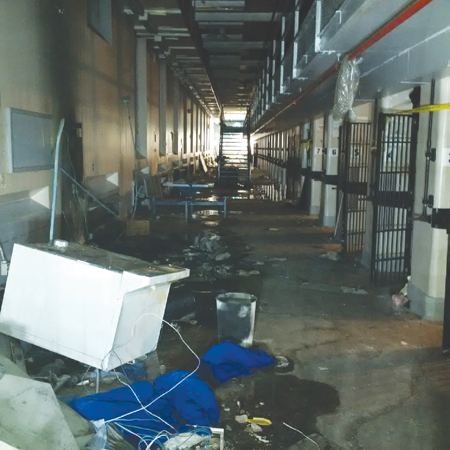
Photo of a
Range post-riot
It is instructive that a number of significant changes to food services were implemented at Sask. Pen. in the aftermath of the riot. Footnote 32 Most significant among these changes include:
- additional servings of food prepared at each meal to account for spillage and ensure shortages do not occur;
- improvement in food quality and quantity, including more stringent adherence to National Menu and prescribed portions;
- hiring of two inmate quality assurance advisors in the kitchen;
- extra food given to inmate kitchen staff;
- additional pay for inmate kitchen staff.
Considered together, these changes are indicative of the fact that the National Menu was not being fully implemented or adhered to at Sask. Pen. at the time of the incident. Moreover, the per diem food cost has increased from $5.08 in December 2016 to $5.90 today, acknowledging the fact that the costs to adhere to the National Menu at sites that are not part of the Cook Chill system are higher.
A series of personnel actions in the kitchen were also taken in the post-riot period, including the appointment of an Acting Chief of Food Services. Efforts were also undertaken to secure more indeterminate kitchen staff. Point by point, these changes mirror the concessions agreed to and signed by the Warden in an attempt to settle the kitchen protest on the day before the riot:
- establishment of two full-time inmate positions to monitor food being served at every meal to ensure it is in compliance with food portion sizes required by the Canadian Food Guide and the National Menu;
- review of specific concerns being presented regarding the treatment of inmate workers by staff;
- review of incentives that can be provided to inmate kitchen workers to recognize their unique and demanding work conditions (access to Canteen, food, recreation privileges, etc.);
- review of hours worked by inmate kitchen workers and assurance that their wages are in compliance with National policy.
In subsequent visits to Sask. Pen. other improvements have been noted by the Office, including enhanced communication between senior management, the Inmate Welfare Committee (IWC) and other inmate representatives (made possible by more permanent IWC membership). The institution also agreed to temporarily waive room and board deductions for those inmates not involved in the riot. The number of inmate kitchen workers has also been reduced to create a more stable and productive work environment. If none of these issues had anything to do with the riot, as the Board determined, why would the Warden have agreed to implement these changes and make concessions in the aftermath of the riot?
In sum, the Board's failure to fully and thoroughly investigate food quality, food shortages and meal portion size at Sask. Pen. was self-serving. This omission ensured that widespread and legitimate inmate dissatisfaction with implementation of the National Menu was dismissed and not implicated in a major disturbance. The food services issues at Sask. Pen. were addressed locally rather than acknowledging problems with the Service's food services practices or policy. The Correctional Service has yet to accept or endorse the Office's repeated recommendation(s) to conduct an independent/external audit and evaluation of portion sizes, food quality, selection and substitution of food items, as well as meal production methods (cook chill), implemented under the food services modernization initiative. The events that took place at Sask. Pen. should serve as a warning that inadequate or poor food quality can have unintended consequences on the safety and security of CSC institutions.
The 'Spark' that Triggered the Riot
Prison riots are not random or inevitable events; they are most likely to occur when a certain threshold of defiance and desperation is reached among a group of prisoners who take matters into their own hands to violently force change or express a long-standing grievance.
- Office of the Correctional Investigator 2016-17 Annual Report
We needed to take it to the next level to get a response.
- Inmate testimonial
In the Office's experience, the catalyst or trigger that sparks a major incident like a riot hardly explains everything else that happened. It does not, for example, help to explain how things got to the point where they became so explosive or the rapid escalation of events, and it certainly does not excuse the ensuing destruction of property, loss of life and violence.
Based on inmate testimonial, the show of presence on E3&4 ranges (upwards of 10 officers) at or around 1:20 pm on December 14 to enforce the Warden's order for general population inmates to return to work or be locked up appears to have been the spark that ignited the implicated ranges in riot. Although the Warden attempted to resume the institution to normal routine (up to that point CSC staff were helping to prepare and serve meals), inmates perceived this action as antagonistic and not as a means of mediation or conflict de-escalation. Prior to that point in time, general population inmates had been given free range time and were receiving pay even though they were not working or attending school or programs over the course of the four-day work refusal in solidarity with the kitchen workers' protest. The Officers who came onto the range were confronted by a group of approximately 50 inmates who reportedly told them that the population was refusing to lock up and would remain on strike until their issues and demands, including those with the kitchen, were resolved. In another encounter between a Correctional Manager and some inmates on E1/2 range, the inmate representative advised that they were starving them and making things worse by locking them up.

Photo of
Damage to walls from shotgun
pellets and painted camera
Reporting and perspective on these brief, but fateful encounters vary. Though there is no audio, the E3&4 range camera shows that there was a meeting/discussion between the Officers and inmates, which the Board simply reports as unsuccessful in getting the inmates to lock up. Inmates reportedly told the Officers to get the fuck off the range. On video, the group of inmates looks resolute while the body language of Officers does not suggest an aggressive or forceful deportment. Unfortunately, there is no verbatim staff record of the exchange between the inmates and staff. Inmate testimony suggests that the Officers delivered a series of demands and ultimatums loss of gym privileges, socials and Christmas canteen if inmates refused to go back to work. The latter point taking away of the inmate Christmas canteen was raised in subsequent contacts between Crisis Negotiators and other ranges that were also refusing to lock up, but did not resort to rioting. Before departing, Officers reportedly informed the inmates that the Emergency Response Team (ERT) would be preparing to deploy.
Almost immediately after staff withdraw from the ranges, inmates were seen obstructing or destroying the range cameras. Some were observed wearing masks or balaclavas before visuals are lost. The range barriers were tied off and makeshift barricades were built in front of the barriers restricting staff observation. Angry, frustrated, and fed up, a number of inmates identified that very point in time as the start of the riot:
Things just got crazy ... things getting smashed the guys felt like they had enough and they just felt that their voice wasn't being heard. It was building up, building up, and guys were frustrated. This is the only way, they felt, that their voices would be heard.
Once things got started, there was no turning back.
- Inmate testimonials

Photo of
Entry of units E1/2 and E3/4
Having just defied the assembled Officers' direct order (carried by the Warden) there is every expectation that the inmates knew what was coming next. In a prison context, when a group of inmates disobeys a direct order as serious as this one, it can have safety and security implications for staff and inmates alike. When confrontation reaches that point, it is hard for either side to save face by backing down. On the inmate side, the point of no return had been reached. In one inmate's expression: It's on!
In addition to the ongoing kitchen protest and inmate strike, there are other indications that Management was more than aware that tensions in general population were running high. In the Warden's expression, in retrospect, the events leading to the riot can be aptly described as a creeping crisis. Although there were few overt signs that the inmates were anticipating or planning for a major confrontation with staff e.g. hoarding of food, covering cell items, stocking up on canteen items there were enough stressors in play that senior management was closely observing events. When inmates on E1&2, E3&4, F1&2 and F4 ranges refused to attend work in defiance of the Warden's order, a number of senior managers were, unusually so, present to observe at the dome entrance which ranges were complying. Though far from planned, the events leading to the riot were not as random or spontaneous as the Board would have it. There were a series of underlying stressors and tensions in play, even if the Board failed to identify or acknowledge them.
Breakdown in Communications
Negotiations were going nowhere.
We got the impression that our voices were not heard.
Some promises were not kept.
- Inmate testimonials
We did not honour some of our commitments.
- CSC Staff Member
By all inmate accounts, the kitchen protest and inmate strike were meant to continue in a peaceful, non-violent manner. In that sense, the riot appears to have not been planned. What is certain is that the events of December 14 turned on how or whether the kitchen protest and work refusal would be settled peacefully. There was a flurry of last-minute meetings between inmate representatives and management to try and end the stand-off. On balance, the Warden's four key concessions made as a means to address the work stoppage in the kitchen, which were presented to representatives of the general population on the morning of December 13, seemed reasonable enough. However, negotiations irrevocably broke down the morning of the riot when inmate representatives rejected the Warden's concessions and brought forward instead an entirely new set of proposals and demands, including doubling of protein rations, for which the Warden had no authority to negotiate. In and of itself, it is not unusual or atypical to bring forward new issues or demands in the negotiation process. While Senior Management must have been frustrated, possibly even exasperated by this turn of events, to go from offering concessions to issuing ultimatums in a charged and volatile environment considerably upped the ante.
The Sask. Pen. riot was not just about the kitchen situation, food shortages or even inmates who were fed up (as it were) and desperate enough to violently take matters into their own hands. As the food and work protest became more and more protracted and both sides more entrenched, there was a critical breakdown in the ability to reach compromise. At key points in the negotiations, inmate representatives meeting with Management did not seem to have the necessary backing or support of general population ranges to compromise or accept concessions. In this case, the usual channels of inmate representation and communication with management did not appear to work optimally, perhaps best illustrated by the Warden electing to hold a private meeting with one of the Inmate Welfare Committee members on the morning of the riot, ostensibly to get a better sense of who was behind the work stoppage and why his concessions on kitchen issues had been refused by the population. Footnote 33
From the inmate perspective, a familiar pattern of dysfunction, suspicion and delay pervaded communications, meetings and discussions between inmate representatives and Sask. Pen. management. In the riot's aftermath, both inmates and staff confirmed a history of broken promises and commitments that had previously only provided temporary relief to long-standing kitchen issues. It is unclear if senior management, some of whom were fairly new to their respective posts at Sask. Pen., had a full appreciation of the protracted and extensive history of conflict and disorder in the Food Services Department. The fact that only general population inmates were allowed to work in the kitchen further increased the interests, stakes and pressure to settle the dispute to the satisfaction of those who were most invested in the outcome.
Indigenous Corrections, Gang and Group Dynamics
You have a group of highly agitated offenders with access to every type of weapon, pack mentality, a full scale riot going on, adrenaline pulsing through them and no officers watching and no chance of being caught or stopped.
- Security Intelligence assessment shared with Board members
Though the riot took place in the medium security sector of Sask. Pen., it was primarily confined to five ranges (E1&2, E3&4 and F4) in two different general population units (1 and 4). There were 131 of 475 (27%) medium security inmates involved or implicated in the riot. Of significance and relevance, these units were integrated ranges which housed a significantly higher concentration of gang-affiliated inmates. Footnote 34 These units also housed a markedly higher proportion of Indigenous inmates than the rest of the medium security sector. In fact, on the day of the incident, 85% of the 131 inmates living on these ranges were of Indigenous ancestry (compared to 62% for the rest of the medium security population). All three victims, including the murder victim, were Indigenous. Footnote 35
The Board identified 21 principal instigators who were involved, participated or incited the riot (five of whom were working in the kitchen at the time of the incident). The Office determined that 18 of 21 individuals in the principal instigator group were Indigenous; 11 were gang-affiliated. From the principal instigator group, 16 individuals were subsequently reclassified and involuntarily transferred to a maximum security institution. In the aftermath of the riot, 43 of 131 (31%) inmates were transferred to maximum security institutions, 38 of whom (88%) were Indigenous and 33 (77%) gang-affiliated. Fourteen (14) inmates were charged by the RCMP with various offences including mischief over $5,000, obstructing justice, riot while wearing a mask, disguised with intent. According to CSC records, 12 of those charged were Indigenous and 10 were gang-affiliated.
Despite this demographic profile, the underlying Indigenous composition and gang dynamics of the riot were not assessed by the Board, nor subsequently by the Service. Aside from identifying 21 individuals as principal instigators, there is no serious attempt by the Board to describe, assess or analyze the prevailing living conditions, group dynamics, population (gang) management, material circumstances, institutional behaviour or profile of inmates implicated in participating in the riot. Footnote 36 A more detailed demographic profile and analysis conducted by the Office shows that, on comparison to the rest of the medium security sector, inmates on the rioting ranges were considerably younger (the average age was 30, with the youngest being 18), overwhelmingly Indigenous, proportionately and considerably more gang-affiliated and more likely to be serving their first federal sentence. There are substantive and determinative differences between those inmates and ranges that rioted and those that did not. By establishing and assessing these factors, we can better understand the situational context and dynamics that gave rise to the riot.
In looking at these factors more closely, Footnote 37 the Office found that the double-bunking rate on E1&2 ranges at the time of the incident was 22% and 17% on ranges E3&4. With respect to program and work assignments, only 7 of 131 (5.3%) inmates on the rioting ranges were involved in a correctional program to address criminogenic needs at the time of the incident, a very low level of participation by any standard. Another 22 (16.8%) inmates were enrolled in school. Overall, 71 (54%) had a work assignment of one kind or another (including 23 who were working in the kitchen). Thirty-two (32) inmates (24%) were listed as unemployed.
A review of the number and rate of institutional incidents and discipline that are assault-behaviour or contraband-related in the calendar year leading up to the riot (January 2016 to December 2016) reflects both demographic indicators (overwhelmingly Indigenous) and group dynamics (predominantly gang) of the five ranges that rioted:
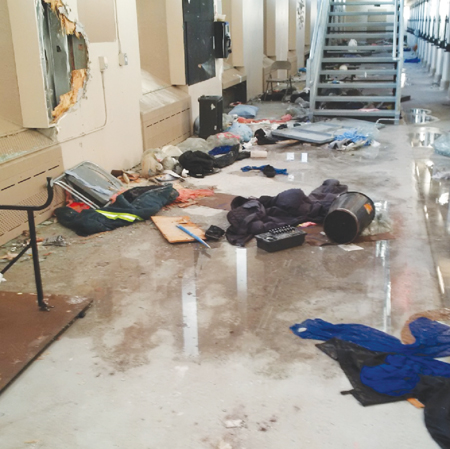
Photo of a Range post-riot
- 99 of 131 different offenders who rioted were implicated in 322 incidents in the year leading up to the riot (one third of all institutional charges were for contraband).
- 74 different offenders were implicated in 165 institutional incidents.
- 37 of 131 inmates were admitted to segregation at least once in the year prior to the incident under review.
Similarly, the high need/high risk assessments and low reintegration potential for the majority of the 131 inmates involved in the riot reflects the prevailing demographic and social history profile of Indigenous people behind bars in Canada parental addiction, poverty, involvement of child welfare agencies, foster/group home placements, witness to family violence, influence of street gangs, loss of culture, early and extensive involvement in the criminal justice system. None of these individual and group indicators, outside the predilection for violence, struck the Board as worthy of reflection or comment. In fact, beyond passing reference to the requirement for CSC to have considered Aboriginal social history in effecting the numerous security reclassifications and involuntary transfers to maximum security institutions in the aftermath of the riot, it is possible to read the Board's entire report, as well as the public Case Summary , without ever knowing that the ranges that went up in riot were overwhelmingly occupied by young, predominantly gang-affiliated Indigenous men. Presumably, these young men were fed up enough to incite, instigate or participate in an incident that could result in a maximum sentence of life imprisonment; yet there is no serious or sustained attempt on CSC's part to investigate why.
The Office contends that the rage and violence unleashed in the riot's rampage cannot be fully understood or explained without accounting for the presence, influence and concentration of gang-affiliated inmates on the implicated ranges. Preventive security information reviewed by the Office suggests that gang-influenced behaviour played a significant role during the riot, casting further doubt on the Board's random event explanation. The Board did not assess or report on the gang behaviour and group dynamics of the riot.
Given the ongoing and accelerated rates of over-representation of Indigenous people in federal corrections, the CSC has had little choice to move away from separation of rival gangs to integration. Though integration may buy peace for a time, with ranking members reaching an understanding or declaring a truce amongst themselves, the potential for violence in such a context is always present. In such a setting, a preponderant amount of staff resources and effort is devoted just to keeping the peace between rival gang members. No one, including staff, is immune or indifferent to the reach or influence of gangs. Though staff reported nothing out of the ordinary with respect to gang activity or tensions before the incident, this remark passes for what is considered ordinary in these settings.
Due to the age of the facility (Sask. Pen. was opened in 1911), infrastructure limitations and physical layout of the ranges in question, it was difficult for staff to ensure a dynamic presence at the best of times. For the most part, staff relied on monitors to observe range activity. Once staff were withdrawn and visual observation was lost, inmates had little means to protect themselves from either group/gang retaliation or targeted retribution. Footnote 38 While the riot's rampage initially centred on destroying cell fixtures, smashing government property, setting fires and flooding, as the rioting progressed and the likelihood of an Emergency Response Team intervention increased, it seems that the focus of the rioters narrowed to individual targets. In that sense, the violence and mayhem showed some capacity for planning, if not coordination.
Though the Board provides a very thorough background description for each of the 21 principal instigators and their individual degree of involvement in participating or inciting riot, it fails to assess this information in context of Indigenous social history. The Board's failure to acknowledge the Indigenous composition (social histories) and character of the riot leads directly to its failure to account for the gang behaviour and dynamics of the incident. There is every reason to believe that had the Board approached its investigation from an Indigenous social history perspective its findings would have been markedly different. As it is, the Board makes no recommendations and draws no lessons learned involving Indigenous corrections whatsoever.
In the Sask. Pen. situation, the Office would highlight three lessons from the intersection of group/gang dynamics and rioting behaviour:
- The presence of street gangs in a prison setting is a predictor of violent misconduct.
- Federal corrections lacks a comprehensive, coordinated and national gang reduction and gang (dis)-affiliation strategy.
- Egregious material and living conditions of confinement, perceived mistreatment and punitive measures strengthen group (gang) cohesion.
By failing to acknowledge the Indigenous composition and character of the Sask. Pen. riot, the Board (and CSC) seems to have purposefully avoided coming to terms with the uglier aspects of this incident the gross over-representation of young Indigenous men in Canadian prisons who continue to be marginalized and see little future for themselves. The majority of these Indigenous offenders, if they remain gang-affiliated, will likely only gain release from a federal prison at mandated statutory release dates. Conditional release is not a reality. This has become the stark reality of the Indigenous inmate experience in much of Canada. The Board's failure to address these obvious factors and conditions is perplexing. That federal corrections is failing Indigenous people has long been a preoccupation of my Office. Footnote 39 CSC continues to reject the need for a Deputy Commissioner for Indigenous Corrections and fails to reallocate significant resources to create the conditions for new section 81 agreements that would allow Aboriginal communities to be responsible for the care and custody of Indigenous offenders.
The National Board of Investigation (NBOI) Process
Despite the fact that there are some serious credibility issues involving the one (and only) inmate formally interviewed by the Board, Footnote 40 key points of his testimony that he was assaulted because he did not participate in the riot, that the riot had not been planned and that inmate protest was supposed to have been peaceful are reported more or less verbatim by the Board. Even though there are obvious reliability and credibility issues, this informant's testimony fits neatly within the Board's random event explanation:
- The riot was spontaneous.
- The damage and violence was amplified by fear and threats to participate or face consequences.
- The environment itself was preconditioned for collective violence.
On the key question of food portion size and food quality, only Managers responsible for or overseeing the Food Services Department were interviewed by the Board. Indeed, for the most part, only Management's interpretation of the events under review is relied upon. Similarly, though the report notes that an Inmate Welfare Committee representative reportedly told the Warden in a private meeting just hours before the riot that the inmate population was hungry and fed up with declining living and material conditions, this meeting is later construed as evidence that food portion size was not a contributing factor to the ongoing work stoppage. This inmate was not interviewed by the Board.
The Board identifies 12 areas for improvement; nearly all are isolated to how the local Sask. Pen. authorities managed or responded to the riot, and nearly all are approached from a security focus. Most areas for improvement are technical or administrative in nature (e.g. the plans drawn up to quell the riot did not include all the weapons deployed; the quality of the handheld video-recording of the riot squad was poor and unreadable; evidence collection from crime scenes was not methodical) or otherwise point to issues of policy non-compliance (e.g. failure to accurately document segregation placement or share information related to an involuntary transfer). Though serious enough in their own right, none of the identified areas deal specifically with what caused the riot or how a progressively escalating situation could be managed without loss of life, property damage or serious bodily injury.
Riots are relatively rare events in federal corrections. Although not unprecedented, what is unusual about the Sask. Pen. riot is that it occurred in the medium security sector of a federal penitentiary. The events leading from an inmate protest about food quality/quantity to work refusal to eventual confrontation and violence escalated quickly. Despite the urge to think otherwise, prison riots are not usually random or inexplicable events. Important causal and preventive information can be gleaned by identifying who was involved and why. The aftermath of a prison riot should be approached in an objective manner: what can be learned from these events; what can be done to prevent them; how to identify and de-escalate a situation that could potentially escalate into violence?
The Board offers no lessons learned about crisis communications, including what might be gleaned from the valuable perspective, insights and experience of the Crisis Negotiators who were brought in to negotiate a peaceful resolution to the crisis and had first-hand contact with rioting ranges. There is nothing about how to de-escalate a crisis situation when negotiations have failed to reach an acceptable compromise. The involvement and use of Aboriginal Elders to help resolve conflict is not explored. No insights beyond policy compliance are offered about the kitchen and food services department at Sask. Pen. No significant findings are identified that would relate to the appropriateness of placing rival gang members on the same integrated general population ranges. In fact, there is no mention of Indigenous corrections in the Board's report. Finally, there is little mention of the triggers, catalysts or pre-indicators that could help the Service better understand how riots start or how they might be prevented. Indeed, this Board is largely silent on points of learning, prevention and corrective measures, which are the aims of convening and conducting Boards of Investigation in the first place.
Compared to past national-level investigations into equally serious incidents, the Board's significant findings section is surprisingly thin. Given the loss of life, serious injuries sustained, the use of potentially deadly force and the widespread destruction of government property, one could reasonably have expected a comprehensive and credible account of the events under investigation. A lot of the report is concerned with assessing staff and management's response in quelling the riot. A great deal of effort, attention and detail also went into identifying and assessing the degree of culpability of each of the 21 principal instigators. Comparatively little attention, rigour or insight is brought to bear on identifying or understanding the riot's underlying triggers, causes or catalysts. Repeating a familiar pattern, none of the significant findings, areas for improvement or recommendations come close to matching the seriousness of the incident under review. These are endemic weaknesses of the NBOI process.
In fact, there is only one area of improvement that could be said to be linked to the NBOI's wider learning or prevention mandate, and even then there are questions about the veracity and relevancy underlying the learning point in question. In the most important section of the report, under the header Significant Findings , the first area of improvement states:
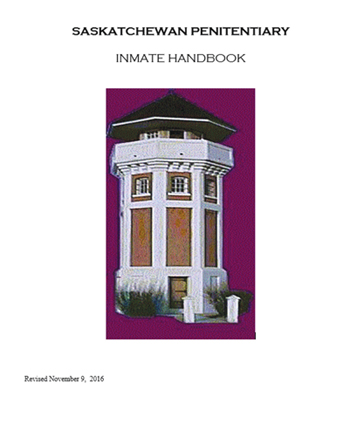
Photo of Saskatchewan Pentitentiary
Inmate Handbook cover
One inmate's knowledge of the Riot Proclamation contributed to a peaceful resolution on F1 Range with inmates returning peacefully to their cells within 30 minutes of the proclamation. Inmates were not normally educated on the Riot Proclamation and the consequences of the same.
The Board appears to have felt strongly enough about this finding that it is turned into one of only three recommendations made in its report. The Board frames its recommendation in these terms: (CSC should consider ) reviewing inmate orientation curriculum to determine if information related to the meaning and consequences of the Riot Proclamation should be included as well as added to Inmate Handbooks.
On the surface, the rationale seems sound enough if inmates had more foreknowledge of the implications of participating in a riot then perhaps they would think twice and agree to disperse, or, in this case, go to work or lock-up as ordered. Though it is identified as a major learning point, a lack of understanding of the meaning of the Riot Act Proclamation does not appear to be relevant or factually supported by the events in question. On the point about relevancy, according to one investigator's notes, the overwhelming majority of inmates who appeared before disciplinary court after the riot confirmed that they heard and understood what the Riot Act Proclamation meant, but (likely to avoid self-incrimination) went on to testify that they would be hurt if they did not participate. In any case, it is questionable what value the reading of the Riot Act had in the Sask. Pen. situation as it certainly did not deter or have the desired impact on five ranges when it was read over the all-call system by the Deputy Warden.
On the more substantive point the issue of the Riot Act Proclamation playing a role in F1/F2 ranges locking up peacefully this finding is not entirely supported by the facts of the incident. Footnote 41 According to Officer Statement and Observation Reports (OSORs) prepared by the two Crisis Negotiators and reviewed by the Office, F1&2 ranges remained calm and quiet throughout the disturbance. In fact, each time the Crisis Negotiators made contact with these ranges, they noted that the inmates were not damaging the range or arming up. Their level of risk was assessed as low by the Negotiators throughout the crisis, which was the same level of risk as other ranges (like Pathways) who also initially refused to lock up.
In point of fact, the F1&2 range representatives claimed they were refusing to lock up in a show of solidarity with the kitchen protesters and the rest of the general inmate population. Aside from food portion concerns and perceived mistreatment of inmate kitchen workers, they were unsure of the reasons why other ranges were acting out. According to the Negotiator's notes, the range representatives claimed that they had issues with the lack of food portions and that's where it started. The inmates further related that they were sick of fighting with the kitchen and everyone about it.
After the Riot Act Proclamation was read, inmates on F1&2 ranges began to lock up slowly but peacefully, a process that was completed without incident by 4:15 pm. In sum, it appears this group of inmates had no intention of rioting in the first place; in fact, they had successfully negotiated to have running water restored to their range if they continued to remain calm and quiet. Each time the Crisis Negotiators made contact with this range, the inmate representatives sought information about what was going on elsewhere, as if they did not want to be among the first to lock up. On balance, the Office concludes that CSC's learning is misplaced and even misdirected. The reading of the Riot Act certainly did not have the desired deterrent effect on those ranges that continued to blatantly ignore the order to immediately and peacefully disperse.
Conclusion
The Office identified a series of substantive procedural concerns, gaps and omissions in how this particular Board of Investigation was approached and conducted. When confronted with information or evidence that conflicted with or ran contrary to its random event theoretical explanation, at nearly every turn the Board chose to either ignore, dismiss or downplay its significance. The Board's explanation that the riot was unplanned, random, spontaneous and unrelated to food is self-serving and not credible.
| Internal Investigation | Public Account |
|---|---|
| National Board of Investigation (NBOI) Submitted November 29, 2017 | Board of Investigation into the Riot at Saskatchewan Penitentiary (Case Summary) Released March 21, 2018 |
The Board found that the prison riot at Saskatchewan Penitentiary was consistent with research supporting the random event theory on prison riots. There were no pre-incident indicators that would have predicted the riot. The Board determined that the riot was not a planned event. The Board determined that the riot could not have been foreseen. the riot was spontaneous and unrelated to food quality/quantity. the changes in the senior management team did not result in major changes to the management of the inmate population. The work refusal that had begun December 9, 2016, was a proximal precipitating event (meaning it was linked in time to the incident under investigation). | The Board of Investigation found the riot was consistent with research suggesting that it emerged as a result of many intersecting factors. The Board identified the following situational factors that may have created an environment where a riot was more likely to occur:
The catalytic event that could have sparked the riot was the kitchen walk outs. Soon after a series of walk outs, inmates throughout the institution refused to go to work in what was reported to be a peaceful protest in support of the kitchen workers. |
If the Board's account of the riot was self-serving, then the Case Summary is misleading because it is not based on the facts or findings of the Board of Investigation. The Case Summary's claim that the riot emerged as a result of numerous intersecting factors is simply not supported or grounded in the Board's investigation. The Board found no pre-incident indicators that would have predicted the riot. It claimed that the events that led to the incident could not have been foreseen or prevented (not an uncommon finding in Boards of Investigation). Having concluded thus, it is not surprising that the Board identified little in the way of lessons learned, areas for improvement or recommendations of any significance. Moreover, the Board's narrow focus on compliance with policy and procedure did not allow for a critical and rigorous analysis of the underlying cause(s) and triggers of the riot. The Board determined that Sask. Pen. food services department was compliant with the National Menu. With the compliance test met, the Board was able to conclude that the riot was unrelated to food quality or quantity.
It is not entirely coincidental that the Case Summary comes across as a more convincing account than the Board's. As a public communications exercise, the Service knew that this Office was closely scrutinizing the means, method and sources of information by which the Board came to its findings and conclusions. Well before the Board had concluded its work, the Service was aware that the Office was on record as stating that food quantity and quality contributed to (though did not necessarily cause) the Sask. Pen. riot. By reinterpreting and rewriting the Board's findings, the Case Summary pre-empts the Office's criticism that the Board's account of the riot was not credible or transparent. The Board's assertion that food played no role in the riot has been exposed for what many, including some within the Service, already knew to be the case.
Perhaps one lesson that could be drawn here is that Sask. Pen. authorities failed to supplement or circumvent the National Menu as so many other Wardens have learned to do in managing the change and disruption that have accompanied the food services modernization initiative. In the never-ending drive to standardize, streamline and centralize inmate programs and services across the Service, the ability of Wardens and their management teams to safely and effectively manage inmate populations has been significantly eroded. The lack of local autonomy and decision-making control was a common theme that CSC staff and management raised through the course of the Office's review. Adhering to the National Menu with the low per diem allocated for this purpose is challenging, if not impossible.
Finally, the focus of any post-incident investigation must be to learn and to bring about improvement. In that respect, the omissions of this particular Board are reflective of the inherent limitations and deficiencies of the NBOI process:
- Findings, lessons learned and recommendations from National Boards of Investigation rarely match the seriousness of the incidents under review major disturbances, assaults, riots, serious bodily injury and deaths in custody.
- The National Board of Investigation process is not free, impartial or independent from the Correctional Service of Canada, in form, function or appearance.
- Investigative standards credibility, rigour, integrity, thoroughness, quality are not consistently met from one Board of Investigation to the next.
- There is no requirement for Board of Investigation reports to be disclosed publicly or even distributed internally.
- The BOI focus on policy and procedural compliance often fails to address the underlying cause(s) of recurrent incidents, impeding learning and limiting improvement.
Findings
- The Board of Investigation's random event explanation for the Sask. Pen. riot is highly improbable, superficial and self-serving.
- The public account of the Sask. Pen. riot ( Board of Investigation into the Riot at Saskatchewan Penitentiary Case Summary ) does not match the facts, findings or conclusions of the Board of Investigation upon which it is purportedly based.
- The means, manner and method by which the Board of Investigation approached the Sask. Pen. riot was not transparent or credible.
- There was a breakdown in communications between inmates and Management resulting in a failure to settle the kitchen dispute and end the work stoppage peacefully.
- The Officers' show of presence on E3&4 ranges, and the verbal exchange that ensued, was more than likely the trigger that ignited the general population ranges in riot.
- Food quantity and quality issues were contributing factors to the Sask. Pen. riot.
- The riot's rampage and ensuing violence cannot be explained or understood without accounting for the group dynamics on the integrated (gang) ranges.
- The key learning point to emerge from CSC's investigation of the Sask. Pen. riot ensure inmates are informed of the meaning and consequences of the Riot Act Proclamation is misinformed and misplaced.
- The Indigenous composition and character of the Sask. Pen. riot was ignored by the Board and subsequently by CSC.
- The aims and objectives of convening and conducting Boards of Investigation (prevention, learning, correction) are consistently failing CSC resulting in repeated and recurring failures to learn from and prevent serious incidents.
Recommendations
- I recommend that the Minister of Public Safety conduct an independent review of the National Board of Investigation section 19 process to enhance transparency, credibility, integrity and accountability of investigations convened and conducted by the Correctional Service of Canada. This review would consider an option for the Minister to authorize an external and independent investigation into major disturbances (riots) resulting in injury or death, suicides in segregation and use of force interventions leading to serious bodily injury or death.
- I recommend that the CSC conduct an external audit of its Food Services Modernization initiative (National Menu and Cook-Chill). The audit should review cost of the implementation and impact of this initiative on inmate employment and canteen purchases.
- I recommend that CSC creates and appoints a Deputy Commissioner level position for Indigenous Affairs to ensure that corporate attention and accountability remains focused on Indigenous issues in federal corrections.
INDIGENOUS CORRECTIONS

Photo of an Indigenous
programs room
In my 2016-17 Annual Report, I reported on the findings of the Auditor General's Report Preparing Indigenous Offenders for Release . In many key areas, the Auditor General's Report independently corroborated concerns repeatedly identified by my Office over many years. I was encouraged that the Service fully accepted all of the AG's findings and recommendations. The Service's response is a significant development in an area of corrections in need of serious rethinking and reform.
In the ten-year period between March 2009 and March 2018, the Indigenous inmate population increased by 42.8% compared to a less than 1% overall growth during the same period. As of March 31, 2018, Indigenous inmates represented 28% of the total federal in-custody population while comprising just 4.3% of the Canadian population. The situation continues to worsen for Indigenous women. Over the last ten years, the number of Indigenous federally sentenced women increased by 60%, growing from 168 in March 2009 to 270 in March 2018. At the end of the reporting period, 40% of incarcerated women in Canada were of Indigenous ancestry. These numbers are distressing.
All things being equal, people of Indigenous heritage are under-represented in community corrections, comprising just 18% of the supervised population as of March 2018. More encouragingly, the number of sentenced Indigenous people supervised in the community has increased significantly over the past ten years. Between March 2009 and March 2018, the Indigenous supervised population grew by 52.3%, far surpassing the overall supervised population growth of 16% over the same time period. Also trending in the right direction, the supervised Indigenous women population grew by 73.4% over this time period, increasing from 109 Indigenous women in 2009 to 189 in 2018.
Correctional Outcomes for Indigenous Offenders
- Statutory Release (SR) at two-thirds of the sentence continues to be the most likely type of release for Indigenous individuals; however, this proportion has decreased over the past ten years (2008/09 = 80.5% versus 2017/18 = 72.5%).
- While the proportion of Indigenous offenders released at SR has decreased, it remains significantly higher than that for the overall population (60%) released at SR.
- Day parole rates are creeping up for Indigenous offenders (2008/09: 14.8% to 2017/18: 18%), but remain far below those for the overall population (2017/18: 35.4%).
- Indigenous offenders are disproportionately involved in self-injurious behaviour. In 2017/18, they accounted for 48.3% of all self-injurious incidents.
- While segregation placements have declined overall, this is not the case for Indigenous offenders.
- Between 2015/16 and 2017/18, the number of segregation admissions for the overall population dropped by 23% compared to 10.3% for Indigenous offenders. In 2017-18, Indigenous offenders comprised 36% of all segregation admissions.
- Indigenous offenders made up 30% of all admissions to federal custody in 2017-18 compared to 22.5% in ten years earlier (2008-09).
- 39% of Indigenous offenders returned to federal custody on a revocation, compared to 31% for the total population.
- Indigenous offenders have a much higher rate of return to custody two years post warrant expiry (10.5% versus 6.2% for the total population).
- Indigenous offenders are over-represented in involuntary transfers. In 2017-18, they comprised 33.4% of those involuntarily transferred.
Source: OCI Trends Analysis (2017-18), based on CSC Data Warehouse, May 2018
Aboriginal Healing Lodges
As the number of Indigenous people admitted to custody continues to increase, bed capacity in the community has not kept pace. The overall number of Healing Lodges (CSC operates 4 while Aboriginal communities run 5) remains the same. The Prairie and Quebec regions continue to be the only regions of Canada where section 81 Healing Lodges exist. At the end of 2017/18, there were 3,850 people of Indigenous heritage incarcerated in federal facilities. Total bed capacity for the five section 81 Healing lodges is just 163.
| Occupancy | Capacity | ||
|---|---|---|---|
| CSC Healing Lodge | Kwkwxwelhp Healing Village | 49 | 50 |
| P Skstw Centre | 59 | 60 | |
| Willow Cree Healing Lodge | 47 | 80 | |
| Okimaw Ohci Healing Lodge | 51 | 60 | |
| Total | 206 | 250 | |
| Section 81 Healing Lodge | O-Chi-Chak-Ko-Sipi Healing Lodge | 17 | 28 |
| PA Grand Council Spiritual Healing Centre | 9 | 12 | |
| Stan Daniels Healing Centre | 27 | 73 | |
| Buffalo Sage Wellness Centre | 26 | 28 | |
| Waseskun Healing Centre | 9 | 22 | |
| Total | 88 | 163 |
Source: CSC, Corporate Reporting System (extracted March 27, 2018)
The original intent for the Healing Lodges was outlined in Creating Choices . Footnote 42 The model was based on principles emphasizing a safe place for Indigenous offenders, a caring attitude, client-specific planning and an understanding of Indigenous culture. The administration of the Lodges was conceived to be a place where Elders, teachers, healers and Spiritual Advisors would play a pivotal role. Staff selected to work at the Healing Lodges would be Indigenous and recruited based on their life experience and their ability to act as positive role models. While the original vision allowed for non-Indigenous staff in support roles for specific skills and expertise, this has not come to be the case in practice. There are often a number of non-Indigenous staff members working at the Healing Lodges, and while they may have training specific to working in such an environment, this staffing model does not meet the original intent. It is important that staff reflect the culture and community at the centre of a Healing Lodge. Staff at all levels should exemplify the healthy life path and commitment to a healing journey that they wish to see in the offenders with whom they interact. Consideration should also be given to developing and training Indigenous staff to take on more senior management roles within the Lodges.

Photo of an Indigenous spirituality room
CSC must also ensure each Lodge is meaningfully and respectfully connected to an Indigenous community. Historically, CSC has not fully engaged with local Chiefs and Councils in a meaningful way, which has led to a long-standing sense of alienation and mistrust among Indigenous communities. The nurturing and support of positive connections is key to reconciliation and to repairing the relationship between CSC and Indigenous communities. It will also allow for the sharing of expertise and exchange of learning. Meaningful partnerships must be built upon trust and facilitate the self-determination and healing of Indigenous inmates and communities.

Photo of the Stan Daniels Healing Centre, Edmonton
Additional urban-based Healing Lodges are necessary, similar to the Stan Daniels Healing Centre (men) or Buffalo Sage (women), in order to provide a safe place for Indigenous people wanting to return to urban communities. Upon release, many Indigenous individuals, particularly young people, return to an urban area where cultural resources and assistance may be limited. Opportunities for Indigenous communities and organizations within urban areas should be provided and encouraged to allow these communities more control over the care, custody and release of Indigenous individuals. Urban Lodges established in close proximity to employment and education facilities would provide greater opportunities and connections to Indigenous resources within a city. To facilitate this, CSC should explore section 81 partnerships with Indigenous urban associations who may be open to partnering in the supervision of Indigenous inmates and the development of supports for successful reintegration into urban life. In addition, increased use of section 84 releases to urban areas through private home placements would allow Indigenous individuals to return to the community under the supervision of an Indigenous organization/community/family.
On a positive note, over the past year CSC has taken steps to strengthen the negotiation process for section 81 Healing Lodge agreements, which includes creating a stronger agreement framework in consultation with current agreement holders. A revised formula for funding that recognizes the unique requirements of the different Healing Lodges has also been established. These changes were to be reflected in all agreement renewals for the 2017-18 fiscal year. I am encouraged by these developments and look forward to seeing more negotiations with Indigenous communities and organizations who are interested in establishing Healing Lodges.
- I recommend that CSC re-allocate very significant resources to negotiate new funding arrangements and agreements with appropriate partners and service providers to transfer care, custody and supervision of Indigenous people from prison to the community. This would include creation of new section 81 capacity in urban areas and section 84 placements in private residences. These new arrangements should return to the original vision of the Healing Lodges and include consultation with Elders.
Gladue Reports
In 1996, a series of amendments to the Criminal Code of Canada targeted the over-representation of Indigenous people. Section 718(2) requires sentencing courts to consider the unique background and circumstances of Aboriginal people and alternatives to incarceration during sentencing. Subsequent judicial interpretation of the provision, notably R. v. Gladue (1999) and R. v. Ipeelee (2012), established what came to be known as the Gladue factors (e.g. effects of the residential school system, experience within the child welfare or adoption system, level or lack of formal education, poverty and poor living conditions) as a mandatory consideration whenever an Indigenous person is facing a possible loss of liberty. CSC has extended the application of Gladue factors to correctional decision-making, which means in practice that the circumstances of an Aboriginal offender must be considered in security classification, penitentiary placement, institutional transfers and administrative segregation decisions.

Photo of a Healing Lodge building
The social and historical context and evidence central to the Gladue requirement provides case-specific information of the offender's healing needs. That information, commonly provided to the court through a Gladue Report, should include both prison and non-prison sentencing options, as well as a blueprint for healing from court proceedings through to incarceration and eventual return to the community. These reports typically contain valuable, in-depth information that should inform sentence administration for an Indigenous offender.
In provinces such as Saskatchewan, Gladue reports provide for the completion of pre-sentence reports with Gladue content in the majority of cases, reserving the provision of a full Gladue report in only the most serious cases. Though practice is inconsistent across the country, when a Gladue report is produced for the courts it should be considered in its entirety by CSC to ensure a contextualized approach to Indigenous sentence management. In such cases, it would seem redundant to create a secondary Aboriginal Social History (or ASH report). Short cuts and what appears to be a time-saving approach (template or checklist) are not likely to lead to better outcomes or more informed Gladue decision-making.
Update on Truth and Reconciliation Commission 'Calls to Action'

Photo of National Public Service week, OCI Feather Project activity, June 2018
It has been nearly three years since the Truth and Reconciliation Commission (TRC) issued its final report Honouring the Truth, Reconciling for the Future (December 18, 2015), to which the Government of Canada committed to implementing all of the recommendations. Little practical progress has been made on the TRC's ' Calls to Action ' impacting federal corrections:
- Eliminate the over-representation of Aboriginal people and youth in custody over the next decade.
- Implement community sanctions that will provide realistic alternatives to imprisonment for Aboriginal offenders and respond to the underlying causes of offending.
- Eliminate barriers to the creation of additional Aboriginal healing lodges within the federal correctional system.
- Enact statutory exemptions from mandatory minimum sentences of imprisonment for offenders affected by Fetal Alcohol Spectrum Disorder (FASD).
- Reduce the rate of criminal victimization of Aboriginal people.
For federal corrections, the heavy lifting has hardly begun. A bolder direction is clearly required. To address the enormity of the challenge of Indigenous over-incarceration, CSC and the Government of Canada must more fully devolve responsibility, but most of all resources and control, back to Indigenous people. In practice, this could entail a reallocation of spending to match the proportion of Indigenous people with a federal sentence. Reallocated funding would be re-profiled to create new community bed space capacity, especially in urban areas, and additional Section 81 facilities, truly Indigenized programs and services run by and for Indigenous communities. Loosening the levers and instruments of correctional (some might say) colonial control is consistent with the path toward reconciliation between Canada and its First Nations. Of course, devolution of correctional power will only happen if there is courageous and visionary leadership at the top of the Correctional Service a vision and commitment that must be duly supported and directed by the Government of Canada.
- To honour the Truth and Reconciliation Commission's 'calls to action,' I recommend that CSC spending, budget and resource allocation should better reflect the proportion of Indigenous people serving a federal sentence. Over the next decade, re-allocation of resources and delegation of control to Indigenous communities should be the stated goals of CSC's contribution to reaching the TRC's 'calls to action.'
Indigenous-based Gangs in Prison

Photo of Pathways unit
As the Office's investigations of young adults in prison and the Sask. Pen. riot illustrate, much more must be done to reach young Indigenous men already in prison as well as those entering for the first time with gang-affiliations. Given that more than 20% of Indigenous inmates are gang-affiliated according to CSC records, this growing reality, especially in the Prairie Region, cannot be ignored. Those Indigenous offenders who remain or become gang-affiliated behind bars have little hope of gaining early or conditional release from prison. Without a well-resourced national gang dis-affiliation strategy, federal corrections will continue to effectively warehouse a large proportion of young Indigenous men whose safety behind bars remains inextricably tied to gang allegiances.
I note, with concern, that the newly created Aboriginal Intervention Centres (AICs), CSC's signature response to last year's Auditor General's report, will not address or make any difference in this area. Gang-affiliated individuals coming into CSC facilities or those with active gang ties are ineligible to participate in Pathways, an intervention that has become the most likely way for an Indigenous person to obtain early release from a federal prison. CSC has no strategy or intervention that addresses gang involvement, which is responsible for so much of Indigenous offending, especially among young adults. While all young people are vulnerable to gang recruitment inside prison, the unique experience and needs of young Indigenous offenders, with or without gang affiliations, needs to be addressed if the cycle of over-representation is to be halted and reversed. A concerted effort has to be made.
Just as there are several pathways into prison for Indigenous people poverty, family violence, addiction, intergenerational trauma and abuse (resulting from Residential Schools, 60s Scoop, involvement of child welfare agencies) so too must there be more than one way out. CSC does not require a non-Indigenous person entering prison to follow their spirituality, healing or cultural traditions in order to engage in programming. To expect a person of Indigenous ancestry to follow an Aboriginal healing path or cultural traditions when imprisoned is one thing, but to make that a determinant for release is quite another. Indigenous people walk in the two worlds all their lives. The approach to Pathways and the AICs seems somewhat parochial, if not patronizing.
Although my Missed Opportunities report contained extensive discussion of the experience of young Indigenous men with and without gang affiliations in federal prisons, CSC ignored the report. I am compelled to relate some of what young Indigenous people told my Office and to repeat a recommendation from my earlier report:
"Many of those (young Indigenous adults) interviewed were affiliated with a gang. Some of those who were not affiliated reported that others had tried to recruit them while in prison. Those who were not involved with gangs prior to coming to prison reported feeling unsafe, not knowing how to conduct themselves around gang members and finding it difficult to continue to refuse to join a gang. Two young adults with no previous gang affiliation talked about being recruited into a gang while at Stony Mountain. One reported joining a gang because he felt 'overwhelmed' in prison and thought he would be safer, but later realized that '...it's not safe if you join a gang, you think it is safer but things happen.' Significantly, both inmates were being held on a more 'integrated' range for those who had disassociated from a gang at the time of interviewing. One had been stabbed (in the neck) for disobeying a gang order and the other had been threatened with violence. Footnote 43
- I recommend that the CSC develop a National Gang and Dis-Affiliation Strategy and ensure sufficient resources are allocated for its implementation, inclusive of (core and cultural) programs, employment and services. Special attention should be paid to Indigenous-based street gangs. This strategy should:
- be responsive to the unique needs of young Indigenous men and women offenders, including education and meaningful vocational opportunities;
- ensure that non-gang affiliated young adult offenders are not placed where there are gang members who may attempt to recruit or intimidate them;
- facilitate opportunities (e.g. workshops, seminars, public speakers, etc.) where young adults can engage with their culture and/or spirituality, and age-specific activities;
- incorporate best practices and lessons learned from other jurisdictions and other public safety domains.
5. SAFE AND TIMELY REINTEGRATION
I have recently served a federal sentence for a 'white collar crime' in which I plead guilty.
I came across the Globe and Mail article published some time ago about your position as an investigator within the Canadian prison system. I stumbled across this article while looking online for help into adjusting to reintegration into society. My sentence was very short, just over 6 months, but as a person who doesn't live a life of crime or associate with people who have a criminal record, I was shocked and surprised how life changing the whole prison experience was.
In the beginning I was pleasantly surprised at how supportive my parole officer was when she stated I would be 'supported' and how it was important to stay in contact with family and individuals of support within my community. Unfortunately what I experienced was roadblocks that made inside and outside support very difficult. Telephone numbers, that had to be approved in order to make a paid call out from prison took weeks to approve, mail sat in offices for days or even weeks before receiving it (some I never received) and seeking mental help within the system was impossible to get unless you claimed to be suicidal.
I was offered by inmates to connect me with guards who had everything from bales of tobacco to performance enhancing drugs to allow me to gain muscle size in the gym. I was cat called at by the same male guard several times and heard inappropriate comments from female guards both to me directly and while walking on the range while doing scheduled walks. The language from CSC staff was disgusting. At times it was hard to tell staff from inmate except for the uniform.
I guess I'm writing this in part to process what I've been through. Not many people understand when I speak of some of the things I've experienced in the past few months, many of which I haven't mentioned. It was truly a life changing experience, which I take responsibility for but as I stated in the beginning of this email I did not experience any form of 'actively encouraging and assisting...' as stated (in) the Mission of the Correctional Service of Canada under bullet #2. No wonder we have a large number of inmates returning to the prison system in Canada.
- Testimonial
Education Behind Bars

Photo of an
Institutional classroom
Research demonstrates that educational advancement presents offenders with greater opportunities for employment, financial security, increased ties to the community upon release, and reduced re-offending. Footnote 44 CSC policy identifies education as a need at intake for all offenders who have not obtained a high school diploma or its equivalent a reality for approximately 75% of federally sentenced offenders coming into the federal system on their first sentence. Footnote 45 Sentence administration practice and policy prioritizes completion of correctional/criminogenic programming over education, though some offenders require accommodation to meaningfully engage in mainstream correctional interventions. Footnote 46 Individuals are not screened in or out of programs based on educational attainment levels.
In 2016-17, 68% of offenders upgraded their education by the end of their sentence, a ten-year high according to CSC performance monitoring. Footnote 47 While this trend is encouraging, it should be understood that upgrading does not necessarily equate to the attainment of a high school diploma; it can also signify the completion of a single course or credit. A more meaningful measure of success in this area would be the number of offenders with an identified education need who obtained their high school diploma or GED equivalency: 861 in 2017-18, according to the Office's review. Footnote 48 This represents roughly 5.7% of offenders housed in federal facilities.
I am of the view that more could be done to support learning behind bars. Planned CSC expenditures for educational programs declined from $24.343M in 2014-15 to $22.688M for 2017-18. It is unclear why, despite demonstrated need and benefit, the Service has reduced overall funding and resources devoted to educational programs. Footnote 49 As of March 2018, my Office found that over 2,800 inmates, or 18.7% of the total in-custody population, were on a waitlist for an education program. CSC employs 135 full-time educational staff, which is the equivalent of three teachers per institution, though resource allocation varies by region, institution and security level. Footnote 50 As half of all federal offenders are serving a sentence of five years or less, Footnote 51 timely intervention to address learning and educational needs is essential to improving correctional outcomes upon release.
Breaking Down Barriers and Mindsets
National rates for federal offender participation in post-secondary education behind bars demonstrate another area for improvement. As of April 2018, only 124 inmates were enrolled in a college or university education course or program. Footnote 52 This low participation rate reflects the fact that, since 1993, CSC does not provide any form of funding or support for post-secondary studies. Footnote 53 It is further compounded by the prohibition of internet and email access and restricted use of computers in federal institutions, as inmates cannot enroll in online courses. If an offender wishes to pursue higher education, they are limited to funding the costs themselves and completing their course work through paper-based correspondence courses or cell studies. There is limited access to federal/provincial bursaries, which are largely reserved for full-time students on community campuses.
Appropriate funding for prison education correlates with long-term savings by reducing re-offending, and, in turn, reducing incarceration costs. Footnote 54 In Canada, while the average annual cost to incarcerate a federal offender is $116,000, national university tuition costs average around $6,373. Footnote 55 Given that research suggests significant reductions in reoffending among inmates who participate in postsecondary correctional education, Footnote 56 then objectively the financial and social benefits should be weighed in the interest of evidence-based policy. Moreover, as CSC's definition of educational need is the attainment of a high school diploma, recognition of facilities or staff that go the extra mile to provide access to post-secondary studies is often overlooked.
CSC educators understand that the prison classroom can provide a normalizing and safe environment where intellectual and social development is fostered through learning. Cell studies and correspondence courses are a poor substitute for personal growth and positive change that occurs in the classroom through engagement with teachers and peers. Learning in isolation from others is the antithesis of learning and modeling pro-social behaviour and attitudes.
In that light, I am encouraged by the Walls to Bridges program that operates at Grand Valley Institution for Women, an innovative initiative that bridges the gap between inmates and access to post-secondary education within the confines of prison walls. Footnote 57 The success of the W2B program is evident through the high rate of post-secondary students at the institution: 32 of the 124 students participating in post-secondary courses nationally are doing so from Grand Valley Institution for Women. Footnote 58 Grand Valley is the only federal institution currently taking part in this program, which presents next to no cost for CSC or inmates. This model should be supported for implementation across the country. CSC institutions should seek more partnerships with local colleges and universities in order to facilitate expansion of this program nation-wide. Outcomes that advance achievement beyond the secondary school level need to be more widely encouraged and supported within CSC.
Walls to Bridges Program at Grand Valley Institution for Women
Inspired by the US model Inside-Out , Walls to Bridges (W2B) operates through a partnership between Wilfred Laurier University and Grand Valley Institution. Educators are trained through a 5-day instructor course and facilitate classes inside institutions that are equally composed of students from the university and the prison. Classes place an emphasis on equality among incarcerated and community students and instructors in order to promote an inclusive environment.
The program has been operational at Grand Valley Institution for Women since 2011, offering women the opportunity to earn post-secondary credits many would not otherwise have been able to access. Beyond academic learning, the classroom style and setting facilitates a platform upon which offenders learn transferrable skills and values that are beneficial to reintegration. This creates a network of support upon release and further incentive to pursue studies in the community.
I can honestly say I didn't know this existed. And you're starting to wonder, how can I make things better? How can I not be a part of the problem? How can I be a part of the solution? I have the opportunity to change so many things when I leave this place (prison) It's just an eye-opener.
Student quote from a report on Walls to Bridges
Innovation in a Stagnant Setting
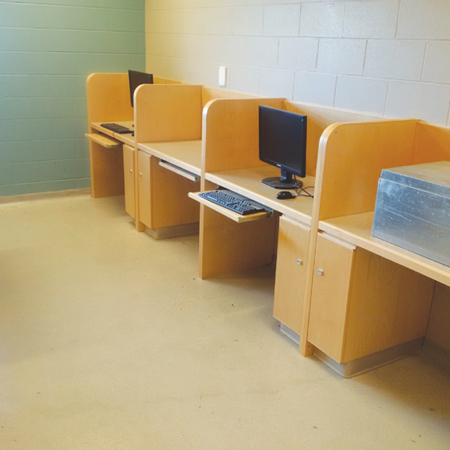
Photo of Computers for
inmate use
As previously raised by my Office, computer literacy continues to be a significant barrier to safe and successful reintegration. Footnote 59 Offender access to and proficiency in the use of computers and the internet can have positive impacts on release outcomes and employability. Federal prisons continue to remain information-deprived environments. On most measures of digital access behind bars, CSC lags far behind other jurisdictions as federal corrections prohibits inmate access to monitored email, online learning and restricted internet use. Since 2002, personal computers have been banned from federal institutions Footnote 60 and inmate libraries remain predominantly book-based. This situation is simply not in keeping with modern correctional philosophy and practice.
CSC's Departmental Plan for 2018-19 includes the creation of a Digital Education Project . Footnote 61 According to the Plan, a pilot project will operate from one minimum security institution, granting access for select offenders to a digital education environment. Though a step in the right direction, this pilot will not be internet equipped, and thus its functionality and curriculum will be limited. I look forward to the day when access to modern learning and education platforms in federal correctional facilities is the norm, not a pilot, or an afterthought.
- I recommend federal prisons join the digital world by providing inmate access to monitored email and Internet, online learning and in-cell tablets.
- I recommend that, based on the Walls to Bridges Program , the Service increase inmate access and capacity to pursue post-secondary studies through partnerships with local universities and colleges.
Missed Opportunities
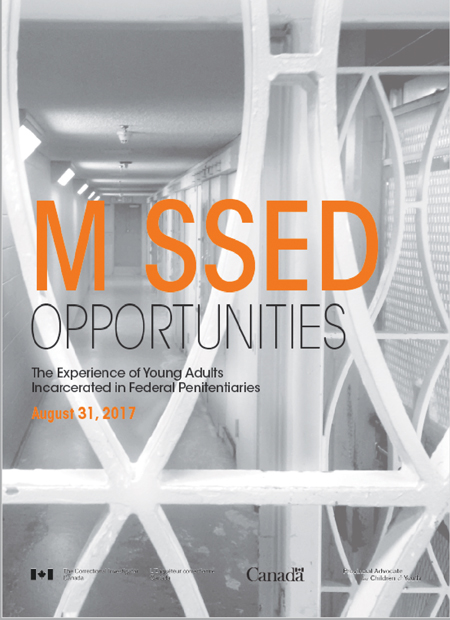
Photo of the
Cover of OCI Special Report,
Missed Opportunities
On August 31, 2017, the Office, in partnership with the Ontario Office of the Provincial Advocate for Children and Youth, released a joint report entitled Missed Opportunities: The Experience of Young Adults Incarcerated in Federal Custody . The report highlights the trajectories of young people in conflict with the law and their experience when they graduate from the provincial youth system to federal adult custody. The report makes it clear that younger adult offenders (ages 18 to 21) have distinct needs that are not recognized or met by the Correctional Service of Canada.
In 2015-16, young adult offenders (ages 18-21) comprised 2.7% of the total federal inmate population. Over the past ten years, the number of young adult inmates in federal custody has declined by 40% after peaking at 661 inmates in 2010-11, corresponding to the general decline in the police-reported crime rate for both youth and young adults. Footnote 62 Federally sentenced young adult women comprise 4.3% (17) of the young adult inmate population. Despite the overall decrease in actual numbers, there remain certain sub-populations of young adults that are over-represented. Young Indigenous inmates represent nearly 2 in 5 inmates 18-21 years of age (38.4%) and young Black inmates represent 12% of the young adult inmate population.
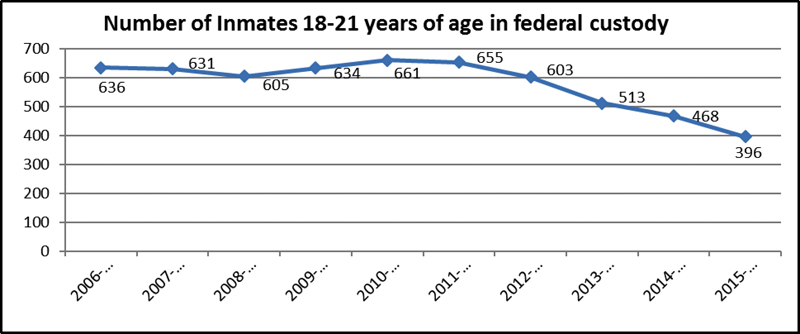
The investigation found that, as a group, young adult offenders have poorer outcomes on many important correctional indicators. When compared to older offenders, inmates 18-21 years of age are more likely to:
- Be rated as having low reintegration potential
- Be placed at a higher security level
- Be placed in involuntary segregation
- Have a gang affiliation
- Self-injure
- Receive disciplinary charges and be found guilty

Photo of an Inmate yard
Instead of a response to the report's 20 recommendations, I received correspondence from the Commissioner acknowledging my report on October 6, 2017, over a month after it had been publicly released. Not one recommendation was specifically addressed. The Commissioner's correspondence indicates that CSC is able to manage the risk and needs of any offender, regardless of age. As I stated in correspondence to the Minister of Public Safety, the findings of my report strongly contradict the current CSC approach. Almost all 94 younger offenders interviewed reported doing very little in terms of productive or rehabilitative activities. The majority were not attending correctional programs or educational classes (they were often waitlisted). The few that were working were doing jobs that required very limited skills, and the few that were attending correctional programs reported difficulties relating certain aspects of the program to their own experience. Interactions with parole officers were infrequent and contact with correctional staff was unhelpful at best. The younger offenders admitted to feeling very unsafe and vulnerable while in federal custody and the Indigenous offenders in particular admitted that they joined gangs as a (misguided) way of obtaining personal protection against abuse, bullying and violence.
The Service's response was thoroughly discouraging and dismissive. In my experience, it is unprecedented for the Service not to respond to recommendations made by the Office in a systemic (national) level investigation. As the title of the report suggests, this is a missed opportunity for CSC to help turn around the lives of young people who, because of their young age and shorter sentences, represent a high potential for success. This transition period should be seen as an opportunity where accommodations and adjustments can be incorporated into correctional processes to ensure these individuals get the help and support they need to live a more productive life in the community. If the cycle is disrupted early, these young people have an opportunity to become law-abiding citizens in the community, thereby substantially reducing the social costs associated with offending. Though the Commissioner's correspondence seems to accept that young people in federal custody have distinct needs, it appears that the Service is not prepared to address the vulnerabilities of this age group specifically, either in policy or practice. I would repeat what I, along with the Ontario Child Advocate stated in the report, CSC is currently squandering an opportunity to help turn a young person's life around.
Missed Opportunities: The Experience of Young Adults Incarcerated in Federal Penitentiaries
The Office partnered with Ontario's Office of the Provincial Advocate for Children and Youth.
What We Investigated
- We conducted individual interviews with 94 young adult offenders 18 to 21 years of age (87 males and 7 females) in four regions (Ontario, Quebec, Atlantic and Prairie) and at all levels of security (minimum, medium and maximum).
- We reviewed relevant law and policy as well as best practices from a number of countries.
What We Found
- There were missed opportunities to have intervened early in the lives of some of these individuals and their families. Many of those interviewed dropped out of school early, had substance abuse problems, were involved with the youth criminal justice system, bounced between foster homes and group homes, and/or had parents struggling with addictions.
- When compared to other inmates, those 18 to 21 years of age serving a determinate sentence were more likely to be serving a shorter sentence, have education and employment needs, be convicted of a violent offence (robbery and assault most commonly) and have a gang affiliation.
- Correctional programs are not tailored or adapted to meet the distinct needs of young adults.
- Young adults (particularly young Indigenous offenders) are over-represented in admissions to segregation and in use of force incidents.
- I recommend that the following five measures be implemented as a means to address key findings from my Missed Opportunities report:
- CSC should develop a Commissioner's Directive highlighting the unique needs of young adults and the importance of focused case management processes that are responsive to young adults (particularly with respect to safety and security, transfers, segregation, security level, and rehabilitative programs and services).
- The frequency of contact between young adults and Parole Officers should be increased to ensure that young individuals are enrolled in correctional programming or education classes or working to gain skills and experience.
- Parole Officers (institutional and community) should receive training specific to younger individuals.
- There should be an increased focus on engaging with young Indigenous offenders through spirituality and culture, including clear, nationally supported strategies for gang dis-affiliation.
- There should be a presumptive prohibition on the use of administrative segregation for young adults under the age of 21 and this presumption should be incorporated into law.
Animal-assisted Therapy Programs

Photo of horses in the
Okimaw Ohchi Horse Program
Correctional interventions involving animals such as therapy dogs can be very beneficial in supporting the well-being of inmates, particularly those who have mental health, addiction or trauma-related issues. Footnote 63 Some research indicates that interactions with animals such as dogs or horses have a variety of positive emotional, physical, social and psychological effects. Interacting with animals has been shown to reduce offenders' feelings of isolation and frustration significantly, while also serving as a means of non-threatening support. Footnote 64 These programs help offenders develop employable skills such as being a team member and, working independently, while also fostering the values of reliability, professionalism and giving back to the community. They also assist in improving communication, social skills and self-esteem.
CSC has implemented animal-assisted interventions in the following institutions:
- Pawsitive Directions at Nova and Drumheller Institutions.
- Dog Boarding and Training Centre at Fraser Valley Institution.
- Nekaneet Horse Program at the Okimaw Ohci Healing Lodge.
- St. John Ambulance Therapy Dog Program at Stony Mountain (minimum sector), and the Regional Psychiatric Centre in Saskatchewan.
- Animal Assisted Therapy program at the Regional Psychiatric Centre.
- Pet Enrichment Program at Bowden Institution.
The programs vary in structure, but can involve the inmates therapeutically interacting with the animals, or training them for work or adoption in the community. The benefits of these programs have an impact not only on the inmates, but also on the animals, institutional staff, and the community that receives the trained animals.
6. FEDERALLY SENTENCED WOMEN
Introduction
A sampling of the cases and issues brought forward and investigated by my Office in women's corrections this past year, and their systemic underpinnings, are enumerated below:
- Application of the two-year rule (over-classification of women offenders).
- Strip searches (without individual suspicion or cause) at Grand Valley Institution for Women (many women offenders are survivors of sexual violence).
- Movement levels system for women classified as maximum security (unequal and discriminatory treatment).
- Population pressures in the Prairie Region (over-representation of Indigenous people in corrections).
- Lack of trauma-informed care models (access to mental health services).

Photo of a Program Poster

Photo of a
Minimum Security Unit,
Fraser Valley Institution for Women
All of these issues, and what gives rise to them, are reminders of the continuing drift from the philosophy and operational principles that were intended to ground women's corrections in Canada. We are not that far removed in time from the enthusiasm that greeted the closing of Canada's only Prison for Women in Kingston, and the opening of the five regional women's facilities in the late 1990s. However, many of the ideas and concepts from a more promising era in women's corrections presumption of minimum security classification at admission for women; no perimeter fencing at the regional women's facilities; no maximum security (Secure Units); no segregation for women offenders have long since been abandoned. As compromises were made, the management of women behind bars has become less distinguishable from the rest of CSC operations.
The Two-Year 'Rule' and the Secure Units
In the late 1990s, following media coverage of certain high profile cases, political direction was given that any offender convicted of first or second degree murder in Canada should serve the first two years of their sentence in a maximum security institution. CSC responded by adjusting the Custody Rating Scale so that classification at intake would essentially align with government direction. Footnote 65 This came to be known as the Two-Year Rule. The Office has often expressed concern with this 'rule' since it was first introduced, as a one-size fits all approach does not adhere to the principles of individualized risk assessment and classification outlined in the Corrections and Conditional Release Regulations . Footnote 66
During the reporting year, my Office received written confirmation from National Headquarters that the so-called 'two-year rule' does not officially exist in policy or law. Historically, CSC has responded to my Office on this matter by outlining that correctional policy provides for an exception that can be applied in certain cases. Footnote 67 I am left to question the necessity of having an exception to a 'rule' that purportedly does not exist.
In any case, the application of this rule is especially concerning, given that it means women convicted of murder will be placed in the Secure Unit (maximum security) at the regional women's facilities to serve their first two years of a life sentence. Last year, my Office found that the Secure Units were a gender-based discriminatory regime that, like the two-year rule, also exists outside the bounds of law. Both practices should be repealed or rescinded.
- I recommend repealing of two related measures that exist outside the law: the two-year rule and the discriminatory movement levels system for women classified as maximum security.
Case Study
The Two Year 'Rule' and Impact
- A federally sentenced woman was convicted 15 years after the offence, and given a life sentence for second-degree murder.
- The offence history involves domestic violence, and this was the individual's first federal sentence.
- Following classification, she was admitted to a maximum security Secure Unit.
- Several months later, the Case Management Team and Warden requested an exception, as her risk was deemed assumable in a medium security setting.
- My Office also recommended that she be reclassified to medium security as she was following her correctional plan and participating in programs.
- The Regional Deputy Commissioner agreed to review a previously denied decision, which stated that the offender's risk factors had not been addressed sufficiently to justify an exception to the policy whereby those serving a sentence for murder must serve the first two years in maximum security.
- We again recommended that this decision be reviewed, and are awaiting a final decision at the regional level.
- The woman had attempted to grieve the initial decision, but was further hindered by a cumbersome and protracted internal grievance system.
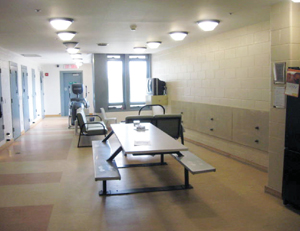
Photo of a
Secure unit common area
Over the past ten years, the number of federally sentenced women inmates has increased by nearly 30%, growing from 534 in 2008 to 684 in 2018. This growth is in contrast to the decrease in the male in-custody population over the same period (decline of 4%). Reflecting Indigenous over-incarceration, the majority of federally sentenced women (35%) are incarcerated in the Prairie Region, followed by the Ontario Region (28%), Quebec (13%), Pacific (12.3%) and Atlantic (11.4%). The Indigenous women population has increased by 53% since 2008, growing from 177 to 271 in 2018. Today, women of Indigenous descent account for 40% of all incarcerated women. In the Prairie Region, Indigenous women comprise 66% of the total women inmate population. Indigenous women continue to be systematically under-represented in community supervision (27%).
As the tables indicate, not all women offenders are incarcerated in their home province, which makes maintaining close ties and relationships to family and the community more challenging. Distance from home community can be a barrier to safe reintegration and rehabilitation. The relatively small number of women offenders in a very large country creates unique economy of scale challenges in women's corrections. The situation today is, of course, considerably better than when there was only a single penitentiary (P4W in Kingston). Nevertheless, mitigation strategies can improve the situation for women in custody who are removed from their home communities. This is a particular problem for women convicted or sentenced in the Prairie and Atlantic provinces, although even the vast distances in Ontario and Quebec create challenges.
| Sentencing Province | In-Custody | Community Under Supervision | Total |
|---|---|---|---|
| Alberta | 144 | 110 | 254 |
| British Columbia | 38 | 78 | 116 |
| Manitoba | 51 | 43 | 94 |
| New Brunswick | 21 | 20 | 41 |
| Newfoundland and Labrador | 13 | 17 | 30 |
| Northwest Territories | 1 | 3 | 4 |
| Nova Scotia | 22 | 41 | 63 |
| Nunavut | 1 | 1 | 2 |
| Ontario | 195 | 199 | 394 |
| Prince Edward Island | 1 | 3 | 4 |
| Quebec | 82 | 98 | 180 |
| Saskatchewan | 90 | 65 | 155 |
| Yukon Territory | 2 | 4 | 6 |
| Other | 1 | 21 | 22 |
| Unknown | 14 | 18 | 32 |
| Total | 676 | 721 | 1,397 |
| Federal Institution | Percentage |
|---|---|
| Edmonton Institution for Women | 64% |
| Fraser Valley Institution | 48% |
| Grand Valley Institution | 94% |
| Joliette Institution | 83% |
| Nova Institution for Women | 28% |
| Okimaw Ohci Healing Lodge | 48% |
| Regional Psychiatric Centre (Prairies) | 40% |
- I recommend CSC conduct a review to ensure a full range of mitigating strategies are in place to support rehabilitation and reintegration of women offenders who are removed from their home provinces or communities, including establishing new section 81 agreements.
Mental Health Needs Profile
The number of in-custody women with challenging and complex mental health needs and behaviours, including chronic or serial self-injurious behaviour, is a matter of increasing concern for my Office. Recent CSC research found that almost 80% of incarcerated women meet the criteria for some current mental disorder. The highest prevalence rates were for lifetime alcohol and substance use disorders (76%) and current anxiety disorders (54%). Prevalence rates were also high for Post-Traumatic Stress Disorder where nearly one-third of all women met the criteria. Even when Antisocial Personality Disorder and alcohol and substance use disorders are not considered, rates still remain high; two-thirds meet the criteria for a current diagnosis and, among these, 38% are suffering a serious impairment because of their diagnosis.
Prevalence Rates for Current Diagnosis of Major Mental Disorders among Incarcerated Women
| Disorder | Percentage |
|---|---|
| Any disorder | 79.2% |
| Mood disorder | 22.1% |
| Psychotic disorders | 4.6% |
| Alcohol/substance use disorders (lifetime) | 76% |
| Anxiety disorders | 54.2% |
| Eating disorders | 11% |
| Borderline Personality Disorder (lifetime only) | 33.3% |
| Antisocial Personality Disorder (lifetime only) | 49.4% |
Source: CSC, Rates of current mental disorders among women offenders in custod y (June 2017).
Self-injury among Women Offenders
Self-inflicted injuries among federally sentenced women have nearly quadrupled in ten years (79 incidents in 2008-09 to 305 in 2017-18). Over this period, the number of self-injurious incidents has fluctuated from a low of 79 in 2008-09 to a high of 524 in 2013-14. The number of women engaging in self-injurious behaviour has also fluctuated. In 2017-18, there were 305 incidents involving 60 different women. Thirty-one (31) were Indigenous women, who also accounted for half of all incidents in women's corrections. In total, women accounted for almost one third of all self-injurious incidents in federal corrections (men and women combined).

Source: CSC Data warehouse, April 2018
Management of Complex Mental Health Needs
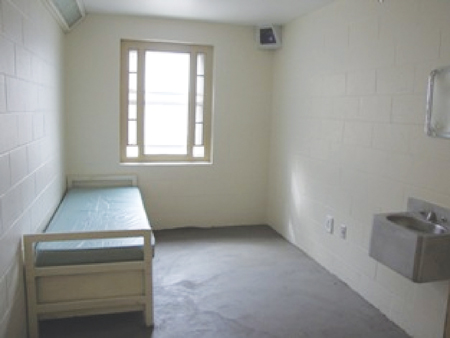
Photo of an Observation cell
at a women's institution
My Office continues to be concerned with the management of women who present with complex needs in inappropriate and ill-equipped settings, including the Secure Units (maximum security). In a 15-month period between April 2015 and July 2016, three federally sentenced women died in custody. Following these deaths, my Office sent correspondence to the Minister of Public Safety highlighting how the federal correctional system had failed these women. I continue to feel that this issue is in need of a substantive and urgent response. It is clear that not all the lessons learned or recommendations made after Ashley Smith's preventable death in October 2007 were applied to keep these women safe. We should not have to wait for the results of inquests or the findings and lessons from internal investigations to comprehensively address these issues.
In August 2017, my Office received a copy of CSC's National Board of Investigation report into the death of Ms. Terry Baker, who died in federal custody in July 2016. I want to take this opportunity to extend my condolences to her family, who are aware of my legislative mandate and the importance of and need for transparency and accountability in these matters. A Coroner's inquest will hopefully provide a clearer and comprehensive review of what happened and how best to prevent such tragedies. This young woman had complex mental health needs, including an extremely low range of cognitive function and a prior history of psychiatric hospitalization. Despite clinical assessments which clearly cautioned against the use of segregation, a practice which was known to significantly increase her risk of self-harming or suicidal behaviour, her death occurred in a segregation cell at one of the regional women's institutions. There was no enhanced monitoring while she was segregated, despite her previous risk and history. This case is yet another tragic reminder that federal penitentiaries are ill-equipped to safely and appropriately manage the complex mental health needs of some women inmates who engage in chronic and serious self-injurious behaviour.
Case Study
Death in Custody of Ms. Terry Baker
Case History
Ms. Baker was a first time federally sentenced woman. She self-reported substance use at an early age, bullying at school, sexual assault as a teenager, leaving her adopted family and living with friends or at shelters at a young age and early self-injurious behaviour. Following her crime and incarceration, she developed complex mental health issues and a significant history of self-injurious and suicidal behaviour.
In nearly ten and a half years in federal custody, this young woman:
- Engaged in more than 300 recorded incidents of self-injury cutting, head-banging, punching herself, prescription drug misuse, tying ligatures around her neck, ingesting non-food objects.
- Amassed 64 institutional charges (27 serious and 37 minor). Like other chronic self-injurious women offenders, she had a history of assaultive, threatening and resistive behaviour. She was convicted of four new criminal charges while incarcerated.
- Was placed on segregation status 20 times. Eleven (11) of these placements were for self-injurious behaviour. On numerous occasions, she was also placed on observation status (located on the segregation range) and/or clinical seclusion (once for 4 months and another time for two months).
- Was the subject of 56 documented use of force interventions.
- Spent over half of her federal sentence in a specialized mental health facility:
- two years at Philippe Pinel Institute.
- three years at the Regional Psychiatric Centre.
- Certified under the Ontario Mental Health Act twelve different times.
- Was prescribed several different classes of psychotropic medications including: antidepressant, mood stabilizing, antipsychotic, anti-anxiety and ADHD medications.
To its credit, CSC's internal National Board of Investigation and report into the death of Ms. Baker was complete and thorough. The Board's report was unique in that it contained a dissenting opinion authored by co-members of the Board who were not in agreement with some of the findings or areas for improvement identified by the Chair in the final report. Findings from the report indicate that Ms. Baker's self-injurious and suicidal behaviour were pre-incident indicators to her suicide and that her history of mental health issues was a contributing risk factor. The report explicitly states that her mental health needs were a poor fit for a correctional environment. I could not agree more.
The report also contains a lessons learned section on best practices in the management of chronic self-injurious behaviours. Among other measures, it stresses:
- Intense levels of treatment and management interventions (often security-focussed) in response to self-injurious behaviour can increase rather than decrease distress and dysregulation resulting in further self-injurious and suicidal behaviour.
- Movement away from the use of restraints for self-injuring individuals. Protective factors for self-injury and suicide in prison include: less time locked in a cell; employment; association; programs and regular and good quality contact with family.
- Zero tolerance for self-injurious behaviour reinforces the use of static control tactics seclusion, segregation and restraint and needs to give way to a harm reduction model. This means providing individuals who self-harm with more autonomy, expanding the definition of success and focusing on symptom management, skill-building and personal development.
- Movement away from security-based responses Negative or punitive responses don't work.
- Regular reassessment of treatments and interventions, particularly when the desired outcomes are not evident.
- More emphasis on suicide risk assessment and understanding of risk and protective factors, including meaningful programs and interventions
- Release and community treatment in situations where self-injury and suicidal behaviour are intricately linked to incarceration.
While the findings of this Board of Investigation, including the dissenting opinion, are encouraging, the track record of the Service in these kind of complex and challenging cases is not. Since Ashley Smith's death in October 2007, the Service has received numerous reports and recommendations from my Office, Coroners, Medical Examiners and internal Boards of Investigations into incidents involving serious bodily injury or self-inflicted death. These areas continue to be routinely cited as areas for improvement. Several years later, key recommendations arising from internal and external reviews remain unfulfilled. Specifically, there has been little movement on the following measures:
- organizational commitment to move toward a restraint-free environment in federal corrections;
- appointment of independent Patient Advocates at each of the Regional Treatment Centres;
- provision of 24/7 on-site nursing coverage at all maximum, medium and multi-level penitentiaries;
- establishment of a senior management position within CSC exclusively responsible for promoting, monitoring and ensuring Safe Custody practices;
- prohibition on Secure Unit placements to house complex needs women;
- prohibition on segregation and clinical seclusion placements for seriously mentally ill offenders;
- expansion of community bed treatment capacity to accommodate up to 12 women requiring an intensive level of mental health intervention.
Chronic self-injurious and suicidal individuals should be moved to external psychiatric hospitals. They do not belong in a federal penitentiary. Though CSC will continue to cite a number of systemic barriers that impede its ability to effect outsourcing of complex cases to external facilities per diem costs, informed consent and voluntary treatment protocols, reluctance of community providers to accept high need/high risk offenders, barriers to certification under provincial mental health law and lack of treatment space these are not insurmountable issues. CSC should either invest or partner with the provinces and territories to build the required capacity or outsource care. Going forward, it is clear that collaboration among provincial and territorial Ministers of Justice, Public Safety and Health is necessary.
I recognize that the management and treatment of chronic self-injury in correctional facilities is extremely demanding and challenging work. Ms. Baker is but one of a handful of complex cases in women's corrections whose management requires thinking outside the prison cell. Ms. Baker's self-injurious behaviours were intricately tied to and exacerbated by incarceration. In these complex cases, community treatment should be explored as an option. In acknowledging this, I do not question the integrity or commitment of CSC's efforts. However, the limits and inappropriateness of managing serious chronic self-injury behaviour, acute mental illness or significant cognitive deficits in segregation or maximum security settings (Secure Units) needs to be more frankly acknowledged and resolutely addressed so we do not have another death similar to Ms. Baker's.
- I once again recommend that the Service use section 29 provisions of the Corrections and Conditional Release Act to transfer patients who present with serious mental health needs, suicidal or chronic self-injurious behaviours and cannot be safely managed in a penitentiary setting to the care of external psychiatric facilities.
Correctional Investigator's Outlook for 2018-19
First of all, I look forward to working with the next Commissioner of Corrections and welcome the opportunity to do so. In the year ahead, I would be looking to engage the Service on some of major issues and implications emerging from this report, namely:
- the Service's response to my investigation of the Saskatchewan Penitentiary riot, inclusive of the manner and means by which CSC investigates itself after a serious incident;
- clinical independence and health care governance in corrections;
- outsourcing care for complex needs patients who cannot be safely managed in a federal penitentiary;
- follow-up measures related to young adults in federal custody;
- progress and leadership on Indigenous issues in corrections.
In 2018-19, I also look forward to releasing a joint report between my Office and the Canadian Human Rights Commission examining issues facing older/aging offenders in Canada. I have already engaged with a number of external stakeholders and there are considerable expectations that an issue long hidden from view will finally capture public and policy attention.
There is, of course, outstanding business concerning reform of administrative segregation (solitary confinement) law. Bill C-56 was tabled in Parliament in June 2017. It includes provisions for 21-day presumptive release from segregation and for an independent reviewer to recommend to CSC whether an inmate should be released or maintained in segregation when certain criteria are met. I expect the proposed legislation to be closely scrutinized as it makes its way through the Parliamentary process. It is unlikely that the Bill, as introduced in Parliament, will satisfy more recent court rulings that have found current administrative segregation law to offend the principles of fundamental justice and violate Section 7 of the Charter protecting the right to life, liberty and security of the person. Parliament has an unprecedented opportunity to bring a practice that has been over-used in the past in line with evolving international human rights standards and law. I would note that Ontario moved forward with legislation that is now more progressive and consistent with international standards. The federal government must now play catch-up.
Finally, for a number of years this Office has urged Canada to sign and ratify the Optional Protocol to the Convention against Torture (OP-CAT). This international human rights instrument, which at last count had more than 100 state signatories, would create a national mechanism responsible for carrying out periodic inspections of all places of detention in Canada. I understand that consultations have occurred with the provinces and territories concerning potential Canadian accession to the OP-CAT. While there is no doubt that implementing OP-CAT would require each level of government to make legislative amendments as well as changes to the mandates of existing bodies, I am of the view that the necessary legal and policy work should not delay Canada signing onto the treaty. Even after signing, Canada would still have two years to ratify and bring domestic practice and law into compliance with OP-CAT obligations. Signing would send the right message and would keep the federal/provincial/territorial consultative process on a defined timetable toward Canadian accession and eventual ratification. Other federated states, with equally complex jurisdictional issues, have ratified OP-CAT, including Argentina, Germany, and, most recently, Australia. Complexity is not an excuse for delays or not doing the right thing.
Ed McIsaac Human Rights in Corrections Award
The Ed McIsaac Human Rights in Corrections Award was established in December 2008, in honour of Mr. Ed MsIsaac, long-time Executive Director of the Office of the Correctional Investigator and strong promoter and defender of human rights in federal corrections. It commemorates outstanding achievement and commitments to improving corrections in Canada and protecting the human rights of the incarcerated.
The 2017 recipient of the Ed McIsaac Human Rights in Corrections award was Mr. Rick Sauv, prisoner advocate and in-reach worker with the St. Leonard's Society of Canada.
<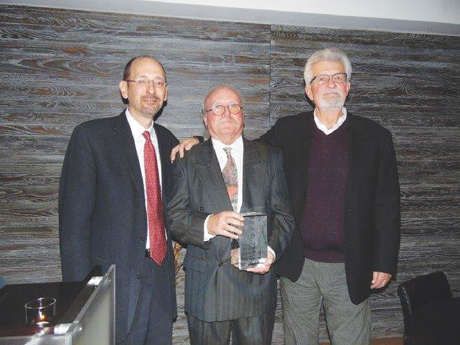
Photo Left to Right: Dr. Ivan Zinger, Mr. Rick Sauv and Mr. Ed McIsaac
Annex A: Summary of Recommendations
- I recommend that Public Safety Canada develop a nationally maintained recidivism database that links federal, provincial, and territorial jurisdictions. This database should publicly report on reoffending before and after warrant expiry dates (WED), for both violent and non-violent offences, and should include post-WED follow-up periods of at least two and five years.
- I recommend that the incoming Commissioner of Corrections initiate a prioritized review of the effectiveness of internal monitoring and performance mechanisms, inclusive of use of force reviews, the National Board of Investigation process, inmate complaint and grievance system, staff discipline, audits, evaluations, communications and public reporting functions.
- I recommend that there be no exceptions written into or provided for in CSC policy allowing MAID to take place in a facility under federal correctional authority or control. Internal policy should simply state that a request for MAID from a federal inmate who is terminally ill will be evaluated on a case-by-case basis.
- I recommend that, in cases of terminal illness where death is reasonably foreseen, there should be proactive and coordinated case management between CSC and the Parole Board of Canada to facilitate safe and compassionate community release in the timeliest manner possible.
- I recommend that the CSC develop arrangements with external hospice and palliative care providers in each Region to ensure adequate and appropriate bed space is in place to release palliative or terminally ill patients to the community.
- I recommend strengthening CSC's health care governance structure through the following accountability and assurance measures:
- Complete separation of health care budgets from prison administration.
- More team-based and shared models of primary care, including closer monitoring, charting and follow-up of individual treatment plans.
- Practical and ongoing judgement-based and ethical training of correctional health care professionals.
- Coordination, oversight and monitoring of transitions in physical and mental health care (e.g. transfers between CSC facilities, releases to the community, transfers to external health care providers, transfers to and returns from Regional Treatment Centres).
- A system of regular peer reviews, medical chart audits and evaluations of medical staff conducted at the national level.
- I recommend that CSC ensure security staff working in a Regional Treatment Centre be carefully recruited, suitably selected, properly trained and fully competent to carry out their duties in a secure psychiatric hospital environment.
- I recommend that independent Patient Advocates be assigned to each Treatment Centre, whose role and responsibilities include providing inmate patients with advice, advocacy and support and ensuring their rights are fully understood, respected and protected. The Patient Advocates could also serve as expert resources for other CSC facilities in each Region.
- I recommend that in 2018-19 CSC conduct an evaluation of its new Engagement and Intervention Model.
- I recommend that the Minister of Public Safety conduct an independent review of the National Board of Investigation section 19 process to enhance transparency, credibility, integrity and accountability of investigations convened and conducted by the Correctional Service of Canada. This review would consider an option for the Minister to authorize an external and independent investigation into major disturbances (riots) resulting in injury or death, suicides in segregation and use of force interventions leading to serious bodily injury or death.
- I recommend that the CSC conduct an external audit of its Food Services Modernization initiative (National Menu and Cook-Chill). The audit should review cost of the implementation and impact of this initiative on inmate employment and canteen purchases.
- I recommend that CSC creates and appoints a Deputy Commissioner level position for Indigenous Affairs to ensure that corporate attention and accountability remains focused on Indigenous issues in federal corrections.
- I recommend that CSC re-allocate very significant resources to negotiate new funding arrangements and agreements with appropriate partners and service providers to transfer care, custody and supervision of Indigenous people from prison to the community. This would include creation of new section 81 capacity in urban areas and section 84 placements in private residences. These new arrangements should return to the original vision of the Healing Lodges and include consultation with Elders.
- To honour the Truth and Reconciliation Commission's 'calls to action,' I recommend that CSC spending, budget and resource allocation should better reflect the proportion of Indigenous people serving a federal sentence. Over the next decade, re-allocation of resources and delegation of control to Indigenous communities should be the stated goals of CSC's contribution to reaching the TRC's 'calls to action.'
- I recommend that the CSC develop a National Gang and Dis-Affiliation Strategy and ensure sufficient resources are allocated for its implementation, inclusive of (core and cultural) programs, employment and services. Special attention should be paid to Indigenous-based street gangs. This strategy should:
- be responsive to the unique needs of young Indigenous men and women offenders, including education and meaningful vocational opportunities;
- ensure that non-gang affiliated young adult offenders are not placed where there are gang members who may attempt to recruit or intimidate them;
- facilitate opportunities (e.g. workshops, seminars, public speakers, etc.) where young adults can engage with their culture and/or spirituality, and age-specific activities;
- incorporate best practices and lessons learned from other jurisdictions and other public safety domains.
- I recommend federal prisons join the digital world by providing inmate access to monitored email and internet, online learning and in-cell tablets.
- I recommend that, based on the Walls to Bridges Program , the Service increase inmate access and capacity to pursue post-secondary studies through partnerships with local universities and colleges.
- I recommend that the following five measures be implemented as a means to address key findings from my Missed Opportunities report:
- CSC should develop a Commissioner's Directive highlighting the unique needs of young adults and the importance of focused case management processes that are responsive to young adults (particularly with respect to safety and security, transfers, segregation, security level, and rehabilitative programs and services).
- The frequency of contact between young adults and Parole Officers should be increased to ensure that young individuals are enrolled in correctional programming or education classes or working to gain skills and experience.
- Parole Officers (institutional and community) should receive training specific to younger individuals.
- There should be an increased focus on engaging with young Indigenous offenders through spirituality and culture, including clear, nationally supported strategies for gang dis-affiliation.
- There should be a presumptive prohibition on the use of administrative segregation for young adults under the age of 21 and this presumption should be incorporated into law.
- I recommend repealing of two related measures that exist outside the law: the two-year rule and the discriminatory movement levels system for women classified as maximum security.
- I recommend CSC conduct a review to ensure a full range of mitigating strategies are in place to support rehabilitation and reintegration of women offenders who are removed from their home provinces or communities, including establishing new section 81 agreements.
- I once again recommend that the Service use section 29 provisions of the Corrections and Conditional Release Act to transfer patients who present with serious mental health needs, suicidal or chronic self-injurious behaviours and cannot be safely managed in a penitentiary setting to the care of external psychiatric facilities.
Annex B: Annual Statistics
Table A: Complaints By Category
Internal Response (2), Inquiries and Investigations (3)
| Category | I/R(2) | Inv(3) | Total |
|---|---|---|---|
| Administrative Segregation | |||
| Conditions | 23 | 50 | 73 |
| Placement/Review | 41 | 109 | 150 |
| Total | 64 | 159 | 223 |
| Case Preparation | |||
| Conditional Release | 15 | 17 | 32 |
| Post Suspension | 5 | 5 | 10 |
| Temporary Absence | 0 | 1 | 1 |
| Transfer | 2 | 9 | 11 |
| Total | 22 | 32 | 54 |
| Cell Effects | 195 | 217 | 412 |
| Cell Placement | 14 | 27 | 41 |
| Claim | |||
| Decisions | 9 | 10 | 19 |
| Processing | 17 | 17 | 34 |
| Total | 26 | 27 | 53 |
| Community Programs/Supervision | 43 | 28 | 71 |
| Conditional Release | |||
| Conditions | 32 | 22 | 54 |
| Day Parole | 9 | 17 | 26 |
| Full Parole | 13 | 12 | 25 |
| Detention | 2 | 4 | 6 |
| Revocation | 32 | 46 | 78 |
| Total | 88 | 101 | 189 |
| Conditions of Confinement | |||
| Behavioural Contract | 3 | 0 | 3 |
| Food Services | 41 | 46 | 87 |
| Lockdown | 31 | 24 | 55 |
| Special Units | 10 | 9 | 19 |
| Recreation Time | 6 | 23 | 29 |
| Other | 339 | 302 | 641 |
| Total | 430 | 404 | 834 |
| Correspondence | 70 | 79 | 149 |
| Death or Serious Injury | 9 | 8 | 17 |
| Decisions (General) - Implementation | 16 | 15 | 31 |
| Diets | |||
| Medical | 5 | 18 | 23 |
| Religious | 11 | 25 | 36 |
| Total | 16 | 43 | 59 |
| Discipline | |||
| ICP Decisions | 1 | 3 | 4 |
| Minor Court Decisions | 8 | 5 | 13 |
| Procedures | 10 | 14 | 24 |
| Total | 19 | 22 | 41 |
| Discrimination | 7 | 9 | 16 |
| Double Bunking | 3 | 3 | 6 |
| Employment | 49 | 51 | 100 |
| Financial Matters | |||
| Access | 32 | 33 | 65 |
| Pay | 16 | 26 | 42 |
| Total | 48 | 59 | 107 |
| Grievance | |||
| 3rd Level Review | 18 | 26 | 44 |
| Decision | 9 | 18 | 27 |
| Procedure | 42 | 64 | 106 |
| Total | 69 | 108 | 177 |
| Harassment | 30 | 23 | 53 |
| Health and Safety - Inmate Worksites/ Programs | 6 | 5 | 11 |
| Health Care | |||
| Access | 150 | 259 | 409 |
| Decisions | 33 | 38 | 71 |
| Dental | 26 | 26 | 52 |
| Medication | 130 | 145 | 275 |
| Methadone | 13 | 15 | 28 |
| Total | 354 | 483 | 835 |
| Hunger Strike | 6 | 14 | 20 |
| Immigration/Deportation | 1 | 1 | 2 |
| Information | |||
| Access/Disclosure | 47 | 24 | 71 |
| Correction | 26 | 29 | 55 |
| Total | 73 | 53 | 126 |
| Inmate Requests | 18 | 13 | 31 |
| IONSCAN | 0 | 1 | 1 |
| Legal Counsel Access/Quality | 35 | 25 | 60 |
| Mental Health | |||
| Access/Programs | 12 | 29 | 41 |
| Quality | 4 | 7 | 11 |
| Self-Injury | 1 | 23 | 24 |
| Total | 17 | 59 | 76 |
| Official Languages | 3 | 6 | 9 |
| Operation/Decisions of the OCI | 23 | 13 | 36 |
| Outside Court | 9 | 2 | 11 |
| Program/Services | |||
| Women | 0 | 1 | 1 |
| Aboriginal | 4 | 5 | 9 |
| Access | 22 | 46 | 68 |
| Decisions | 9 | 13 | 22 |
| Other | 22 | 16 | 38 |
| Total | 57 | 81 | 138 |
| Provincial Matter | 7 | 2 | 9 |
| Release Procedures | 47 | 35 | 82 |
| Religious/Spiritual | 15 | 21 | 36 |
| Safety/Security | |||
| Security of Offender | 27 | 51 | 78 |
| Incompatibles | 14 | 35 | 49 |
| Worksite | 1 | 1 | 2 |
| Total | 42 | 87 | 129 |
| Search and Seizure | 21 | 12 | 33 |
| Security Classification | 38 | 90 | 128 |
| Sentence Administration | 8 | 5 | 13 |
| Special Handling Unit - Review | 1 | 0 | 1 |
| Staff | 243 | 287 | 530 |
| Telephone | 84 | 85 | 169 |
| Temporary Absence | |||
| Escorted | 11 | 42 | 53 |
| Unescorted | 5 | 9 | 14 |
| Total | 16 | 51 | 67 |
| Temporary Absence Decision | 2 | 5 | 7 |
| Transfer | |||
| Implementation | 19 | 22 | 41 |
| Involuntary | 50 | 124 | 174 |
| Penitentiary Placement | 8 | 26 | 34 |
| Section 81/84 | 0 | 0 | 0 |
| Voluntary | 37 | 67 | 104 |
| Total | 114 | 239 | 353 |
| Urinalysis | 13 | 15 | 28 |
| Use of Force | 15 | 43 | 58 |
| Visits | 76 | 138 | 214 |
| Grand Total | 5846 | ||
Table B: Complaints By Institution/Region (*)
| Region / Institution | Number of Complaints | Number of Interviews | Number of Days Spent in Institutions |
|---|---|---|---|
| FSW | |||
| Edmonton Women Facility | 138 | 39 | 9 |
| Fraser Valley | 72 | 19 | 6 |
| Grand Valley | 123 | 52 | 13 |
| Joliette | 118 | 50 | 12 |
| Nova | 61 | 22 | 6 |
| Okimaw Ohci Healing Lodge | 16 | 6 | 2 |
| Buffalo Sage Wellness House | 0 | 2 | 1 |
| Total | 528 | 190 | 49 |
| Atlantic | |||
| Atlantic | 252 | 73 | 18 |
| Dorchester | 282 | 75 | 9 |
| Shepody Healing Centre | 18 | 5 | 3 |
| Springhill | 121 | 37 | 9 |
| Total | 673 | 190 | 39 |
| Ontario | |||
| Bath | 147 | 71 | 8 |
| Beaver Creek | 152 | 58 | 10 |
| Collins Bay | 105 | 58 | 9 |
| Joyceville | 142 | 31 | 5 |
| Millhaven | 212 | 51 | 11 |
| RTC Bath/Millhaven | 27 | 12 | 2 |
| Warkworth | 215 | 78 | 14 |
| Total | 1000 | 359 | 59 |
| Pacific | |||
| Kwikwxwelhp | 7 | 4 | 1 |
| Kent | 276 | 85 | 12 |
| Matsqui | 127 | 24 | 9 |
| Mission | 167 | 46 | 9 |
| Mountain | 260 | 112 | 9 |
| Pacific/RTC | 120 | 36 | 9 |
| William Head | 25 | 7 | 1 |
| Total | 982 | 314 | 50 |
| Prairies | |||
| Bowden | 153 | 24 | 6 |
| Drumheller | 179 | 39 | 6 |
| Edmonton | 242 | 56 | 10 |
| Grande Cache | 93 | 31 | 5 |
| Grierson Centre | 29 | 13 | 1 |
| Stan Daniels | 6 | 1 | 2 |
| Pe Saskatew | 12 | 8 | 2 |
| Regional Psychiatric Centre | 158 | 35 | 7.5 |
| Saskatchewan Penitentiary | 274 | 95 | 18 |
| Stony Mountain | 172 | 66 | 9.5 |
| Willow Cree | 2 | 1 | 2 |
| Total | 1320 | 369 | 69 |
| Qubec | |||
| Archambault | 138 | 35 | 10 |
| Archambault CRSM | 11 | 10 | 2 |
| Cowansville | 71 | 23 | 8 |
| Donnacona | 177 | 78 | 11 |
| Drummond | 65 | 14 | 5 |
| Federal Training Centre | 141 | 63 | 15 |
| La Macaza | 38 | 22 | 6 |
| Port Cartier | 175 | 78 | 16 |
| Regional Reception Centre Qubec | 196 | 49 | 8 |
| Special Handling Unit | 48 | 34 | 4 |
| Waseskun Healing Lodge | 0 | 0 | 1 |
| Total | 1060 | 406 | 86 |
| CCC/CRC/ Parolees in Community | 273 | 0 | 0 |
| Federal Inmates in Provincial Institutions | 10 | 0 | 0 |
| Grand Total | 5846 | 1828 | 352 |
Table C: Complaints and Inmate Population - By Region
| Region | Total Number of Complaints | Inmate Population (*) |
|---|---|---|
| Atlantic | 674 | 1223 |
| Quebec | 1060 | 2955 |
| Ontario | 1000 | 3423 |
| Prairie | 1320 | 3833 |
| Pacific | 982 | 2091 |
| Women's Facilities | 527 | 680 |
| CCC/CRC/Community/Provincial Facilities | 283 | N/A |
| Grand Total | 5846 | 14,205 |
* Inmate Population broken down by Region: As of May 22, 2018, according to the Correctional Service of Canada's Corporate Reporting System.
Table D: Disposition of Complaints by Action
| Action | Disposition | Number of Complaints |
|---|---|---|
| Internal Response | ||
| Advice/Information Given | 1460 | |
| Assisted by Institution | 164 | |
| Refer to Grievance Process | 202 | |
| Refer to Institutional Staff | 497 | |
| Refer to Warden | 56 | |
| Rejected as Unfounded | 44 | |
| Systemic/Multiple | 34 | |
| Withdrawn | 103 | |
| Total | 2560 | |
| Inquiry | ||
| Advice/Information Given | 899 | |
| Assisted by Institution | 798 | |
| Refer to Grievance Process | 171 | |
| Refer to Institutional Staff | 346 | |
| Refer to Warden | 137 | |
| Rejected as Unfounded | 115 | |
| Systemic/Multiple | 44 | |
| Withdrawn | 35 | |
| Total | 2545 | |
| Investigation | ||
| Advice/Information Given | 192 | |
| Assisted by Institution | 235 | |
| Refer to Grievance Process | 35 | |
| Refer to Institutional Staff | 79 | |
| Refer to Warden | 61 | |
| Rejected as Unfounded | 83 | |
| Systemic/Multiple | 49 | |
| Withdrawn | 7 | |
| Total | 741 | |
| Grand Total | 5846 | |
Table E: Areas of Concern Most Frequently Identified by Offenders
| Category | # | % |
|---|---|---|
| Total Offender Population | ||
| Health Care | 826 | 14.13% |
| Conditions of Confinement | 761 | 13.02% |
| Staff | 530 | 9.07% |
| Cell Effects | 412 | 7.05% |
| Transfer | 353 | 6.04% |
| Administrative Segregation | 223 | 3.81% |
| Visits | 214 | 3.66% |
| Parole Decisions | 181 | 3.10% |
| Grievance | 177 | 3.03% |
| Telephone | 169 | 2.89% |
| Indigenous Offenders | ||
| Health Care | 181 | 14.25% |
| Conditions of Confinement | 173 | 13.62% |
| Staff | 138 | 10.87% |
| Transfer | 73 | 5.75% |
| Cell Effects | 72 | 5.67% |
| Administrative Segregation | 63 | 4.96% |
| Safety/Security | 43 | 3.39% |
| Telephone | 39 | 3.07% |
| Visits | 35 | 2.76% |
| Parole Decisions | 35 | 2.76% |
| Women Offenders | ||
| Conditions of Confinement | 99 | 17.68% |
| Health Care | 79 | 14.11% |
| Staff | 51 | 9.11% |
| Cell Effects | 38 | 6.79% |
| Security Classification | 21 | 3.75% |
| Temporary Absence | 20 | 0.89% |
| Transfer | 18 | 3.21% |
| Safety/Security | 17 | 3.04% |
| Visits | 17 | 3.04% |
| Administrative Segregation | 15 | 2.68% |
Annex C: Other Statistics
A. Mandated Reviews Conducted in 2017-18
As per the Corrections and Conditional Release Act (CCRA), the Office of the Correctional Investigator reviews all CSC investigations involving incidents of inmate serious bodily injury or death.
Mandated Reviews by Type of Incident
| Assault | 70 |
| Murder | 1 |
| Suicide | 6 |
| Attempted Suicide | 8 |
| Self-Harm | 5 |
| Injuries (Accident) | 11 |
| Overdose Interrupted | 7 |
| Death (Natural Cause)* | 22 |
| Death (Unnatural Cause) | 7 |
| Total | 137 |
* Deaths due to 'natural causes' are investigated under a separate Mortality Review process involving a file review conducted at National Headquarters.
B. Use of Force Reviews Conducted by the OCI in 2017-18
The Correctional Service is required to provide all pertinent and relevant use of force documentation to the Office. Use of force documentation typically includes:
- Use of Force Report
- Copy of incident-related video recording
- Checklist for Health Services Review of Use of Force
- Post-incident Checklist
- Officer's Statement/Observation Report
- Action plan to address deficiencies
OCI Use of Force Statistics for 2017-2018
| Atlantic Region | Quebec Region | Ontario Region | Prairie Region | Pacific Region | Federally Sentenced Women | National | |
|---|---|---|---|---|---|---|---|
| Reported incidents reviewed by the OCI | 136 | 283 | 286 | 469 | 195 | 118 | 1,487 |
| Use of force measures applied | |||||||
| Emergency Response Team | 18 | 14 | 27 | 19 | 19 | 3 | 100 |
| Verbal intervention | 118 | 247 | 244 | 404 | 172 | 104 | 1,289 |
| Physical Handling | 92 | 159 | 186 | 296 | 143 | 90 | 966 |
| Restraint equipment | 21 | 220 | 187 | 230 | 122 | 52 | 832 |
| Use of OC (Inflammatory Agent) | 100 | 244 | 159 | 304 | 131 | 56 | 994 |
| Use of CS (Chemical Agent) | 56 | 152 | 142 | 197 | 93 | 74 | 714 |
| Distraction Device | 3 | 0 | 0 | 7 | 0 | 0 | 10 |
| Shield | 4 | 4 | 19 | 17 | 9 | 5 | 58 |
| Baton | 1 | 2 | 8 | 6 | 2 | 1 | 20 |
| Display/Charging Firearm | 4 | 1 | 0 | 7 | 0 | 0 | 12 |
| Use of firearm-Warning Shot | 2 | 1 | 1 | 12 | 0 | 0 | 16 |
| Use of firearmAimed Shot | 0 | 0 | 0 | 0 | 0 | 0 | 0 |
| Indicators of concerns | |||||||
| Aboriginal | 35 | 60 | 89 | 181 | 40 | 74 | 479 |
| Women | 32 | 7 | 13 | 48 | 18 | - | 118 |
| Mental Health Issues identified (CSC) | 82 | 94 | 142 | 191 | 52 | 73 | 634 |
| Injuries | |||||||
| Injuries to offender | 0 | 30 | 19 | 7 | 1 | 2 | 59 |
C. Toll-Free Contacts in 2017-18
Offenders and members of the public can contact the OCI by calling our toll-free number (1-877-885-8848) anywhere in Canada. All communications between offenders and the OCI are confidential.
Number of toll-free contacts received in the reporting period: 24,578
Number of minutes recorded on toll-free line: 81,927
D. National Level Investigations in 2017-18
- Missed Opportunities: The Experience of Young Adults Incarcerated in Federal Penitentiaries. Joint Investigation with the Provincial Advocate for Children & Youth, (August 31, 2017)
- Investigation into the Riot at Saskatchewan Penitentiary (date of 2017-18 Annual Report tabling)
E. Web Statistics for 2017-18
Total Hits: 25 Million
Total Page Views: 20.6 Million
Response to the Annual Report of the Office of the Correctional Investigator 2017-2018
2017-2018 OCI Annual Report
Public Safety Canada Recommendations and Response
Ministers Introductory Message:
The Government of Canada welcomes the Office of the Correctional Investigators 2017-2018 Annual Report and its valuable recommendations. The Correctional Investigator contributes to public safety by identifying the issues of concern within the federal correctional system. Addressing these challenges remains a priority for the Government.
I am committed to ensuring that Canadas correctional system is fair, humane and effective and the recommendations the Correctional Investigator has directed to me and my department support that objective.
A national recidivism database would consolidate valuable information on recidivism at both the provincial and federal level and would contribute to our ability to measure the effectiveness of our correctional systems.
I also recognize the importance of independent reviews into major incidents in correctional facilities and their role in supporting continual improvement of Correctional Service Canadas (CSC) practices and procedures for the safe and effective management of federal offenders.
I will continue to work with the Correctional Investigator and CSC, as well as with implicated stakeholders to respond to the recommendations brought forward by the Office of the Correctional Investigator.
Introduction - Recommendation 1
I recommend that Public Safety Canada develop a nationally maintained recidivism database that links federal, provincial and territorial jurisdictions. This database should publicly report on reoffending before and after warrant expiry dates (WED), for both violent and non-violent offences and should include post-WED follow up periods of at least two and five years.
Response:
Recidivism rates are an important performance indicator of the effectiveness of correctional systems to reintegrate offenders as law abiding citizens. While CSC, the Department of Public Safety and Statistics Canada have begun work in this area, tracking national recidivism rates will require enhanced information sharing between federal, provincial and territorial partners. A consolidated database will need to include information held by provinces and territories on adult offenders re-convicted and sentenced to less than two years in custody, which account for the majority of adult convictions.
The Department of Public Safety supports the national reporting of recidivism and will raise this recommendation with Provincial and Territorial counterparts in regions across the country. I have also written to my colleague, the Honourable Navdeep Bains, Minister of Innovation, Science and Economic Development (ISED), responsible for Statistics Canada, to express my interest in working together on this important issue.
Special Focus Investigation into the Riot at Saskatchewan Penitentiary
Recommendation 10
I recommend that the Minister of Public Safety conduct an independent review of the National Board of Investigation section 19 process to enhance transparency, credibility, integrity and accountability of investigations convened and conducted by the Correctional Service of Canada. This review would consider an option for the Minister to authorize an external and independent investigation into major disturbances (riots) resulting in injury or death, suicides in segregation and use of force interventions leading to serious bodily injury or death.
Response:
I acknowledge the importance of transparency, credibility, integrity and accountability in investigations convened by the CSC. As a result of recommendations made by the OCI and by previous Independent Review Committees (IRC), CSC has instituted changes to its National Board of Investigation (NBOI) process since the riot at Saskatchewan Penitentiary.
In 2017, CSC convened an IRC, comprised of three academics at the doctorate level, to examine and provide recommendations on the adherence to legislation and policies, including the section 19 NBOI process. The IRCs report is currently being finalized and will be released in Fall 2018. The next IRC, scheduled for 2019, will focus on the impacts of the changes CSC has made to its investigative process and may inform further changes.
To strengthen the independence of the upcoming IRC, I have written to the CSC, requesting that it engage the Department of Public Safety in determining the scope and composition of the 2019 IRC and to share a copy of both IRC final reports with the OCI and the Department of Public Safety.
Response to the 45th Annual Report of the Correctional Investigator 2017-2018
CSC A JOURNEY OF ACCOUNTABILITY
I would like to recognize the important role that the findings and recommendations of the Office of the Correctional Investigator (OCI) play in advancing the shared objectives of our respective organizations. By identifying issues of mutual concern in the federal correctional system, the Correctional Investigator assists the Correctional Service of Canada (CSC) to fulfill its mandate of contributing to public safety and supporting offender rehabilitation.
In carrying out his mandate as the Ombudsman for federal offenders, the Correctional Investigator is responsible for providing informed and balanced recommendations regarding CSC's policies and procedures to ensure that systemic areas of concern are identified and appropriately addressed. The OCI provides an important oversight function, and I view this as an opportunity for ongoing dialogue to share our respective views and approaches for effective Corrections. It is equally important for us to collaborate on achievable solutions that consider CSC's competing priorities, operational needs and the fiscal environment.
CSC is committed to working cooperatively with the Correctional Investigator, within a framework that is characterized by transparency, respect and collaboration. CSC understands that the issues identified are of critical importance, and welcomes the opinions, findings and recommendations of the Correctional Investigator, which are presented with the intent of effecting positive change. CSC's responses to these recommendations, which are detailed below, demonstrate the organization's ongoing commitment to address and resolve issues of mutual concern. Prior to providing CSC's responses to the specific recommendations, I would like to take this opportunity to highlight various initiatives and activities, as well as key correctional results achieved in 2017-18.
Over the course of the past year, CSC has implemented numerous initiatives to support the government's mandate to deliver change for Canadians, address gaps in services throughout the criminal justice system, enhance accountability and transparency in federal corrections, and respond to significant changes in operational realities.
As a result, CSC has achieved a number of successes, including a substantial decline in the federal custody population, a noteworthy rise in the number of offenders, both Indigenous and non-Indigenous, on conditional release under supervision in the community and the highest number of offenders on day parole since 2012-13. In the past five years, the percentage of a sentence served by women offenders prior to first release has decreased by 18%. Fiscal year 2017-18 also marked a shift in women's corrections as proportionally more women were under community supervision than in custody. Efficient preparation for safe release and effective case management for women has resulted in fewer days spent incarcerated overall.
Between 2012-13 and 2017-18, there has been a gradual increase in the percentage of Indigenous offenders who have successfully reached Sentence Expiry Date (SED), and a corresponding drop in the rate of serious community convictions for Indigenous offenders. The rate of return to custody after five years (21%) is the lowest result on record. While results for Indigenous offenders remain, on average, eight percent higher than results for non-Indigenous offenders, the percentage of Indigenous offenders returning to federal custody within five years of reaching SED has dropped by over five percent over the past six years.
Providing effective, culturally appropriate interventions and reintegration support for First Nations, Mtis and Inuit offenders remains one of CSC's key corporate priorities. CSC's National Indigenous Plan underscores CSC's commitment to preparing Indigenous offenders for safe and successful reintegration. This includes the creation of seven Aboriginal Intervention Centres, which integrate intake assessment, programs and interventions, and engage Indigenous communities in the release planning at the beginning of an Indigenous offender's sentence. To improve reintegration results, CSC also launched the Indigenous Offender Employment Initiative positions for Indigenous offenders to learn construction-related skills through on-the-job and vocational training.
Amendments were made to a number of policies and processes that impact women offenders in order to enhance and strengthen the role of the Deputy Commissioner for Women. Additionally, with the coming into force of Bill C-16 in June 2017, CSC amended its operational guidelines to reflect the organization's commitment to accommodate the needs of offenders related to gender identity or expression, and to ensure a safe, inclusive and respectful environment for all, including offenders, staff, contractors, volunteers and visitors.
Over the past five years, the number of women offenders who have upgraded their educational level has increased by 23%. Women-Centred Training Continuous Development, entitled Creating Choices Revisited , was developed for 2018-21. The newly developed training will provide an overview of the five foundational principles for change, originally developed through the Task Force on Federally Sentenced Women, to guide CSC's interventions with women offenders. It will also provide staff with the opportunity to apply and strengthen these values in their respective positions.
In 2017-18, courts in Ontario and British Columbia rendered significant decisions relating to administrative segregation, both of which are currently under appeal. CSC continues to comprehensively examine approaches to meaningfully improve conditions of confinement, and ensure the most positive outcomes for offenders, including those with mental health needs. Changes to responsibilities at the institutional, regional and national review levels were implemented through policy amendments in order to strengthen and enhance the requirements related to all decisions and actions taken with regard to administrative segregation. Specific groups of inmates were identified who are no longer admissible to administrative segregation. This rigorous approach to segregation oversight has resulted in a significant decrease in the total number of offenders held in administrative segregation, with admission rates down by 12% overall since last year, including for Indigenous and women offenders.
As employees of CSC, we are all in positions that allow us to positively influence the lives of some of the most vulnerable individuals, their families and society as a whole. We are held to very high standards in carrying out our responsibilities. Canadians depend on us as part of the public safety continuum to act in the best interests of those in our care and custody, and to do so in a responsible, transparent and ethical manner.
As Commissioner, I take this responsibility very seriously and remain steadfastly committed to ensuring that all employees and offenders are treated with dignity and respect across our organization.
The Respectful Workplace Campaign is a comprehensive framework that was implemented by CSC in 2017-18 to promote a healthy workplace free of harassment, bullying and intimidation for all staff. I am committed to ensuring that all staff have the healthy and respectful work environments that they deserve to effectively do their work.
CSC continues to embed evidence-based practices and rigor throughout its investigation process of security incidents in our institutions and communities. In addition, we will continue to widely share what we learn from all our investigations in order to help prevent similar incidents in the future. The systematic assessment of the stability and vulnerability of operational units can be aided through raising awareness of the social climate of the operational environment. Of note, CSC has recently developed an on-line Trends, Analytics and Performance (TAP) Dashboard that has multiple domains (population management, offender profiles, security, incidents, grievances) each of which adds something unique to the overall risk assessment of operational units.
CSC has introduced a new Engagement and Intervention Model to guide staff in both security and health activities to prevent, respond to, and resolve incidents, using the highest level of diligence and scrutiny, and only the most necessary and reasonable interventions. The model incorporates an integrated, person-centred approach to assessing engagement and intervention strategies for broader interdisciplinary security and health responses, with a strong focus on preservation of life and adherence to CSC's Mission and Values.
Problematic substance use and illegal drugs have long presented health and safety challenges in federal institutions. CSC is committed to addressing substance misuse in accordance with the principles of the new Canadian Drugs and Substances Strategy.
In recent years, there has been a substantial rise in the number of overdose incidents as a result of problematic opioid use, which mirrors community trends. To counteract this trend, various initiatives were implemented to strengthen drug detection and identification. CSC has partnered with other federal and provincial public safety stakeholders on a study seeking to assess the efficacy of new and emerging technologies that would allow for non-intrusive detection of synthetic opioids in parcels, mail, etc.
In 2017, CSC integrated a Take-Home Naloxone Initiative into the discharge planning of offenders on Opioid Substitution Therapy (OST). This initiative provides offenders with take-home kits on release and upon arrival at their community residence. Additionally, Naloxone is now more accessible to staff, further increasing their ability to deliver this life-saving measure in a timely manner. Finally, from 2016 to 2018, the number of inmates on OST in federal institutions has increased by approximately 25% (from 868 to 1088). I would like to take this opportunity to recognize the timely life-saving responses of CSC staff who have intervened in situations involving overdoses.
Further to the focus on problematic opioid use, CSC has taken measures to limit the transmission of infectious diseases in our penitentiaries by promoting inmate knowledge and awareness of infectious disease transmission, offering screening and testing for inmates throughout incarceration, and providing access to treatment for HIV/AIDS and HCV and preventative measures, such as bleach and condoms. From 2007 to 2017, the prevalence of HIV in federal institutions declined from 2.02% to 1.2% and the prevalence of HCV declined from 31.6% to 7.8%.
CSC has reached the UNAIDS global HIV eradication targets of 90-90-90 (90% of those with HIV know their status; 90% are on Highly Active Antiretroviral Therapy (HAART); and 90% have attained viral suppression). As of April 2017, CSC measures well at 96% with an HIV test at admission, 94% on HAART, and 91% with viral suppression.
As with all CSC policy and program changes, the safety and security of staff, the public, and inmates are always paramount. The recent introduction of the Prison Needle Exchange Program (PNEP) will strengthen our ongoing efforts to address infectious diseases in our penitentiaries and communities and enhance public safety.
Effective and timely interventions in addressing the mental health needs of offenders is an ongoing and ever more pressing priority for CSC. Budget 2017 invested $57.8 million over five years, starting in 201718, and $13.6 million per year thereafter, to expand mental health care capacity for all inmates in federal institutions. Budget 2018 invested $20.4 million over five years (starting in 2018-19), and $5.6 million per year ongoing, to further support the mental health needs of federal inmates, specifically women offenders in federal correctional facilities. In March 2018, CSC announced that it will undertake a study to create a Health Centre of Excellence at Shepody Healing Centre in Dorchester, New Brunswick. A process is underway to determine its design, service delivery model, and costing. The Health Centre of Excellence will strengthen CSC's capacity to address the mental health needs of federal offenders and will include more psychiatric in-patient services, as well as various levels of mental health care.
During my visits to various regions and institutions across Canada, I am impressed to see the engagement of approximately 6000 volunteers across the country, who help bridge the gap between our correctional institutions and Canadian communities, and ultimately, help offenders successfully reintegrate into the community. The participation of volunteers is a key element in maintaining an open and transparent correctional system. CSC is proud of its many partnerships with stakeholder organizations and the many hours of service provided by all volunteers. Through the work of these volunteers, the community directly and practically contributes to how CSC manages offenders, thereby helping inmates become law-abiding citizens. CSC could not achieve its current level of success in its correctional results without the invaluable contribution of our volunteer partners.
The past year has been one of fundamental change for our organization. The milestones that I have highlighted, along with those underscored in the responses below, signify measurable steps in the right direction; however, additional progress is needed.
One of the areas where we are continuing to improve is our transparency with the public, providing a more accessible look at the work CSC does every day and the realities of managing a correctional system. In this regard, we have continued to strengthen our outreach to, and engage with, tens of thousands of Canadians through our corporate Facebook and Twitter accounts, and CSC's online newsmagazine, Let's Talk Express. We also offer a publicly available Flickr page where Canadians, members of the media, partners and stakeholders can access and download recent photos and video footage of our institutions, facilities, and events. I welcome everyone to make use of these resources.
I was honoured to be formally appointed to lead and serve CSC as Commissioner in July 2018. As I embark on the next chapter of a life-long journey, which began at Collins Bay Institution in 1983, I reflect on having the privilege of working with, and learning from, many exceptional colleagues and partners at the institutional, community, regional and national level. I am fortunate to be accompanied on this part of my journey by an experienced and dedicated team of professionals across all levels of the organization.
My new role has allowed me to take stock of the ever-evolving complexities of federal corrections in Canada from a new vantage point, which will serve as my guide in providing direction on the way forward for the organization. Together, we remain focused on our shared destination, and I am fully committed to ensuring that the right conditions are in place for all of us at CSC to fulfill our mandate of ensuring safe, secure, humane and dignified custody for those in our care.
While the perspectives of CSC and the OCI as to potential solutions may sometimes differ, our common goals for the effective care and custody, and successful reintegration of offenders always converge. I look forward to an open and constructive relationship with the OCI in pursuit of our shared objectives in order to best serve Canadians.
Anne Kelly
Commissioner
CORRECTIONAL INVESTIGATOR'S MESSAGE
- I recommend that Public Safety Canada develop a nationally maintained recidivism database that links federal, provincial, and territorial jurisdictions. This database should publicly report on reoffending before and after warrant expiry dates (WED), for both violent and non-violent offences, and should include post-WED follow-up periods of at least two and five years.
This recommendation will be responded to by the Minister of Public Safety.
- I recommend that the incoming Commissioner of Corrections initiate a prioritized review of the effectiveness of internal monitoring and performance mechanisms, inclusive of use of force reviews, the National Board of Investigation process, inmate complaint and grievance system, staff discipline, audits, evaluations, communications and public reporting functions.
CSC fully agrees that a sustained focus is required to ensure its internal monitoring and performance mechanisms continue to be transparent, rigorous and an effective means of identifying areas of concern in key areas of operations. CSC has taken action to ensure the integrity of its oversight mechanisms, including recent work discussed below, and will continue to do so moving forward.
In 2017-18, CSC implemented a higher level of scrutiny at the regional and national level for disciplinary decisions related to use of force incidents resulting in serious bodily harm or death, and a higher level of transparency in all decisions related to disciplinary sanctions. As part of the decision-making process, CSC's Human Resource Management policy now requires consultation between senior managers at the regional level and in Labour Relations regarding disciplinary, or other administrative measures being contemplated, for any institutional incident involving a non-natural death in custody and/or use of force related to serious bodily injury. In addition, the decision-maker is required to provide written justification where the disciplinary measures taken diverge from the quantum advice provided by Labour Relations. In addition, in all cases where a use of force incident results in disciplinary measures, the decision maker is required to provide a written rationale for any sanction that is levied.
Over the past year, it is noted that CSC has also taken measures to strengthen National Boards of Investigations, including a procedure that shares possible matters of misconduct that arise from National Board of Investigations with Labour Relations to ensure accountability, which includes investigating misconduct and imposing proportionate disciplinary action; and innovative approaches to investigations that examine broader issues across CSC (e.g., drug overdoses). An Independent Review Committee was mandated to ensure the quality, breadth and generalizability of findings and recommendations stemming from incidents involving deaths in custody, to influence organizational policy and practice, and to assist in preventing future deaths in custody.
CSC has several mechanisms in place to ensure the effectiveness of the audit function throughout the planning, execution and reporting process. This includes a Departmental Audit Committee which is chaired by an external member; a Risk-Based Audit Plan which is designed to address areas of higher risk and significance that may impact CSC's ability to achieve its objectives; and a Quality Assurance and Improvement Program that includes ongoing and periodic evaluation on issues such as timely corrective actions and instances of non-conformance. In 2017 an external Practice Inspection of CSC's Internal Audit function reviewed all aspects of the audit function (governance, staff, management and the audit process). The inspection concluded that CSC Internal Audit generally conforms to the IIA Standards and the Code of Ethics.
Following a recent internal audit of CSC's Offender Redress area, a number of internal efficiencies have been implemented to strengthen the Offender Complaint and Grievance process, including enhanced triaging of complaints and grievances, specialized teams, restructuring of management practices and additional resources to address the grievance backlog. Through these efforts, the active caseload diminished by 1,000 files (24%) between end of year 2016-17 and end of year 2017-18. The steady decrease in active grievance files is continuing and reflects CSC's ongoing commitment and concerted work to ensure a robust redress mechanism for offenders.
On an overall note, CSC has a solid accountability foundation. The Treasury Board Management Accountability Framework (MAF) has noted that CSC has strong results-based management practices in place, and has demonstrated that it makes good use of performance information to identify risks, establish priorities and support resource allocation decisions.
As the incoming Commissioner of Corrections, I will ensure that our internal monitoring and performance mechanisms are effective. When gaps are identified, appropriate reviews and actions will be taken as required.
HEALTH CARE IN CORRECTIONS
- I recommend that there be no exceptions written into or provided for in CSC policy allowing MAID to take place in a facility under federal correctional authority or control. Internal policy should simply state that a request for MAID from a federal inmate who is terminally ill will be evaluated on a case-by-case basis.
CSC supports the notion that quality health care requires a patient-centred approach. In response to the Medical Assistance in Dying (MAID) legislation, CSC undertook a comprehensive consultation process before promulgating its Guidelines, entitled http://www.csc-scc.gc.ca/politiques-et-lois/800-9-gl-en.shtml Medical Assistance in Dying, Guidelines 800-9. The decision to include exceptions in policy was based on the outcome of these discussions.
Throughout the consultations, a number of community health partners stressed the importance of ensuring that CSC's approach to MAID was patient-centred and respected the express wishes of competent adults. These partners specified that a patient-centered approach could include allowing the procedure to take place within a CSC institution in those limited circumstances where such is the patient's stated preference.
The Guidelines were developed to reflect CSC's commitment to a patient-centered approach as well as the recommendations of subject matter experts; as such, it is stipulated that the provision of MAID must be guided by patient-centred care, and compassionate and humanitarian principles. The Guidelines further require that the MAID procedures only be offered in CSC Treatment Centres or Regional Hospitals in exceptional circumstances and only at the express request of the inmate.
- I recommend that, in cases of terminal illness where death is reasonably foreseen, there should be proactive and coordinated case management between CSC and the Parole Board of Canada to facilitate safe and compassionate community release in the timeliest manner possible.
The issue of Parole by Exception in cases of terminal illness was discussed at an interlinkages meeting between CSC and the Parole Board of Canada (PBC). CSC is taking steps to strengthen its release planning process in these cases to ensure these requests continue to be considered on a priority basis. CSC will be promoting further awareness of this release option and ensure timely case preparation and notification to the PBC for their decision-making.
CSC and the PBC have collaborated on the development and implementation of a communication approach to provide clarification to staff, offenders and community partners regarding Parole by Exception in terminally ill cases. As part of this initiative, information will be disseminated within CSC institutions and parole offices to encourage offenders to discuss their interest and eligibility for this release option with their Parole Officer.
- I recommend that the CSC develop arrangements with external hospice and palliative care providers in each Region to ensure adequate and appropriate bed space is in place to release palliative or terminally ill patients to the community.
CSC is committed to continuing to work with community partners to facilitate the transfer of inmates to appropriate community housing, including external hospice and palliative care facilities, in all cases where conditional release or exceptional parole for offenders is approved by the PBC.
In order to support operational and health care staff working with terminal or palliative inmates, CSC now requires all palliative/terminal diagnoses to be reported and tracked nationally by the Health Services Sector. This allows all levels of management to work collaboratively in order to ensure all care options are explored for palliative or terminally ill patients in a timely manner.
- I recommend strengthening CSC's health care governance structure through the following accountability and assurance measures:
- Complete separation of health care budgets from prison administration.
- More team-based and shared models of primary care, including closer monitoring, charting and follow-up of individual treatment plans.
- Practical and ongoing judgement-based and ethical training of correctional health care professionals.
- Coordination, oversight and monitoring of transitions in physical and mental health care (e.g. transfers between CSC facilities, releases to the community, transfers to external health care providers, transfers to and returns from Regional Treatment Centres).
- A system of regular peer reviews, medical chart audits and evaluations of medical staff conducted at the national level.
In order to ensure that quality, patient-centred care, in accordance with professionally accepted standards, is available to all inmates across the country, CSC undertook a number of reforms, beginning in 2007, to strengthen the governance of Health Services at CSC.
To further strengthen CSC's health care governance framework, in 2017, Health Services formed the National Medical Advisory Committee (NMAC). This committee, chaired by the National Medical Advisor, advances the role of physicians (Primary Care Physicians and Psychiatry) in decision-making within CSC. The NMAC provides advice and makes recommendations to the Assistant Commissioner, Health Services on issues of health care organization and delivery, policy, clinical independence, recruitment and retention, and quality improvement.
a. Complete separation of health care budgets from prison administration.
In line with separate reporting structures for CSC Health Services staff, CSC established a separate Health Services budget in 2007, which is managed directly by Health Services staff.
b. More team-based and shared models of primary care, including closer monitoring, charting and follow-up of individual treatment plans.
In 2005, CSC began work to expand primary care options for inmates in line with the principles of shared care. This has included, for example, the integration of additional health professionals, mental health nurses and registered social workers, into primary care treatment teams.
Also see section d below.
c. Practical and ongoing judgement-based and ethical training of correctional health care professionals.
CSC's registered health care professionals adhere to the ethical and professional standards of their registering bodies (commonly referred to as colleges) and complete annual professional development activities as required by their colleges. Additionally, CSC supports the on-going professional development of health care professionals through the provision of mandatory training and relevant professional development, which includes judgement-based and ethical considerations. Examples of current initiatives include emergency-simulation training, in-class values and ethics training, and the newly developed engagement and intervention training.
d. Coordination, oversight and monitoring of transitions in physical and mental health care (e.g. transfers between CSC facilities, releases to the community, transfers to external health care providers, transfers to and returns from Regional Treatment Centres).
CSC recognizes that care transitions pose potential patient safety risks, such as the loss of critical clinical information, and, therefore, require an increased degree of coordination.
To address these risks, CSC has implemented an electronic health record system, which allows health staff to retrieve offender health information in real time. This development has significantly improved the availability of critical clinical information on transfer or release to the community. Electronic health care records have also improved patient care through the use of automatic reminders that can facilitate better patient follow-up and monitoring.
Additionally, CSC has implemented processes, such as chart auditing and medication reconciliation at all points of transition, to monitor and address gaps in service provision at critical transition points. CSC has undertaken a review of operational policies and procedural guidelines to ensure that the necessary coordination at points of transition is prioritized and that any potential gaps are addressed. The review is currently expected to be completed by April 2019.
e. A system of regular peer reviews, medical chart audits and evaluations of medical staff conducted at the national level.
Since 2004, CSC has worked with Accreditation Canada to ensure a process of continuous quality improvement and consistent adherence to national health care standards which parallels those found in the community. This work includes regular chart audits focused on quality improvement conducted by health care staff, peers and supervisors. CSC completed the accreditation process for 2018.
- I recommend that CSC ensure security staff working in a Regional Treatment Centre are carefully recruited, suitably selected, properly trained and fully competent to carry out their duties in a secure psychiatric hospital environment.
All correctional staff, including those who are working in Regional Treatment Centres, are carefully recruited, selected and trained. Every correctional officer participates in Fundamentals of Mental Health training, as well as suicide and self-injury training.
In 2017-18, CSC revised its incident response model with the introduction of a new Engagement and Intervention Model (EIM) to guide staff in both security and health activities to prevent, respond to, and resolve incidents using an integrated, person-centered approach. This new model, as well as the underlying policy framework and relevant staff training, put greater emphasis on broader interdisciplinary security and health responses, with a strong focus on preservation of life and consideration of specific mental and other health care needs. The new framework provides staff with the necessary training, skills and competencies to carry out their duties in accordance with CSC's Mission and Values. Training involves a scenario-based decision-making model, which allows employees to practice their responses to real-life situations they may face in a correctional environment. This approach allows them to develop the ability to make life-preserving decisions in real time, while benefiting from a controlled environment.
Ultimately, the new model was developed to include all institutional and community staff working with offenders and highlights the role everyone plays in ensuring the health needs of offenders are recognized and appropriately responded to. It is important to note that some components of the model include in-depth training only applicable to specialized staff, specifically in the areas of health and safety. The model is reflective of the diverse professionals, their skills and abilities and how working together as one team will provide the best results when managing situations.
- I recommend that independent Patient Advocates be assigned to each Treatment Centre, whose role and responsibilities include providing inmate patients with advice, advocacy and support and ensuring their rights are fully understood, respected and protected. The Patient Advocates could also serve as an expert resource for other CSC facilities in each Region.
Currently, all provinces appoint patient advocates for inmates certified under provincial mental health legislation. CSC facilitates access for these advocates in institutions and actively encourages the role and engagement of these independent bodies.
Patient-centred care and patient advocacy are fundamental responsibilities of all registered health care professionals in Canada. Specifically, the Code of Ethics for Registered Nurses (Canadian Nurses Association, 2008 Centennial Edition) states that nurses have an advocacy responsibility for the use of the least restrictive measures for their patients and are required to speak up if the health of persons in their care is compromised by the decision-making of others.
While CSC is not in a position to fund independent patient advocates at this time, we will review Commissioner's Directive (CD) 800, http://www.csc-scc.gc.ca/politiques-et-lois/800-cd-eng.shtml Health, the organization's keystone health policy document, with the goal of clarifying and strengthening the role of patient advocacy in CSC. The review is anticipated to be completed by March 2019.
Furthermore, CSC remains committed to supporting the work of inmate advocates from non-governmental agencies, such as the John Howard Society, the Native Women's Association of Canada and Canadian Association of Elizabeth Fry Societies.
CONDITIONS OF CONFINEMENT
- I recommend that in 2018-19 CSC conducts an evaluation of its new Engagement and Intervention Model.
CSC's Departmental Evaluation Plan 2018-23 includes an evaluation of the Engagement and Intervention Model. This evaluation is scheduled to commence in January 2019.
- I recommend that the Minister of Public Safety conduct an independent review of the National Board of Investigation section 19 process to enhance transparency, credibility, integrity and accountability of investigations convened and conducted by the Correctional Service of Canada. This review would consider an option for the Minister to authorize an external and independent investigation into major disturbances (riots) resulting in injury or death, suicides in segregation and use of force interventions leading to serious bodily injury or death.
This recommendation will be responded to by the Minister of Public Safety.
- I recommend that the CSC conduct an external audit of its Food Services Modernization initiative (National Menu and Cook-Chill). The audit should review cost of the implementation and impact of this initiative on inmate employment and canteen purchases.
CSC completed an audit of Food Services in July 2018, including an examination of nutritional requirements, special diets and food quality. The results of the audit will be published on CSC's website in the coming months.
In addition, CSC is undertaking a review in FY 2018-19 to examine existing work processes and the current organizational structure of Food Services to:
- validate if measures already put in place (i.e. Food Services modernization, Cook Chill and other drivers) have resulted in overall expected efficiencies;
- analyze and identify risks and mitigation strategies of the current delivery model; and
- analyze existing business processes and identify opportunities for process optimization.
Any required action plans to address the findings and recommendations will be completed by the end of the FY 2019-20. CSC will consider an external follow-up audit to confirm full implementation of its action plans to address the findings and recommendations.
- I recommend that CSC creates and appoints a Deputy Commissioner level position for Indigenous Affairs to ensure that corporate attention and accountability remains focused on Indigenous issues in federal corrections.
Indigenous Corrections is one of CSC's key corporate priorities and, for this reason, the responsibility for leading our work in this area continues to be held by the Senior Deputy Commissioner (SDC) our most senior executive who is directly accountable to the Commissioner. The National Aboriginal Advisory Committee, established in 2000, provides advice to both the Commissioner and the SDC on correctional policies and practices related to Indigenous offenders.
Moreover, the SDC is the decision-maker in key areas of CSC operations, including for long-term segregation cases; the transfer of offenders to and from the Special Handling Unit: and detention referrals to the Parole Board of Canada for high-risk offenders reaching their Statutory Release Date. This provides a wide lens through which the SDC can monitor the implementation and impacts of a cross-section of policy and legislation on offenders in federal custody, including issues that emerge that are unique to certain offender populations. Notably, the SDC is well-positioned to ensure there is a sustained lens on issues that relate to Indigenous offenders and gaps that need to be addressed to ensure effective culturally responsive case management and interventions.
The SDC, supported by an Aboriginal Initiatives Directorate led by a Director General, provides leadership to ensure that Indigenous Corrections is fully integrated into the overall correctional agenda, and that responsibility for results is shared by all sectors and regions across the organization. The current structure ensures that CSC applies a consistent approach at the national, regional and institutional levels to support the healing of Indigenous offenders and their safe transition to the community. It also provides the leadership required to create a common purpose, mobilize and engage both internal and external stakeholders and foster collaboration with Indigenous communities to improve and sustain correctional results for First Nations, Mtis and Inuit offenders. It should be noted that the Director General, Aboriginal Initiatives Directorate attends all presentations to the Senior Executive Committee on Indigenous issues.
INDIGENOUS CORRECTIONS
- I recommend that CSC re-allocate very significant resources to negotiate new funding arrangements and agreements with appropriate partners and service providers to transfer care, custody and supervision of Indigenous people from prison to the community. This would include creation of new section 81 capacity in urban areas and section 84 placements in private residences. These new arrangements should return to the original vision of the Healing Lodges and include consultation with Elders.
CSC is currently implementing several reintegration initiatives under federal Budget 2017 that will strengthen reintegration support for Indigenous men and women offenders as they transition from the institution to a life in the community. This includes project funding for Indigenous organizations delivering trauma, substance abuse, and life skills interventions for First Nations, Mtis and Inuit offenders at the Aboriginal Intervention Centres (AICs) and Healing Lodges. CSC is also contracting Indigenous organizations and other entities with Indigenous expertise to develop and/or deliver services that support the reintegration needs of Indigenous offenders in rural, remote and urban centres.
Consultation with the National Aboriginal Advisory Committee, the National Elders Working Group, as well as Indigenous Elders and staff working within CSC, has highlighted the need for interventions and services that will support offenders to address the impacts of intergenerational trauma, addictions, and life skills to better prepare them to contribute positively to their families and communities upon release.
Through the federal Budget 2017, CSC has increased the number of Aboriginal Community Development Officers and Aboriginal Community Liaison Officers in rural areas and urban centres, respectively. This will enhance culturally relevant support for Indigenous offenders, to respond more effectively to their needs, and to promote the use of the section 84 release process.
Furthermore, CSC strengthened the section 81 funding arrangement to respond to the needs of Indigenous communities/organizations managing Healing Lodges. This new funding formula, which has been deemed fair and respectful by agreement holders, applies to all existing and new section 81 agreements. In his 2017-18 Annual Report, the OCI also echoed support for CSC's new funding arrangement as a model that recognizes the unique requirements of the different Healing Lodges. It enables Indigenous agreement holders to have access to funds that will ensure the effective operation of their Healing Lodges and to adequately respond to the needs of Indigenous men and women offenders in their care and custody.
In September 2017, building on the partnership with Indigenous Peoples, the Minister of Public Safety and the First Nation community of Waseskun renewed an existing section 81 agreement for the Waseskun Healing Centre so that operations will continue for another five years.
In addition, in March 2018, the Minister renewed two existing section 81 agreements. The first agreement was with the First Nation community of Crane River for the O-Chi-Chak-Ko-Sipi Spiritual Healing Lodge and increased capacity by four additional beds. The second agreement was with the Native Counselling Services of Alberta (NCSA) on behalf of the Stan Daniels Healing Centre and the Buffalo Sage Wellness House. CSC has increased the capacity of the Buffalo Sage Wellness House by 12 additional beds in order to expand the culturally responsive environment and support the reintegration of Indigenous women offenders.
CSC continues to enhance partnerships to create more opportunities for the participation of Indigenous communities in the management of Indigenous offenders. This includes the engagement and collaboration between the CSC and Indigenous communities on section 81 agreements under the Corrections and Conditional Release Act ( CCRA) for Healing Lodges.
CSC is currently engaged in discussions regarding a proposed section 81 agreement for women in the Prairies and has received statements of interest from Indigenous communities from coast to coast to coast.
- To honour the Truth and Reconciliation Commission's 'calls to action,' I recommend that CSC spending, budget and resource allocation should better reflect the proportion of Indigenous people serving a federal sentence. Over the next decade, re-allocation of resources and delegation of control to Indigenous communities should be the stated goals of CSC's contribution to reaching the TRC's 'calls to action.'
CSC remains committed to ensuring resource allocations are in place to support Indigenous offenders' timely access to culturally and spiritually responsive correctional programs and interventions.
In order to continue to improve reintegration results, CSC has implemented the National Indigenous Plan, which provides a national framework to transform Indigenous case management and corrections. The Plan streamlines existing resources and services, including the creation of seven Aboriginal Intervention Centres (AICs). AICs integrate intake assessment, programs and interventions, and, as part of the transition to the community, engage Indigenous communities at the beginning of an Indigenous offender's sentence, or at least two years prior to their first eligibility date. Indigenous offenders with shorter sentences are a priority at these Centres. Dedicated Case Management Teams are established at each AIC and receive specialized training to ensure streamlined case coordination that takes into consideration an Indigenous individual's Aboriginal Social History, assesses the impact of the Aboriginal Continuum of Care interventions, and promotes a more integrated and proactive approach to correctional planning.
In addition, through the federal Budget 2017, CSC has increased the number of Aboriginal Community Development Officers and Aboriginal Community Liaison Officers in rural areas and urban centres, respectively. This will enhance culturally relevant support for Indigenous offenders to respond more effectively to their needs, and promote the use of the section 84 release process.
As noted above, in 2017, CSC strengthened the section 81 funding arrangement to better support Indigenous communities/organizations managing Healing Lodges.
CSC has worked in close partnership with section 81 agreement holders in the development of section 81 agreements that provide both operational and administrative decision-making processes to effectively manage the care and custody of Indigenous offenders while responding to their rehabilitation and reintegration needs. The new section 81 agreements have been reported by agreement holders as respectful and developed in recognition of the self-determination of Indigenous agreement holders.
- I recommend that the CSC develop a National Gang and Dis-Affiliation Strategy and ensure sufficient resources are allocated for its implementation, inclusive of (core and cultural) programs, employment and services. Special attention should be paid to Indigenous-based street gangs. This strategy should:
a. be responsive to the unique needs of young Indigenous men and women offenders, including education and meaningful vocational opportunities;
From a case management perspective, all offenders, including young adult offenders, undergo assessments to determine their correctional and criminogenic needs. The resulting Correctional Plan identifies the interventions - including education, vocational training, employment, social programs, spiritual and cultural activities, and correctional programs needed to reduce recidivism. Referral to correctional programs is based on consideration of an offender's risk, needs and strengths.
Correctional programs address factors which are linked to criminal offending. The Integrated Correctional Program Model (ICPM), which incorporates the Aboriginal Integrated Correctional Program Model (AICPM), is a holistic program model that addresses all of an offender's risk and needs. Participants receive help in identifying their specific risk factors and personal targets for change. They then proceed to a main program where they learn how to work towards their personal targets in order to reduce recidivism. The needs of Security Threat Group (STG) members are addressed within these existing Correctional Programs, and young adult offenders who are members of a STG are referred to such programs based on level of risk and need.
The integrated, multi-target nature of the ICPM/AICPM allows offenders - including STG members - to examine the interplay among their multiple risk factors and to learn how the same skill sets can be used to effectively manage them.
b. ensure that non-gang affiliated young adult offenders are not placed where there are gang members who may attempt to recruit or intimidate them;
CSC has a policy in place to help prevent offenders affiliated with Security Threat Groups (STG) from exercising influence and power, and to prevent actions and circumstances that enhance their image and prestige. The successful application of this policy requires correctional staff to manage various offender populations in a proactive manner, and actively engage in activities that include: intelligence-gathering and information-sharing; dynamic security and supervision; ongoing monitoring and observation of key STG affiliates; and regular liaison with case management staff. While this integrated approach to population management helps detect and protect young adult offenders from recruitment and intimidation efforts, it also helps foster the environment needed for these same offenders to meaningfully engage in programs and interventions that directly target criminal behaviour, including pro-criminal thinking and harmful associates.
Although every effort is made to place young adult offenders in an environment with minimal STG-related influences, factors such as bed availability, offender security level and incompatibilities may impact placement decisions.
c. facilitate opportunities (e.g. workshops, seminars, public speakers, etc.) where young adults can engage with their culture and/or spirituality, and age-specific activities;
As part of the Aboriginal Continuum of Care, CSC has a number of spiritually and culturally responsive interventions to foster healing and to increase the reintegration potential of gang dis-affiliation. These interventions include the Aboriginal Integrated Correctional Program Model, Pathways Initiatives, Elder Services, Healing Lodges, release planning under sections 81 and 84 of the CCRA , the Anijaarniq Inuit Strategy and AICs.
These interventions are particularly important opportunities for Indigenous offenders. As noted by the Standing Committee on Public Safety and National Security (SECU) in its report " Indigenous People in the Federal Correctional System " (June 2018), witnesses indicated that there is a gap in the early education of Indigenous children regarding their culture, which continues to affect Indigenous communities. Similarly, the Standing Committee on the Status of Women noted that, for some Indigenous women, their first connection with their Indigenous culture was in a federal correctional institution (" A Call to Action: Reconciliation with Indigenous women in the Federal Justice and Correctional Systems ", June 2018).
d. incorporate best practices and lessons learned from other jurisdictions and other public safety domains.
CSC currently has a number of mechanisms in place to ensure the effective management of the STG population. Given the fluid nature of this population, CSC recognises the importance of a coordinated and evidence-based approach that is responsive to the various institutional environments and varying STG dynamics. CSC will therefore continue to work with various criminal justice and law enforcement partners, both domestically and abroad, to ensure policy, programs and interventions incorporate various best practices in the areas of identification and detection, prevention and intervention, and termination of affiliation.
SAFE AND TIMELY REINTEGRATION
- I recommend federal prisons join the digital world by providing inmate access to monitored email and Internet, online learning and in-cell tablets.
CSC committed to exploring pilots to provide for monitored email, tablets and laptops within a secured environment, and has developed a Request for Information (RFI) to consider approaches for increasing inmate capabilities through technology and improving correctional results. The RFI has been issued and an evaluation of each vendor response to determine suitability of technologies for CSC will be completed this Fiscal Year (FY). The implementation of a national solution is targeted by FY 2020-21.
As maintaining contact and social support with family members while incarcerated has been linked to successful offender reintegration, CSC has implemented a national information technology-enabled Video Visitation solution which provides inmates with the opportunity to enhance family and community ties when in-person visitation is difficult or not possible.
CSC is currently exploring options and feasibility to pilot a digital education environment to integrate technological advances in education programs for inmates. CSC expects to deliver course content via the pilot project starting in FY 2018-19 at Joyceville Institution Minimum Security Unit. The purpose of the pilot project is to enhance education capabilities for incarcerated offenders with electronic resources to capitalize on the benefits of computer-assisted learning. This will also provide opportunities for inmates to gain the computer skills needed for increasing computer literacy levels. In FY 2019-20, the outcome of the digital education environment pilot project will be assessed and CSC will determine the feasibility of expanding digital education for delivery at other federal institutions.
- I recommend that, based on the Walls to Bridges Program, the Service increase inmate access and capacity to pursue post-secondary studies through partnerships with local universities and colleges.
CSC recognizes the value and success of the Walls to Bridges Program and supports the capacity of offenders to pursue post-secondary studies through partnerships with local universities and colleges. Given that such program models are dependent on the interest from educational institutions, CSC is committed to further exploring opportunities to build partnerships with local universities and colleges.
In partnership with the University of Alberta, CSC offered a first-year Humanities course to women incarcerated at Edmonton Institution for Women (EIFW). The course, Contemporary Indigenous Art, registered 34 participants, of whom 80% were Indigenous women offenders, and yielded 26 successful graduates from EIFW.
This success has led to an expanded partnership, and CSC has been provided with ten seats for a third-year Women's Studies course in the faculty of Native Studies, commencing in January 2019 and accessible to women via CSC's temporary absence program. CSC continues to engage with the University of Alberta and is exploring implementation of a program similar to Walls to Bridges at EIFW.
Additionally, a Memorandum of Understanding (MOU) between Trent University and Warkworth Institution is on track to be finalised this fiscal year, making post-secondary studies through the Walls to Bridges model available for offenders residing at Warkworth Institution.
Other forms of partnerships already exist, such as for paper-based correspondence course participation, between the Quebec region and some Cgep Institutions. It is relevant to note that, in collaboration with Kwantlen Polytechnic University, CSC has previously successfully facilitated an Inside Out Program at Kwkwxwelhp Healing Village. This program will be further explored in the Fall 2018 by initiating contact to determine if there is an interest in offering the programs to other federal institutions.
- I recommend that the following five measures be implemented as a means to address key findings from my Missed Opportunities report:
- CSC should develop a Commissioner's Directive highlighting the unique needs of young adults and the importance of focused case management processes that are responsive to young adults (particularly with respect to safety and security, transfers, segregation, security level, and rehabilitative programs and services).
- The frequency of contact between young adults and Parole Officers should be increased to ensure that young individuals are enrolled in correctional programming or education classes or working to gain skills and experience.
- Parole Officers (institutional and community) should receive training specific to younger individuals.
- There should be an increased focus on engaging with young Indigenous offenders through spirituality and culture, including clear, nationally supported strategies for gang dis-affiliation.
- There should be a presumptive prohibition on the use of administrative segregation for young adults under the age of 21 and this presumption should be incorporated into law.
CSC accepts the care and custody of inmates sentenced to its jurisdiction as imposed by the courts. In the cases of young adults placed in federal custody, CSC respects that judges render fair and reasoned decisions in consideration of all circumstances, including the correctional environment, programs, and eligibility dates.
- CSC should develop a Commissioner's Directive highlighting the unique needs of young adults and the importance of focused case management processes that are responsive to young adults (particularly with respect to safety and security, transfers, segregation, security level, and rehabilitative programs and services).
CSC's case management, programming and policy framework is based on the Risk-Need-Responsivity Model, which has been shown to be appropriate for all offenders, including young adult offenders. This is supported by CSC's research titled Risk and Need among young Adult offenders - http://www.csc-scc.gc.ca/research/005008-rs14-29-eng.shtml which found that age was unrelated to most indicators of risk and need, and that the few noted differences were attributed to normal life course development. Differences associated with age are not unique to the offender population, but rather reflect typical young adult development.
Overall, research suggests that programs and interventions based on a cognitive-behavioural approach are effective for both young adult and adult offenders. Based on this framework, adaptable correctional plans, which focus on an individual's specific needs and risks, are the case management strategy that works best for offenders of any age.
That being said, CSC will develop procedural guidelines in policy, which are evidence-based and address the management, supervision and rehabilitation of young adult offenders, as well as any age-specific vulnerabilities.
- The frequency of contact between young adults and Parole Officers should be increased to ensure that young individuals are enrolled in correctional programming or education classes or working to gain skills and experience.
and
- Parole Officers (institutional and community) should receive training specific to younger individuals.
Regardless of an offender's age, the Risk-Need-Responsivity Model guides Parole Officers (PO) when managing an offender through their incarceration and eventual reintegration into the community. This includes addressing challenges that a younger adult offender may face with respect to safety and rehabilitation while in an institution, as well as reintegration needs, such as employment, housing, mental health services and community support. CSC staff are trained to identify these types of issues and respond appropriately, by adjusting and adapting the offender's Correctional Plan and correctional interventions as needed. All offenders, regardless of age, may require help adjusting to institutional environments and reintegrating the community, and CSC staff are trained to provide this support.
CSC interventions are guided by the most recent evidence in correctional research, relevant theory and current practices, and are offered to Indigenous and non-indigenous men and women offenders. The Risk-Need-Responsivity Model provides the foundation for effective correctional programming and numerous studies have demonstrated that adherence to these three principles maximizes the effectiveness of correctional programming at reducing recidivism.
Based on evidence-based practices, an offender's risk and needs are assessed through the intake process that takes place within the first 60 to 90 days after their admission. The level of intervention with respect to an offender's identified needs, including correctional programming, education, employability and employment skills required to manage risk, are included in their Correctional Plan. As part of effective case management, contact between POs and offenders, especially young adult offenders, is required to continually assess their risk and needs. While all offenders are encouraged to work with their CMT, more intensive support from their PO will not impact the process of enrolling offenders into correctional programs, education, or vocational experiences.
- There should be an increased focus on engaging with young Indigenous offenders through spirituality and culture, including clear, nationally supported strategies for gang dis-affiliation.
As part of the Aboriginal Continuum of Care, CSC offers a number of spiritually and culturally responsive interventions to foster healing, and to increase the reintegration potential of Indigenous men and women offenders, including young adult offenders. These interventions are outlined above and include the Aboriginal Integrated Correctional Program Model, Pathways Initiatives, Elder Services, Healing Lodges, release planning under sections 81 and 84 of the CCRA , the Anijaarniq Inuit Strategy and CSC's National Indigenous Plan inclusive of Aboriginal Interventions Centres.
- There should be a presumptive prohibition on the use of administrative segregation for young adults under the age of 21 and this presumption should be incorporated into law.
CSC manages inmates on an individual basis related to their individual needs and level of risk. The purpose of administrative segregation is to manage risk; the risk that the individual poses to staff or other inmates, the risk of jeopardizing an investigation, or the risk to personal safety that the individual is facing from other inmates. The placement of an individual in administrative segregation is a decision made or confirmed by the Institutional Head after careful consideration of the risks and circumstances. It is an option of last resort, only to be used when specific legal requirements are met, and only when all reasonable and safe alternatives have been exhausted.
Young adult offenders (aged 18-21 years) are predominantly in segregation for jeopardizing the security of the institution or the safety of any person (90%). They tend to be male (90%) and have an offender security level of maximum (70%). 50% are Indigenous. The proportion of all offenders in segregation who are young adults is 3% (10/342) and this mirrors the proportion of young adult offenders in the overall in-custody population (3% - 389/14,019). (All information based on March 4, 2018 snapshot.)
As part of the procedural safeguards for inmates placed in administrative segregation, there are three levels of review that occur. The various levels of oversight support the administration of segregation by reviewing specific cases, as prescribed, and making recommendations as to whether the placement of the inmate in administrative segregation should be maintained, and if the placement continues to be justified pursuant to section 31 of the CCRA .
In addition to the levels of review and as part of the ongoing oversight, the Institutional Head must visit inmates in segregation, upon every request. The Institutional Head must also visit the segregation unit on a daily basis, inspect the conditions of confinement, and review placement decisions made by a delegate within one working day to either confirm placement or order release. Further, a health care professional must visit an inmate at the time of admission or without delay, and must visit each inmate in segregation daily, including weekends.
FEDERALLY SENTENCED WOMEN
- I recommend repealing of two related measures that exist outside the law: the two-year rule and the discriminatory movement levels system for women classified as maximum security.
To clarify, a two-year rule does not exist within the security classification framework. In 2016-17, there were 12 women who were newly admitted and convicted of first- or second-degree murder. Five of these women (40%) were initially classified as medium security. As well, in 2017-18 there were 20 women who were newly admitted and convicted of first- or second-degree murder. Again, more than 40% were initially classified as medium security.
Under the CCRA , CSC is required to assign a security classification of maximum, medium, or minimum to each offender admitted to its facilities. In doing so, it considers the seriousness of the offence committed, the offender's social and criminal history, and the potential for violent behavior. In rendering a decision with respect to an offender's security level, specialized CSC staff use clinical assessments which are informed by a multi-faceted approach that considers all available risk-related information, including the application of actuarial tools, such as the Custody Rating Scale.
The 'Movement Levels' system is a gender-informed strategy that provides a unique opportunity for all maximum-security women to participate in activities and interventions outside the Secure Unit. This facilitates the building of supportive relationships with the medium-security population, thereby facilitating reintegration. If the movement level system were rescinded, women classified as maximum security would no longer be able to participate in activities and interventions available outside the secure unit, potentially impacting their successful transition to medium security.
In response to a similar recommendation in the 2016-2017 OCI Annual Report, CSC committed to conducting a review of the Movement Levels system. Following the review, which included national consultation with inmates, staff, and external stakeholders, recommendations are being considered which include revising processes to ensure greater consistency and procedural fairness across all women's sites.
- I recommend CSC conduct a review to ensure a full range of mitigating strategies are in place to support rehabilitation and reintegration of women offenders who are removed from their home provinces or communities, including establishing new section 81 agreements.
As previously highlighted, 2017-18 marked a shift in women's corrections as proportionally more women were under community supervision than in custody. Efficient preparation for safe release and effective case management for women has resulted in fewer days spent incarcerated overall.
CSC will conduct a review and produce a synopsis of the measures currently in place in women offender institutions to support the rehabilitation and reintegration of women offenders who are geographically displaced from their home communities. The review will examine options, as required, to mitigate any negative impact of geographical displacement.
In November 2017, CSC expanded bed capacity as part of the section 81 agreement at Buffalo Sage Wellness Centre, moving from 16 beds to 28 beds. As noted previously, discussions are underway regarding another proposed section 81 agreement for women in the Prairies. CSC continues to explore opportunities for section 81 agreements for women, which will further support services for women in or close to their home communities.
- I once again recommend that the Service use section 29 provisions of the Corrections and Conditional Release Act to transfer patients who present with serious mental health needs, suicidal or chronic self-injurious behaviours and cannot be safely managed in a penitentiary setting to the care of external psychiatric facilities.
CSC has a long-standing partnership with Institut Philippe-Pinel in Montreal for the provision of external hospital beds for men and women.
In addition, Budget 2018 allocated $3.69M in ongoing funding to support an expansion of access to external hospital beds for federally incarcerated women.
While CSC generally has the capacity to address the mental health needs of federally incarcerated women, we recognize that some women would benefit from access to a small number of external psychiatric hospital beds closer to their home communities. This would allow women to maintain community connections. In addition, there are also a small number of women with significant mental health needs and disruptive behaviours who may benefit from access to additional external beds. CSC is currently engaging with provincial forensic psychiatric centres to explore opportunities to enter into partnerships to address these areas.
It is important to note that community partners are not obligated to accept these patients in their psychiatric facilities. As an example, in 2017-18, provincial review boards decided, in two separate cases, that the health care needs of the individual patients would be better met in a CSC-operated psychiatric facility than in a community forensic hospital.
CSC remains committed to working with community partners in seeking solutions to ensure all inmates receive timely quality health care in accordance with professionally accepted standards and in accordance with the CCRA .
Footnote 1
Section 174 of the Corrections and Conditional Release Act states: For the purposes of this Part, the Correctional Investigator may, on satisfying any applicable security requirements, at any time enter any premises occupied by or under the control and management of the Commissioner and inspect the premises and carry out therein any investigation or inspection (emphasis added).
Footnote 2
See, Guidelines 800-9, Medical Assistance in Dying (in effect November 29, 2017), http://www.csc-scc.gc.ca/acts-and-regulations/800-9-gl-en.shtml
Footnote 3
See section 241.2 (2)(d) of the Criminal Code, Medical Assistance in Dying: http://www.parl.ca/DocumentViewer/en/42-1/bill/C-14/royal-assent
Footnote 4
CSC, Annual Report on Deaths in Custody 2015/16 , http://www.csc-scc.gc.ca/research/005008-3010-en.shtml
Footnote 5
Adelina Iftene, (2017) The Case for a New Compassionate Release Statutory Provision . Alberta Law Review, p. 929. Retrieved from: https://www.albertalawreview.com/index.php/ALR/article/view/783
Footnote 6
See, for example, Annual Report 2016/17 and Psynopsis: Canada's Psychology Magazine (Spring 2017), Solitary Confinement and Federal Corrections: Recent Changes in Ethical Guidelines for Health Care Professionals and in International Human Rights Obligations.
Footnote 7
Jorg Pont, Stefan Enggist, et. al., Prison Health Care Governance: Guaranteeing Clinical Independence, American Journal of Public Health (April 2018).
Footnote 8
Ibid.
Footnote 9
The independent review was conducted by Dr. John Bradford, an eminent Forensic Psychiatrist.
Footnote 10
Without delay, as per the policy, which is defined as immediately unless there are compelling circumstances preventing immediate action and in those circumstances, the delay cannot be more than 24 hours.
Footnote 11
Defined in CSC policy as: Cognitive impairment or severe personality disorder with disturbance in emotional regulation, interpersonal relationships and behavioural controls, resulting in difficulties in functioning within the structure of a mainstream institution.
Footnote 12
The statistics reported in this paragraph are based on preliminary causes and may change as investigative and/or inquest proceedings are concluded.
Footnote 13
Correctional Service of Canada, (Nov. 2017). Annual Report on Deaths in Custody . SR-17-02. Retrieved from: http://www.csc-scc.gc.ca/research/005008-3010-en.shtml#toc7
Footnote 14
Data sources: For 2009/10 to 2015/16, data was drawn from CSC's (Nov. 2017) Annual Report on Deaths in Custody . For 2016/17 and 2017/18, data was drawn from CSC's Offender Management System .
Footnote 15
CSC, Response to the Office of the Correctional Investigator's Report Fatal Response: An Investigation into the Preventable Death of Matthew Ryan Hines May 2017 http://www.csc-scc.gc.ca/publications/005007-1506-eng.shtml
Footnote 16
CSC (Internal Audit Sector), Audit of the Framework and Implementation of Situation Management at CSC , (March 2018).
Footnote 17
Ibid.
Footnote 18
CSC, Security Branch, Use of Force Report August 2017.
Footnote 19
Ibid.
Footnote 20
Office of the Correctional Investigator, Annual Report 2016-17, http://www.oci-bec.gc.ca/cnt/rpt/annrpt/annrpt20162017-eng.aspx .
Footnote 21
See, for example: Food Portions at Heart of Saskatchewan Penitentiary Riot, Inmate's Mother Says, CTV Saskatoon News (December 16, 2016); Inmate Kitchen Workers behind Sask. Pen. Riot: Union Rep., 650 CKOM Saskatoon , (December 16, 2016); 'They were setting fires': New Details Emerge about Deadly Saskatchewan Prison Riot, National Post (December 16, 2016); Correctional Investigator Calls Riot at P.A. Prison 'Devastating,' Saskatoon StarPhoenix (December 17, 2016); Riot: A Prisoner's Story, Prince Albert Daily Herald (December 28, 2016).
Footnote 22
Sources: Warden's Situation Report (dated and signed December 22, 2016) and Board of Investigation report.
Footnote 23
CSC claims that: inmates did not attend work because their programs were cancelled as the staff were needed to work in the kitchen they were not refusing in solidarity with the kitchen workers and inmates could not attend programs/work as there were no supervisors. CSC's own public record of these events (Case Summary) contradicts these claims: Soon after a series of (kitchen) walk outs, inmates throughout the institution refused to go to work in what was reported to be a peaceful protest in support of the kitchen workers. OCI interviews with inmates confirm that the work refusal was in solidarity with the kitchen workers.
Footnote 24
Random event theory is a social scientific derivative of chaos theory.
Footnote 25
The Board's original report is entitled: Board of Investigation into the Major Disturbance for which the Riot Act Proclamation was Read, Related Death of an Inmate and Serious Bodily Injuries Sustained by Multiple Inmates at Saskatchewan Penitentiary on December 14, 2016 . As the Office pointed out to CSC's Incident Investigations Branch, the use of the term Major Disturbance instead of riot in the Board's title downplays the significance of the events under investigation. That it was a riot is not in any doubt. On the day after the riot (December 15, 2016), in an internal communiqu to all staff, the Commissioner himself referred to the Sask. Pen. events as a riot. On March 2018, the Office was informed that the term Major Disturbance in the title of the Board's report was subsequently changed to Riot. Though a seemingly minor point, the change in title speaks to perception and the purpose of internal Boards of Investigation. Notably, the public Case Summary properly uses the term riot.
Footnote 26
See, for example, Saskatchewan Penitentiary Inmates Adequately Fed, says Corrections Canada after prison riot, CBC News (December 17, 2016).
Footnote 27
CSC's food services modernization initiative, which included introduction of a National Menu, standardized recipes and centralized regional cook chill production centres across the country, was implemented as part of the Service's contribution to the previous government's Deficit and Reduction Action Plan (DRAP) budget exercise. Under the initiative, the daily cost for food allotted to each inmate is fixed at $5.41. Standardized recipes are used and weekly menus are followed. Each inmate is provided 2,600 calories per day, which adheres to minimal standards of Canada's Food Guide . Meeting the lower daily ration cost, while still complying with basic caloric and nutritional requirements, required CSC to find ways to lower raw food input costs. These changes, especially cook chill method of meal production, have been met with general inmate dissatisfaction since their initial roll out in 2014-15. For a more thorough discussion of the impact of the implementation of the food services modernization initiative and the series of ongoing commentary, findings and recommendations made by this Office, see Annual Reports 2014-15, 2015-16 and 2016-17.
Footnote 28
The attempt to address this particular dispute, which involved increasing the size of the measuring scoop used to serve the scrambled egg portions, is instructive. Inmates claimed that the scrambled eggs were watery or that they did not contain the proper and proportionate egg content. A previous dispute involved whether frozen eggs contained the same nutritional content and shelf life as fresh. Though these disputes may seem petty or trivial to an outsider, in an environment of deprivation and scarcity the lack of food is amplified.
Footnote 29
The Office requested allocated versus actual money spent on food rations at Sask. Pen. for 2015-16 and 2016-17. Despite a number of requests, CSC failed to provide a straight-forward answer.
Footnote 30
See, for example, the section entitled Prison Food in the Office's 2016-17 Annual Report.
Footnote 31
According to the Board, a proximal precipitating event means linked to the incident under investigation in time. Most Boards, including this one, fail to make direct linkages between pre-incident indicators and cause. The wording is often ambiguous, especially when accountability issues are at stake.
Footnote 32
See, for example, Penitentiary Changed Food Procedures after Riot, paNOW (August 4, 2017).
Footnote 33
The larger point about inmate communication and representation in a setting dominated by Indigenous inmates and where group living and range dynamics are mediated through group/gang cohesion deserves further focus and reflection. Nearly half of the inmates on the ranges that went up in riot were gang-affiliated. Even in a prison setting, gang affiliation imposes its own leadership, cohesion and chain of command hierarchies. In the negotiations to settle the work refusal inmate representatives could not broker or reach a deal with Management directly, but rather had to continually consult with the ranges they purportedly represented. This led to frequent delays, miscommunication and dysfunction. Though conjecture on the Office's part, it is likely that the 'real' leadership resided on the ranges not with the Inmate Welfare Committee (IWC) or the Range Representatives. In any case, in reviewing IWC membership at the time of the incident, the Office noted an imbalance in favour of non-Indigenous vs. Indigenous representation.
Footnote 34
The Service uses the terminology Security Threat Group (or STG), which is a designation that refers to members of organized criminal organizations. For the purposes of this report, STG designation includes those involved in, for lack of a better term, Aboriginal-based street gangs.
Footnote 35
At the time of the incident, 206 of 615 (33.5%) staff members at Sask. Pen. self-identified as a person of Aboriginal ancestry.
Footnote 36
The point of establishing a profile is to try to understand why a minority of general population inmates/ranges rioted while the rest of the medium security sector did not. When this Board of Investigation was being convened, the Office recommended that CSC undertake a full analysis and assessment of the profile of inmates housed on ranges E1, 2, 3 and 4. The final Convening Order and Terms of Reference for this investigation, signed February 23, 2017, do not specifically direct the Board to conduct such an analysis. This proved to be a major omission.
Footnote 37
The Office was able to establish a participant and institutional profile using CSC Data Warehouse sources and records. All data is derived from the incident date of December 16, 2016.
Footnote 38
According to CSC, all inmates are provided with cable locks for their doors that can be utilized to secure their doors should they wish to. This practice is highly unusual. It was not mentioned in the NBOI report.
Footnote 39
See, for example, Spirit Matters: Aboriginal People and the Corrections and Conditional Release Act , Special Report to Parliament (March 7, 2013).
Footnote 40
As this is a public report, the Office is not at liberty to provide information about this inmate that could identify him. The point of mentioning and commenting on his testimony is to question why so much weight is given to a highly unreliable informant while 130 others were not given the same opportunity.
Footnote 41
According to CSC, F1/F2 ranges were the most prevalent gang range in the medium security sector of Saskatchewan Penitentiary and these ranges locked up when they were ordered to. Both statements are not factually accurate. OCI analysis determined that F1/F2 ranges were 59% Indigenous and 33% gang-affiliated, compared to 85% Indigenous and 49% gang-affiliated for those ranges that rioted. Though F1/2 ranges did not riot, they initially refused to lock up.
Footnote 42
Creating Choices: The Report of the Task Force on Federally Sentenced Women (1990) http://www.csc-scc.gc.ca/women/toce-eng.shtml
Footnote 43
Office of the Correctional Investigator, Missed Opportunities: The Experience of Young Adults Incarcerated in Federal Penitentiaries , http://www.oci-bec.gc.ca/cnt/rpt/oth-aut/oth-aut20170831-eng.aspx
Footnote 44
CSC , Evaluation Report: Offender Education Programs and Services (February 2015). See also, Gerald G. Gaes, The Impact of Prison Education Programs on Post-Release Outcomes, Paper presented at the Reentry Roundtable on Education, John Jay College of Criminal Justice, New York (March 2008).
Footnote 45
CSC, Evaluation Report (2015). Comparable numbers for Indigenous offenders indicate that as few as 14% had a high school diploma at intake.
Footnote 46
Ibid. As many as 25% of federally sentenced men present with some form of 'cognitive deficit' at admission. See, CSC, Prevalence Rates, Profile and Outcomes for Federally Sentenced Offenders with Cognitive Deficits (April 2014).
Footnote 47
CSC, Departmental Results Report (201617) http://www.csc-scc.gc.ca/publications/005007-4500-2016-2017-en.shtml .
Footnote 48
CSC Data Warehouse, April 8, 2018.
Footnote 49
CSC, Report on Plans and Priorities (2016-17) http://www.csc-scc.gc.ca/publications/005007-2604-eng.shtml.
Footnote 50
Two CSC regions employ contract teachers to deliver education programs.
Footnote 51
Public Safety, Corrections and Conditional Release Statistical Overview (2016).
Footnote 52
CSC Data Warehouse, April 8, 2018.
Footnote 53
Duguid, S. (1997) Cognitive Dissidents Bite the DustThe Demise of University Education in Canada's Prisons . Journal of Correctional Education, 48(2), 56-68 http://www.jstor.org/stable/23294133 . See also Dubois, M. (2016) Schooling Over Scolding: A Study of Postsecondary Education's Effect on Offender Correctional Success , University of Ottawa
Footnote 54
CSC, Evaluation Report: Offender Education Programs and Services . Evaluation Division, Policy Sector (February 2015).
Footnote 55
CSC, Statistics Key facts and figures (August 2017); Statistics Canada, Tuition fees for degree programs , 2016/2017 (September 2016).
Footnote 56
See, for example, Postsecondary Correctional Education (PSCE): Evidence Ratings for Outcomes, https://www.crimesolutions.gov/PracticeDetails.aspx?ID=23
Footnote 57
Shoshana Pollack (2016): Building Bridges: Experiential and Integrative Learning in a Canadian Women's Prison, Journal of Teaching in Social Work, DOI: 10.1080/08841233.2016.1242523.
Footnote 58
CSC Data Warehouse, April 8, 2018.
Footnote 59
OCI, Annual Report 2015-16 .
Footnote 60
CSC, CD 566-12 Personal Property of Offenders (2015-10-19).
Footnote 61
CSC Departmental Plan 2018-19 .
Footnote 62
Statistics Canada, Young adult offenders in Canada, 2014, Catalogue no. 85-002 (2016).
Footnote 63
Colleen Anne Dell, Nancy Poole, Taking a PAWS to Reflect on How the Work of a Therapy Dog Supports a Trauma-Informed Approach to Prisoner Health , Journal of Forensic Nursing (July/September 2015).
Footnote 64
CSC, Interventions Using Animals in Women Offender Institutions (December 2016).
Footnote 65
See archived Policy Bulletin 107 .
Footnote 66
See CCRR, par. 18.
Footnote 67
CSC, Commissioner's Directive 705-7: Security Classification and Penitentiary Placement (2018-01-15).
Return to Footnote 67 referrer
Date modified
2018-10-31

